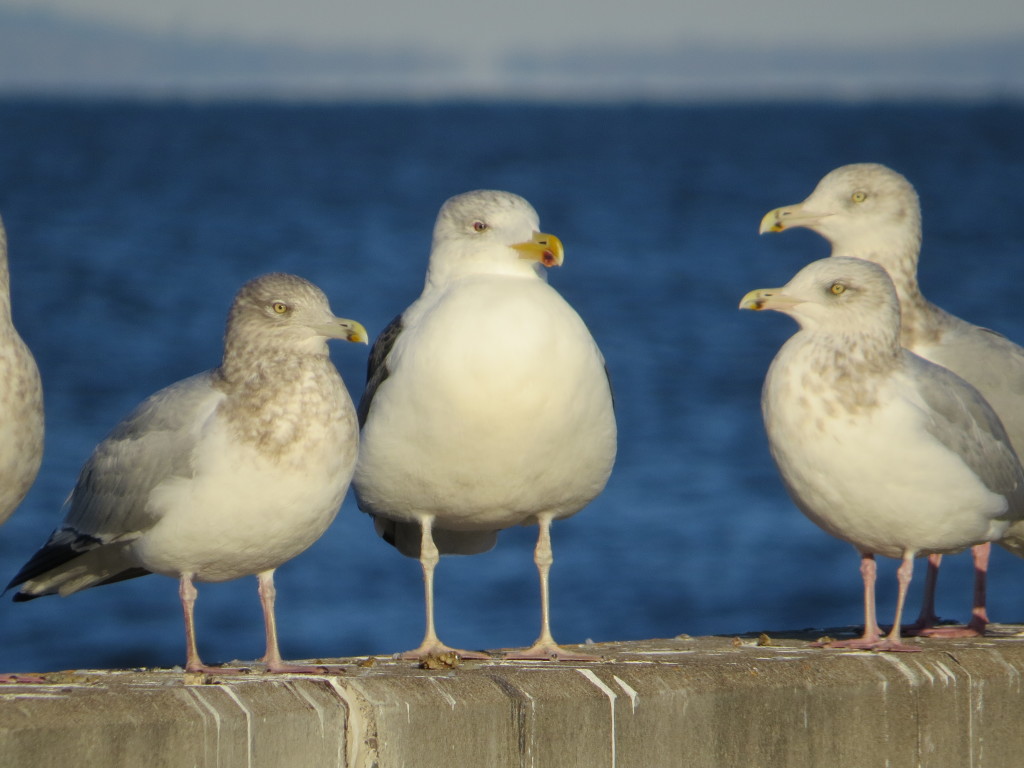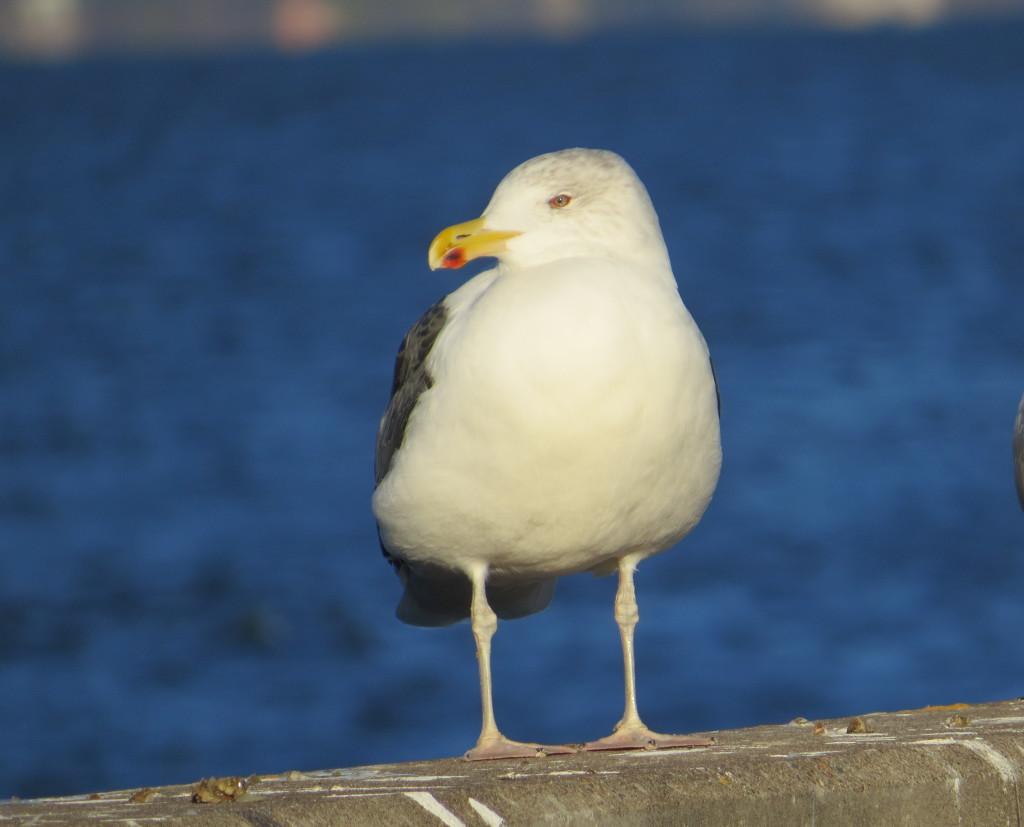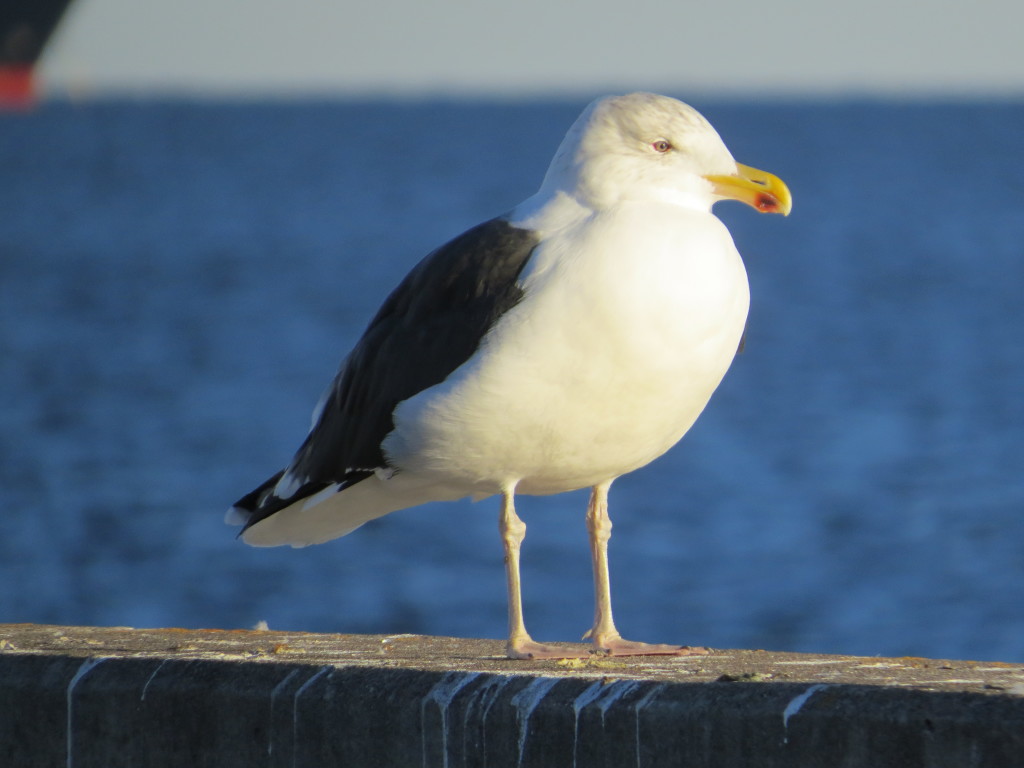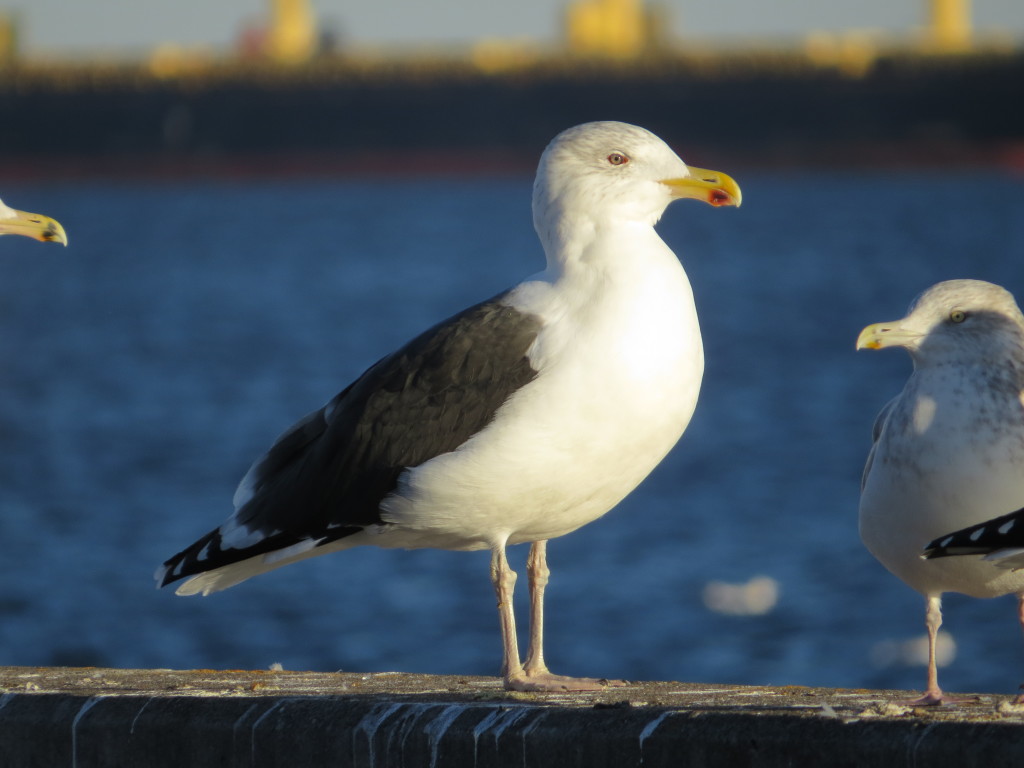Since Tommy DeBardeleben and Gordon Karre did not fly out of MSP until late in the evening on February 1st, we basically had most of the day to bird in the Northland and on our way south. And since we had knocked out their Owl targets the previous three days….
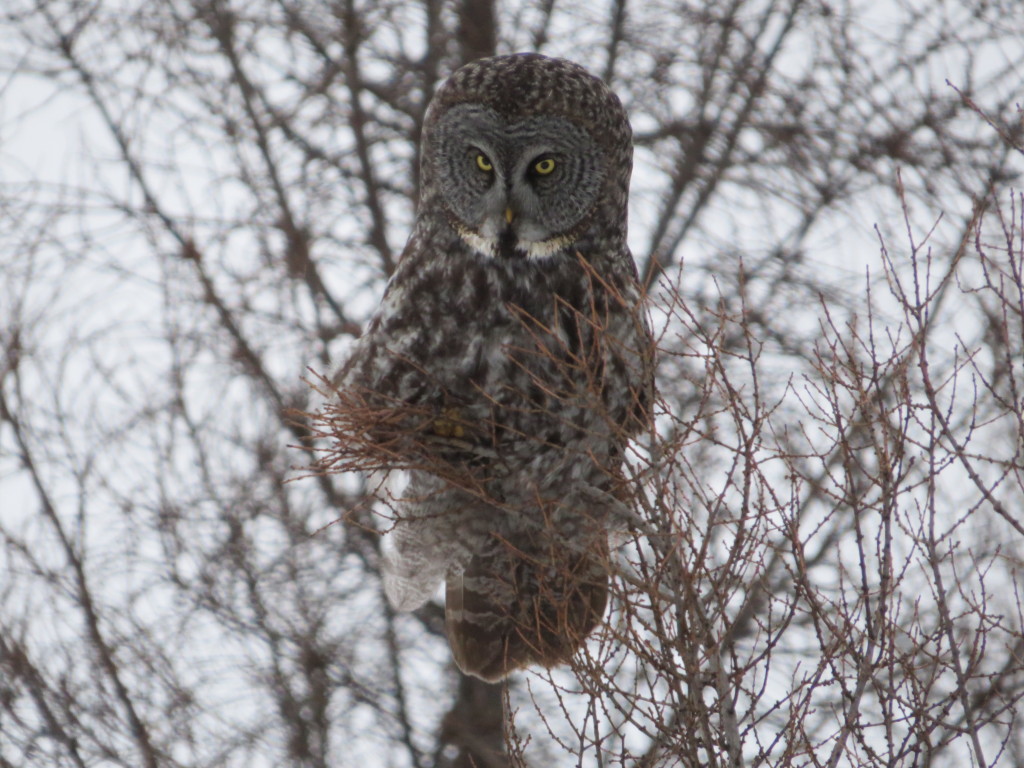
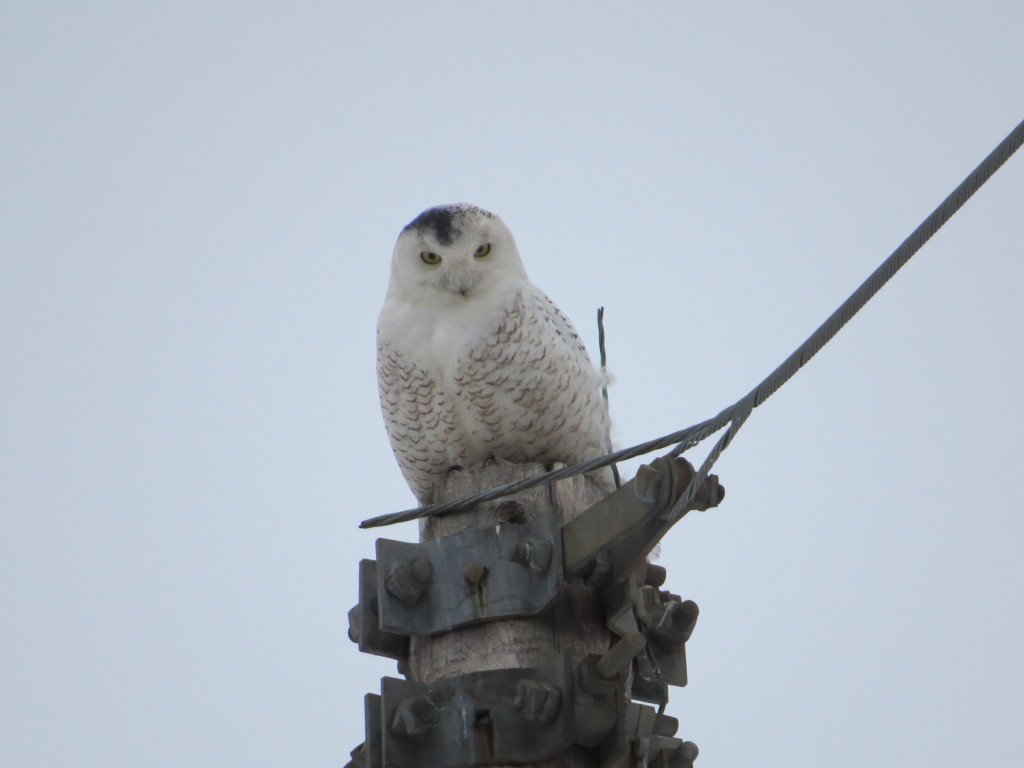
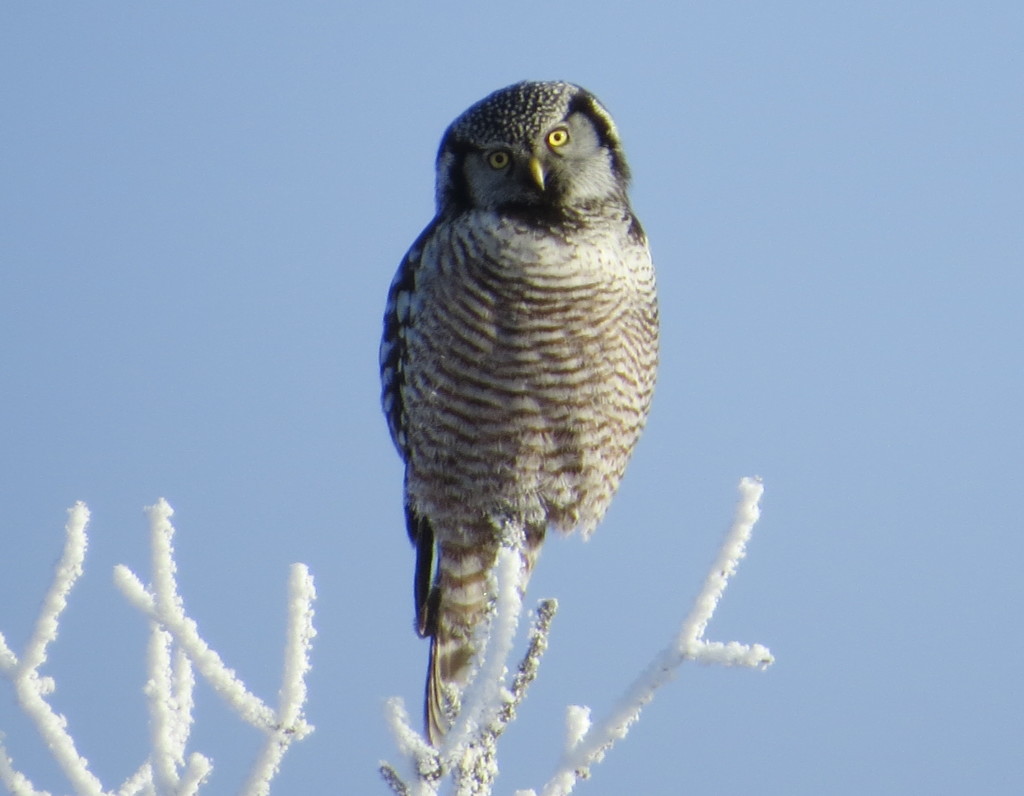
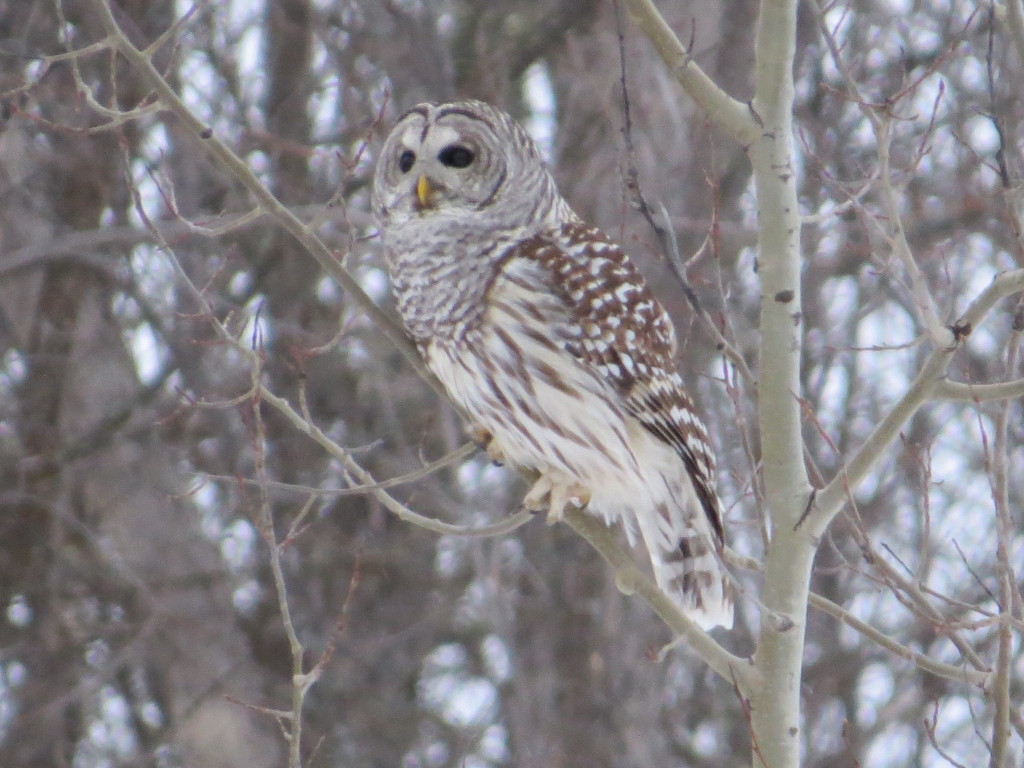
…we had a great deal of flexibility and freedom for how to bird on that final day. We had succeeded in our goals which I still find hard to believe even as I sit down to write this. There was zero pressure for that final day. Options on the table included going back for more Great Gray action in the Sax-Zim Bog, heading up to Lake County to try for Spruce Grouse, going to a birding friend’s yard to photograph Ruffed Grouse that frequent her feeders, or trying for a number of other Owls on our way south. Ultimately, though, we decided to bird much closer to our base camp. While we were on the Hawk Owl hunt in the Northwest the previous day, Evan had called me with a credible report of three Spruce Grouse seen on a road right near my parents’ house. Since I have seen Sprucies there in the past, I had no reason to doubt it. So that’s where we started our day. Evan was along with us as Marin and Melissa headed back home separately.
I was excited about birding around my parents’ house. First, it meant we could sleep in for once which felt great after the breakneck pace we’d been keeping. Second, and more important, I have tried for years for some really great birds that have been found on a road through a mature Black Spruce bog near the folks’ house. I had secured a nice male Spruce Grouse in this spot the previous year, but I have never given up searching for the Great Gray Owl and Black-backed Woodpecker that Sparky Stensaas discovered there over two years ago. I have lost track of how many times I have tried for these birds. These birds are pretty special anywhere, but even more so when they are in the backyard.
When we got to the Spruce bog and made one unsuccessful pass down the road for Sprucies, Great Grays, Boreal Chickadees, and Black-backs, Tommy suggested getting out of the car in order to walk and listen. It was a mild day, so I thought that was a good idea. Rather than joining them and having all of us have to walk back to the vehicle, I decided to stay in the car and go pick them up. Unannounced to them, I took off in a different direction in order to complete a large loop to cover more ground. Gordon later told me that when he saw me leave he had flashbacks of Snipe hunts from his youth. But I knew it wouldn’t be long and that they’d be okay. 🙂
Almost instantly on my solo tour I had a large gray and black raptor fly from a perch in the Pines on the right side of the road to a large stand of Pines on the left–adult Northern Goshawk! I wish I could have had a longer look, but such is the way NOGO sightings go. I finally did make it back to a frigid Tommy and Gordon (my loop took me longer than I thought–oops!). I asked the guys what they had seen, and Tommy told me they detected the drumming of a Black-backed Woodpecker. I’ve birded with Tommy enough to know that he can be a kidder and try to get one over on somebody, so I laughed and told him I knew better than to believe his story….except he didn’t break into a smile. He was serious! So I got out and we played the tape. Almost instantly the Black-backed Woodpecker flew out of the bog and finally gave me the sighting I’ve been waiting on for years! Even better was that this was a lifer for both Gordon and Evan!! It was a great moment that wouldn’t have been possible without Tommy and Gordon walking–thanks guys! This one felt really, really good.
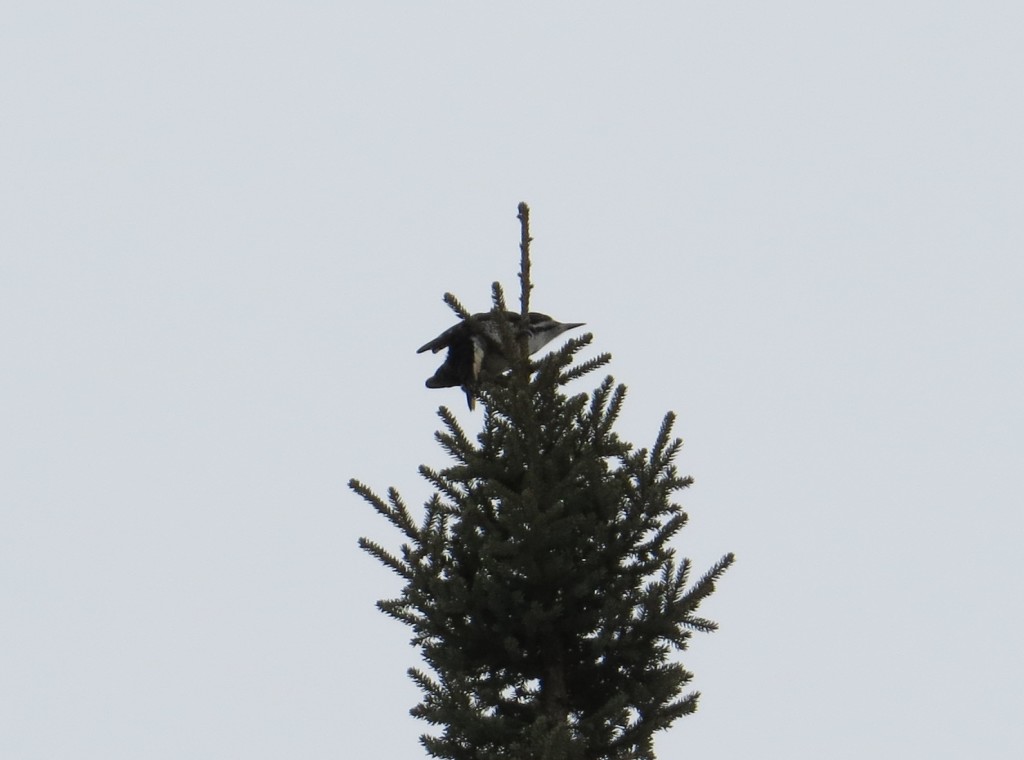 Something even more amazing happened while we tried to lure out this guy–a second Black-back showed up! There was a male and a female! Unfortunately I never did see that classic field mark of the yellow crown on the male, but Tommy and Gordon each got to see it. I will continue to search for these birds until I finally see that and finally get good photos of this species.
Something even more amazing happened while we tried to lure out this guy–a second Black-back showed up! There was a male and a female! Unfortunately I never did see that classic field mark of the yellow crown on the male, but Tommy and Gordon each got to see it. I will continue to search for these birds until I finally see that and finally get good photos of this species.
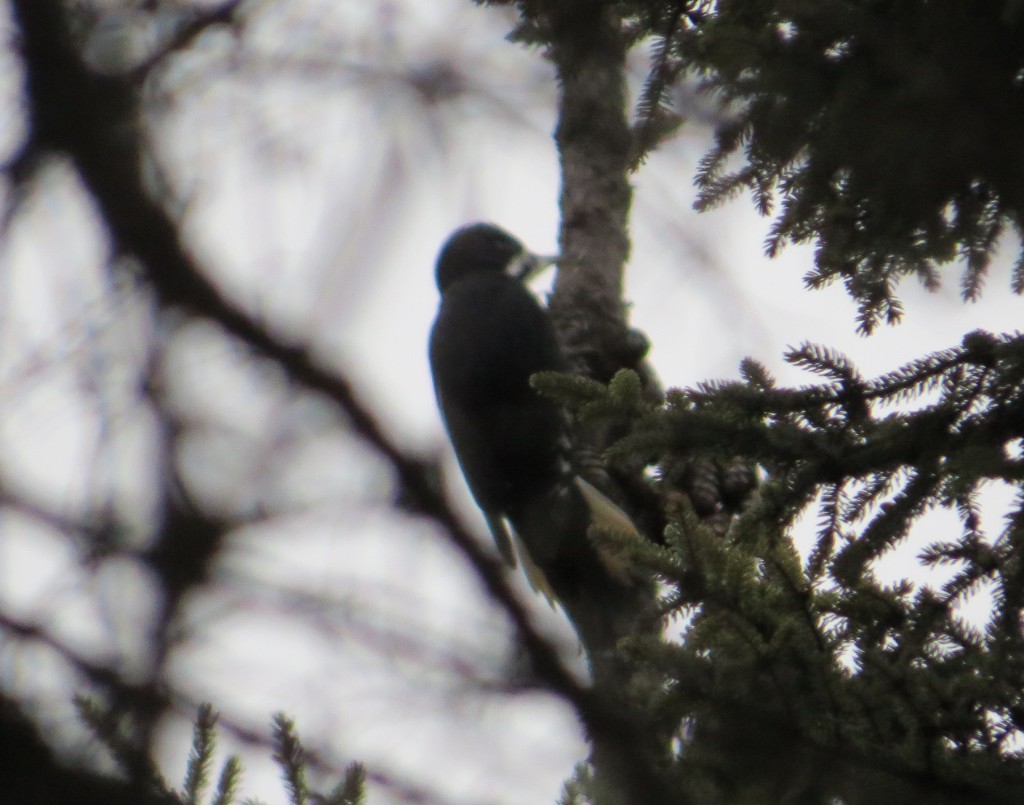
We had a pretty tight schedule to keep for some more birding stops on the way to the Cities, so we had to leave this special bog by 9:30. The rest of the day had various stops for various things as we ventured south. We tried for a Northern Saw-whet Owl that would have been a lifer for me if we would have found it. We did not, however. This was my second attempt, and I’ve since made an unsuccessful third attempt. It is just not meant to be at this point in time.
As we traveled we did get to see a couple more Pileated Woodpeckers, including one close up on a power pole. Getting photos of this bird was another story, but the sightings were still exciting for the guys. Tommy was able to finally get a Blue Jay photo which was a photographic lifer for him. We did bump into an unexpected but not surprising Red-bellied Woodpecker in a suburban neighborhood which was a lifer for Tommy! No one was able to get photos of this striking bird. The one pictured below is one I recently photographed in my yard.
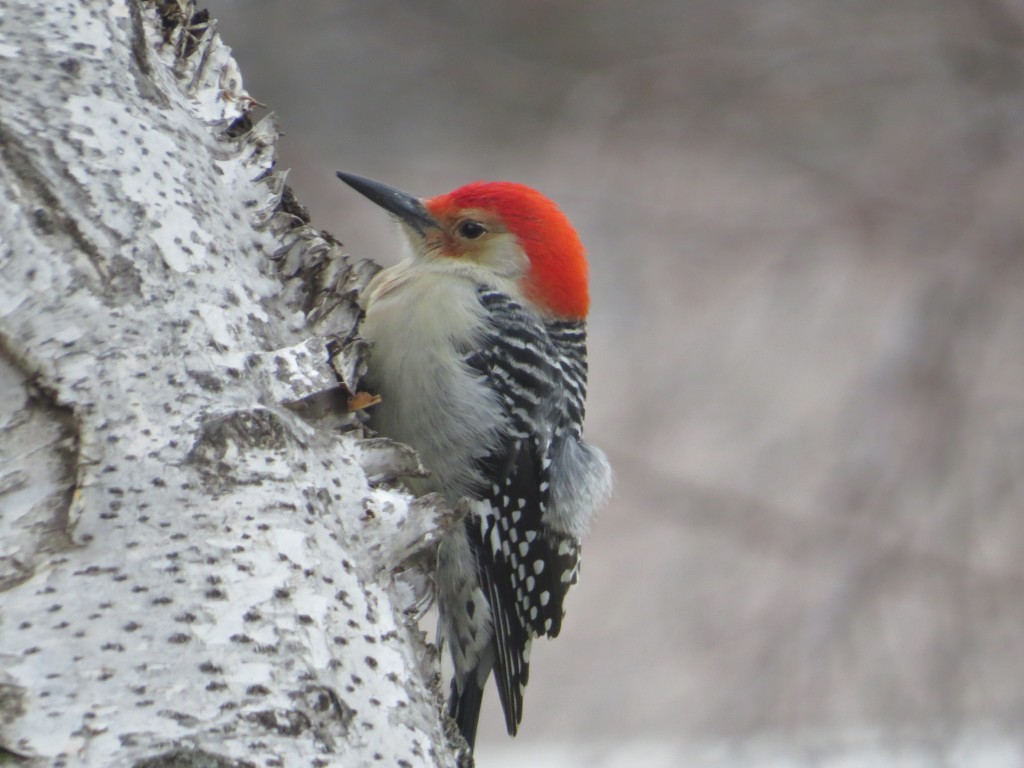
We had a couple of revenge stops to make right by the airport itself. When I picked the guys up late in the afternoon on January 28th, we had about 20 minutes of daylight to search for the Ft. Snelling State Park Barred Owl which is a 5-minute drive from Terminal 1. Not being successful there on that first night, we quickly got over to the aircraft viewing area on Cargo Road just as it was getting dark to look for a reported Snowy Owl. No luck on that one either. Even though Tommy and Gordon got their Snowy and Barred Owl lifers, we all wanted revenge on these particular Owls, especially the Barreds which NOBODY misses on. Anyhow, we were all optimistic and relaxed on this second attempt.
As we were driving into Ft. Snelling State Park, Evan casually mentioned seeing some Trumpeter Swans. This immediately caught Gordon’s attention who informed us that would be a lifer for him! Evan’s eagle-eye had come up with a lifer that wasn’t even on my radar. Tommy was also excited about this sighting as it was the first time he had seen adult birds and only his second time viewing the species. Way to go, Evan!
We also redeemed our failure from the previous night when Tommy spotted the female Barred Owl. The guys enjoyed getting another chance at photographing a more cooperative Barred Owl.
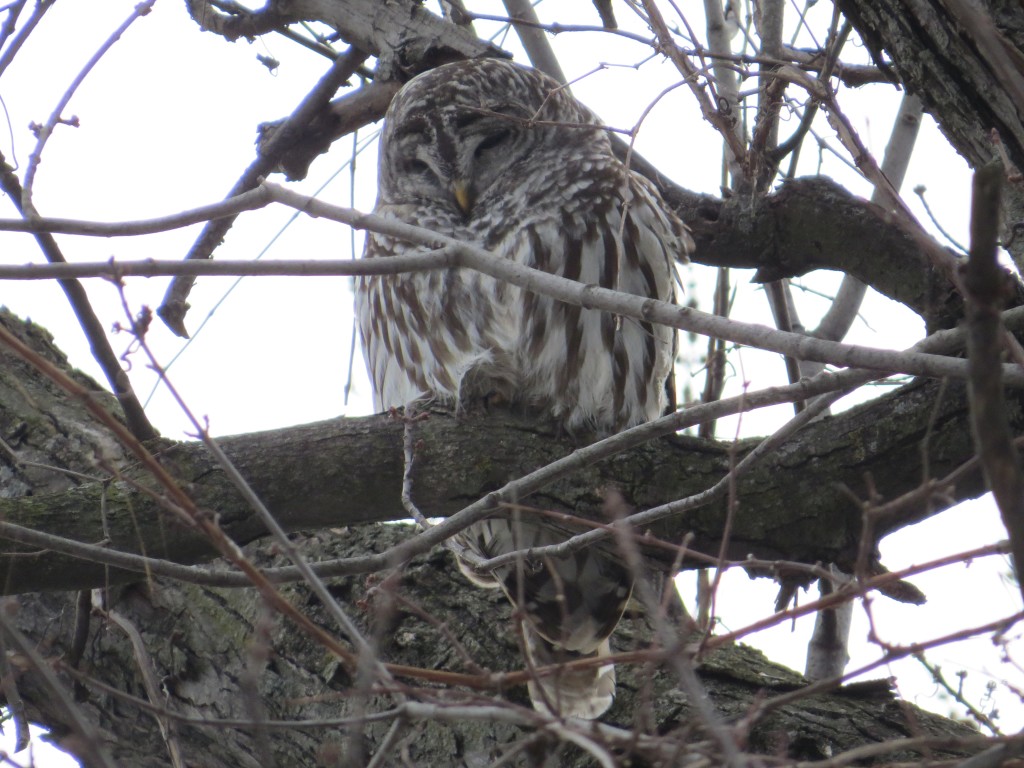
Because we found the Barred in such short order, I told the guys I had enough time to make one quick check for the airport Snowy Owl before I had to hit the road. When I asked them if they were interested in looking, they responded with an emphatic yes.
Driving down Cargo Road we did not spot the bird on any of the perches on which it had been seen recently, like the FedEx building. It turns out that this bird does not play favorites, though, as I spotted it way in the distance on top of the UPS depot as we drove back out from the aircraft viewing area.
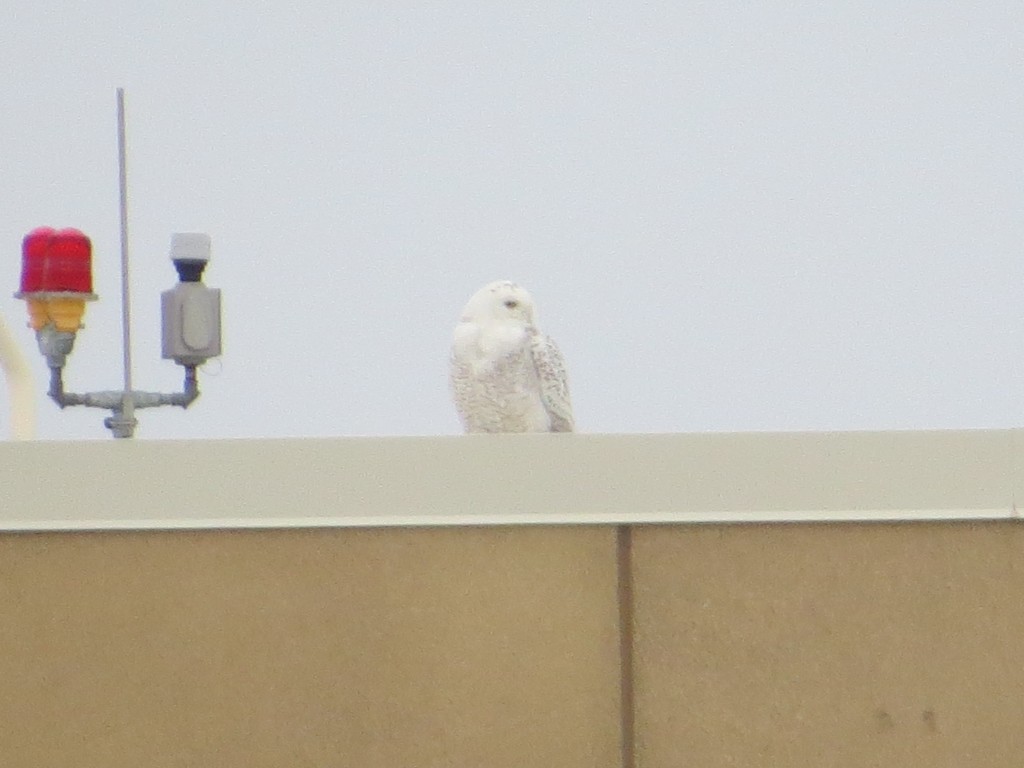
Afterwards, we took the guys to the terminal, said a hasty goodbye, and vowed to go birding again together either here or in Arizona. It was a great last day of birding that added its own unique excitement to a truly epic trip. Here is the summary of day 4’s life birds for Tommy and Gordon.
Black-backed Woodpecker – Gordon, Evan
Red-bellied Woodpecker – Tommy
Trumpeter Swan – Gordon
Trip Analysis
This trip was unforgettable, no unbelievable. It was simply magic, even for me. Though I have seen all of these birds many times, the fact that we saw so many good birds in such a short period of time makes this trip rival some of my out-of-state trips where I have gotten lifers. I enjoy birding northern Minnesota more than anywhere, and I never get tired of its special birds, especially those Owls. It was a thrill to be able to help Gordon and Tommy see them for the first time. To end this trip series, I’d like to point out some fun factoids.
Tommy and Gordon got their three main targets in this order: Great Gray Owl, Snowy Owl, Northern Hawk Owl. For those who are not fans of permutations, there are exactly six orders that this could have happened. Coincidentally I saw those same lifers in that same order.
The number of individuals we saw of these three Owl species made for a nice arithmetic sequence:
Great Gray Owl – 1
Northern Hawk Owl – 2
Snowy Owl – 3
Tommy and Gordon saw the Northern Big 3 on three consecutive days. That is substantially faster than I did it (nearly a year), even after making several northern trips. Here are the dates that I got my lifers.
Great Gray Owl — March 13, 2013
Snowy Owl — December 3, 2013
Northern Hawk Owl — December 26, 2013
Before this trip, I had (surprisingly) seen more Owl species than Tommy. He had 13; I had 14. Now, though, Tommy has 17. Of the 19 regularly occurring Owl species in North America, he is only missing Boreal Owl and Eastern-Screech Owl, both of which reside in Minnesota. I’m trying to convince him that he should get them here, especially since I need one of those as well. After all, how cool would it be to say you got all of North America’s Owls in just two states?
Speaking of Owl lifers, Tommy and I split the work of spotting their four lifers. Never mind how many more Owls Tommy found overall!
Great Gray Owl – Tommy
Snowy Owl – Tommy
Northern Hawk Owl – Josh
Barred Owl – Josh
Overall, Tommy ended the trip with 15 life birds and Gordon had 18. That is a whopping number, especially when I have only seen 60 species total in Minnesota for 2016.
Tommy and Gordon saw a LOT of GOOD birds in a SHORT amount of time. Below I’ve listed the most difficult species they saw on this four-day trip along with the dates that I got my lifer for each to give some perspective as to how good of a trip they had. As you will see, it’s taken me a long time to get these key birds after many, many trips to the north. I’ll start with my most recent lifers.
Great Black-backed Gull — November 28, 2015
Iceland Gull — November 28, 2015
Glaucous Gull — November 28, 2015
Black-backed Woodpecker — June 22, 2015
Gyrfalcon — March 8, 2015
Thayer’s Gull — November 8, 2014
Boreal Chickadee — December 28, 2013
Northern Hawk Owl — December 26, 2013
Snowy Owl — December 3, 2013
Great Gray Owl — March 13, 2013
Favorite Sighting of the Trip: Black-backed Woodpecker
Favorite Personal Find of the Trip: Barred Owl just south of the Canadian border
Best Overall Bird Experience: Hanging with the Northern Hawk Owl in the Beltrami Island State Forest
Biggest Relief of the Trip: Getting the Great Gray immediately
Biggest Stressor of the Trip: Driving in reverse for 3.6 miles on the Pitt Grade Road Snowmobile Trail in a mini-van
Biggest Miss of the Trip: American Black Duck
Thank You!
This trip’s success is only because so many great Minnesota birders and non-birders made it happen. Therefore I’d like to acknowledge those folks.
Clinton Nienhaus – For all his Sax-Zim Bog advice on the Bog’s birds and their habits. Additionally, Clinton spotted the guys’ Glaucous Gull lifer at Canal Park.
Jason Mandich – For his SZ Bog advice and extra set of eyes in the Bog.
Jeff Grotte – For his Owling advice that made for an incredible final day of Owling in the Twin Cities.
Peder Svingen – For his Gull identification counseling and superior Superior Snowy Owl tips.
Randy Frederickson – For giving us timely heads-up texts on the Iceland and Great Black-backed Gulls.
John Richardson – For being an extra set of eyes at Canal Park, wearing his trademark Union Jack stocking cap, and bringing his British cheer to the Canal Park Gull party.
Kim Risen – For pointing out a bonus Snowy Owl in Superior.
Sandy Aubol – For her Northern Hawk Owl advice in Roseau County.
Evan – For always having an eagle-eye that ended up getting Gordon a bonus, unexpected Trumpeter Swan lifer.
Mom and Dad – For the generous use of their home and vehicle for our epic birding odyssey.
Melissa – For her enthusiastic support of this trip that kept me away from the family for so long.
Hungry For More?
Me too! This past weekend I worked as a guide at the annual Sax-Zim Bog Birding Festival. Later this week look for a write-up and photos of more great northern Minnesota birds from that trip!
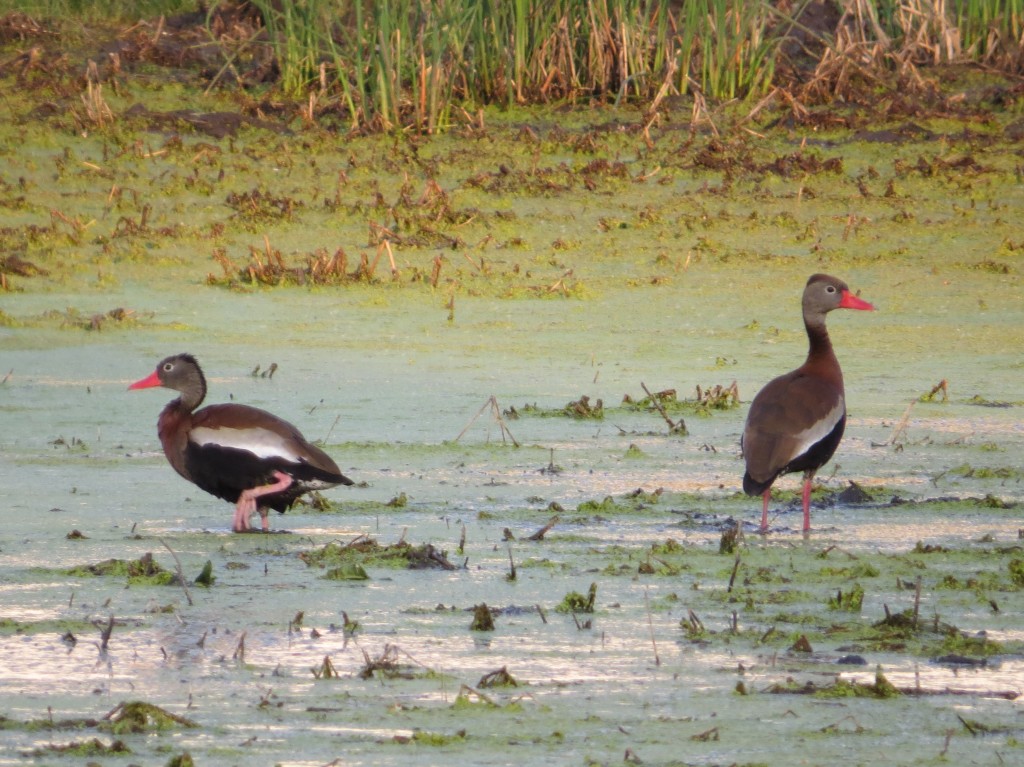 This was a lifer for me and a state bird for Randy. Technically Evan and I have seen this duck before–we once spotted a pair in a monkey exhibit at the Phoenix Zoo. However, the docent told us they had their wings clipped and of course did not “count”. That sighting was good enough for Evan but not me. I did try for some wild ones last year in Rio Rico, AZ but came up empty. Black-bellied Whistling-Ducks are mostly found in Texas and limited parts of Arizona and Florida but occasionally stray into the Midwest. It was a nice treat to see them right here at home.
This was a lifer for me and a state bird for Randy. Technically Evan and I have seen this duck before–we once spotted a pair in a monkey exhibit at the Phoenix Zoo. However, the docent told us they had their wings clipped and of course did not “count”. That sighting was good enough for Evan but not me. I did try for some wild ones last year in Rio Rico, AZ but came up empty. Black-bellied Whistling-Ducks are mostly found in Texas and limited parts of Arizona and Florida but occasionally stray into the Midwest. It was a nice treat to see them right here at home.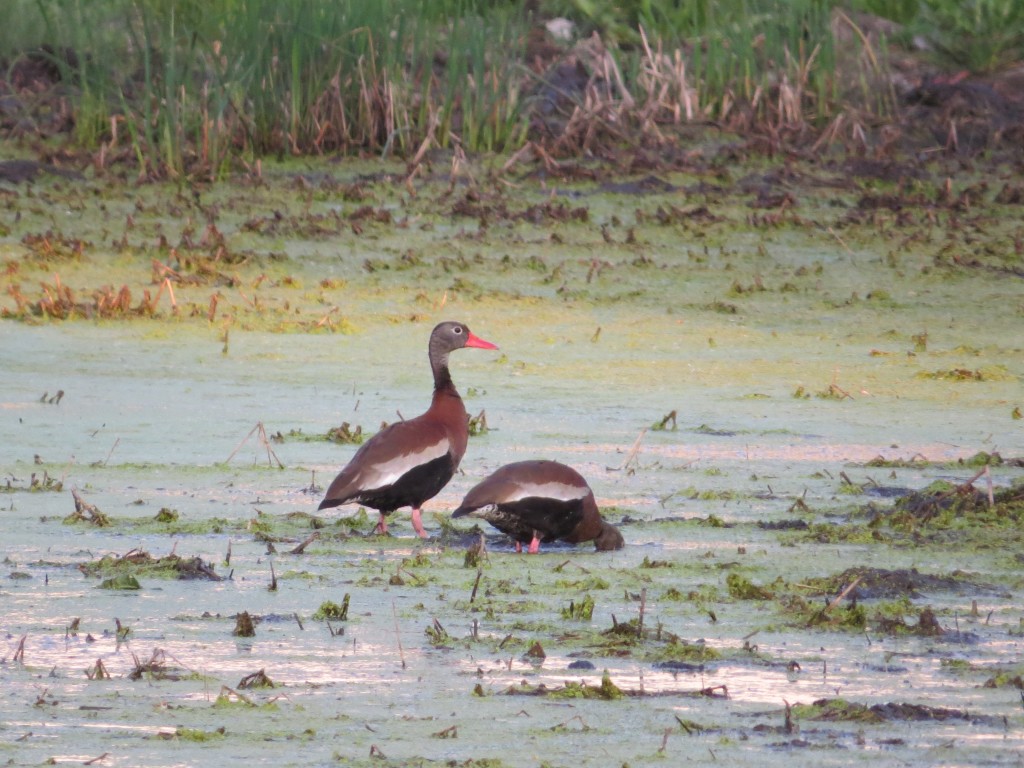
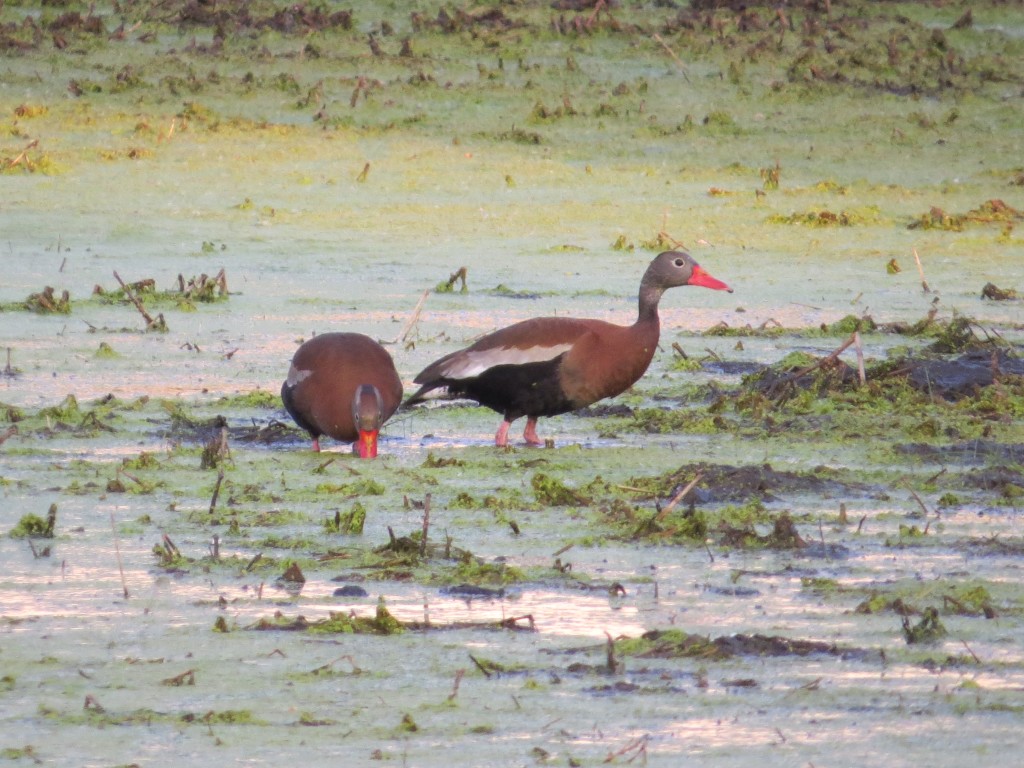
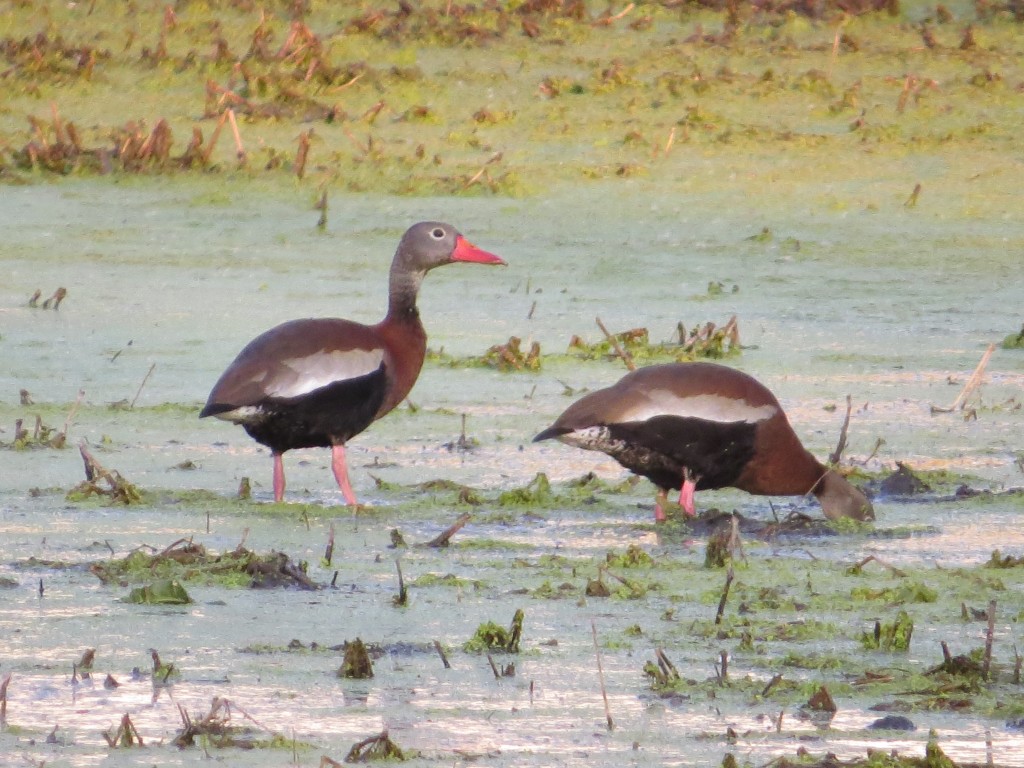
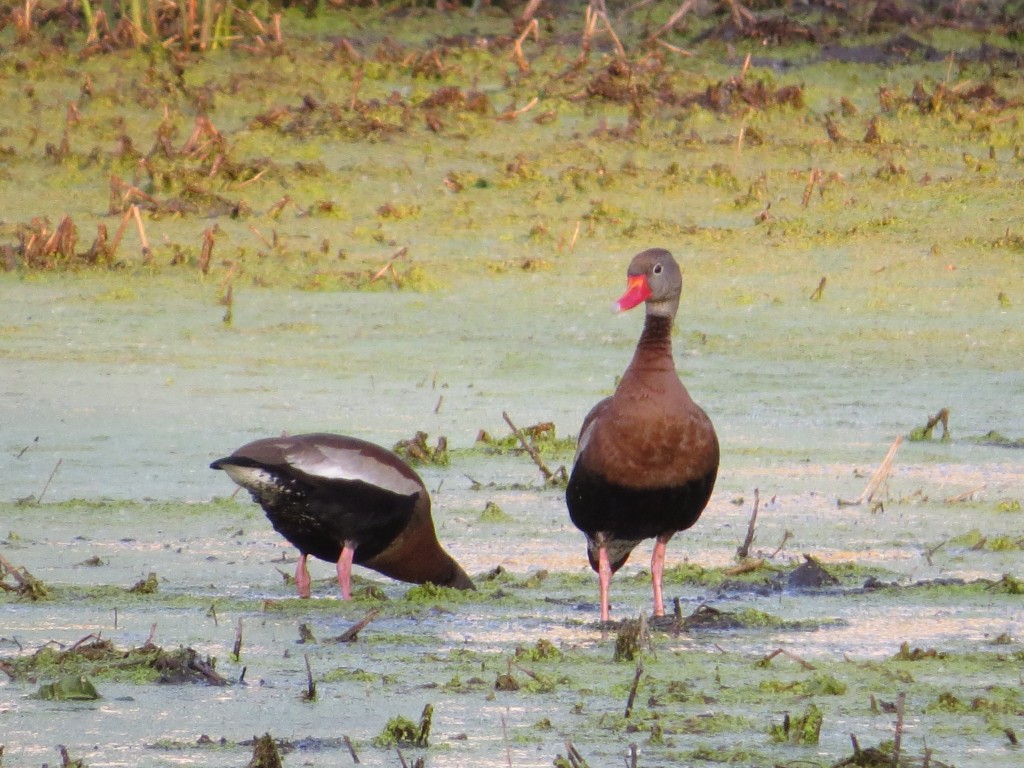 While many of the regular migrants have been AWOL or shown up in pathetic numbers, I don’t recall a better spring for figurative and literal odd ducks. While I have gotten some nifty additions to my life list this spring, the misses have numerous and sometimes painful. Nevertheless, I’ll enjoy the gifts I get. What’s next?
While many of the regular migrants have been AWOL or shown up in pathetic numbers, I don’t recall a better spring for figurative and literal odd ducks. While I have gotten some nifty additions to my life list this spring, the misses have numerous and sometimes painful. Nevertheless, I’ll enjoy the gifts I get. What’s next?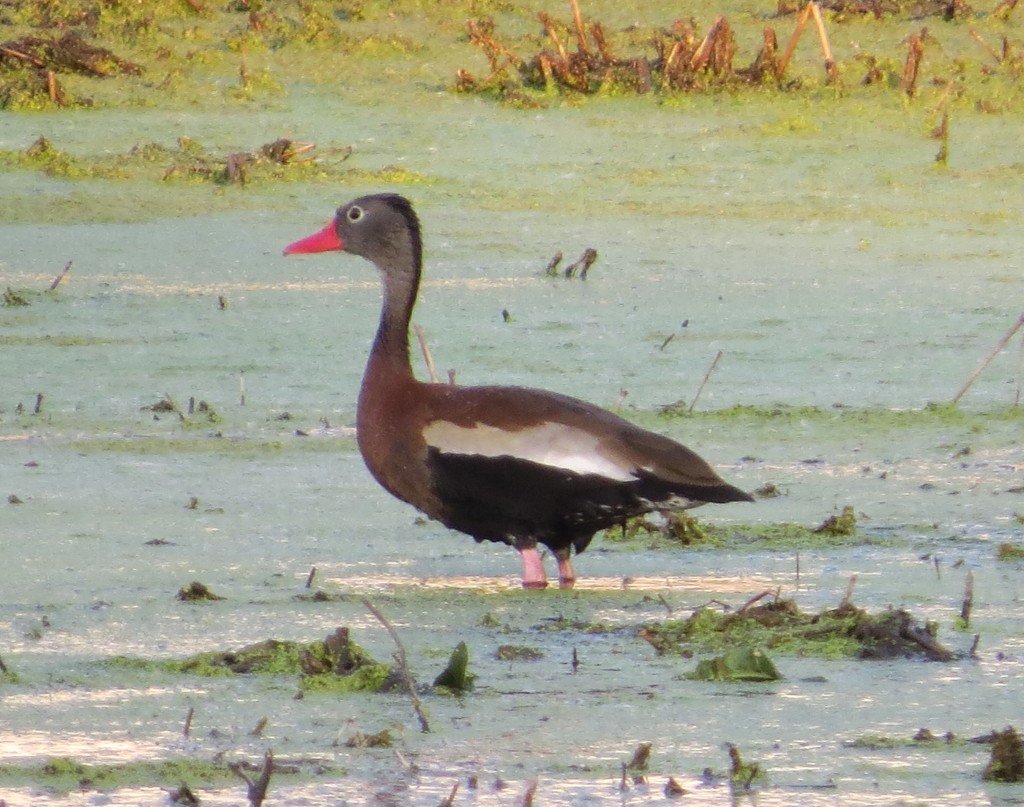

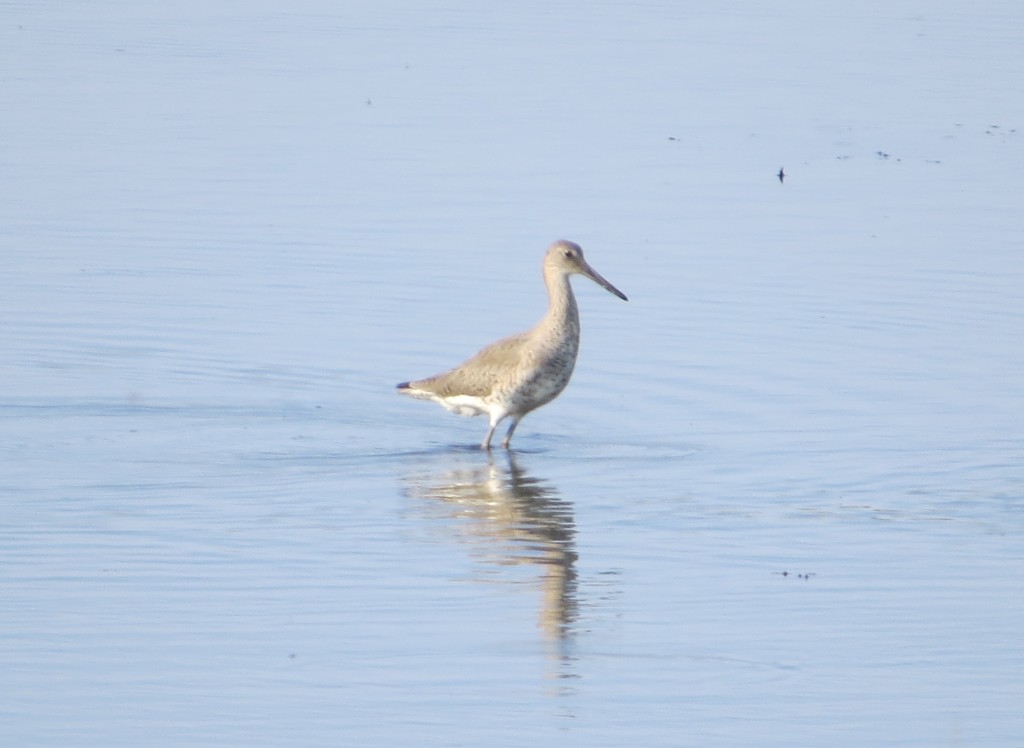
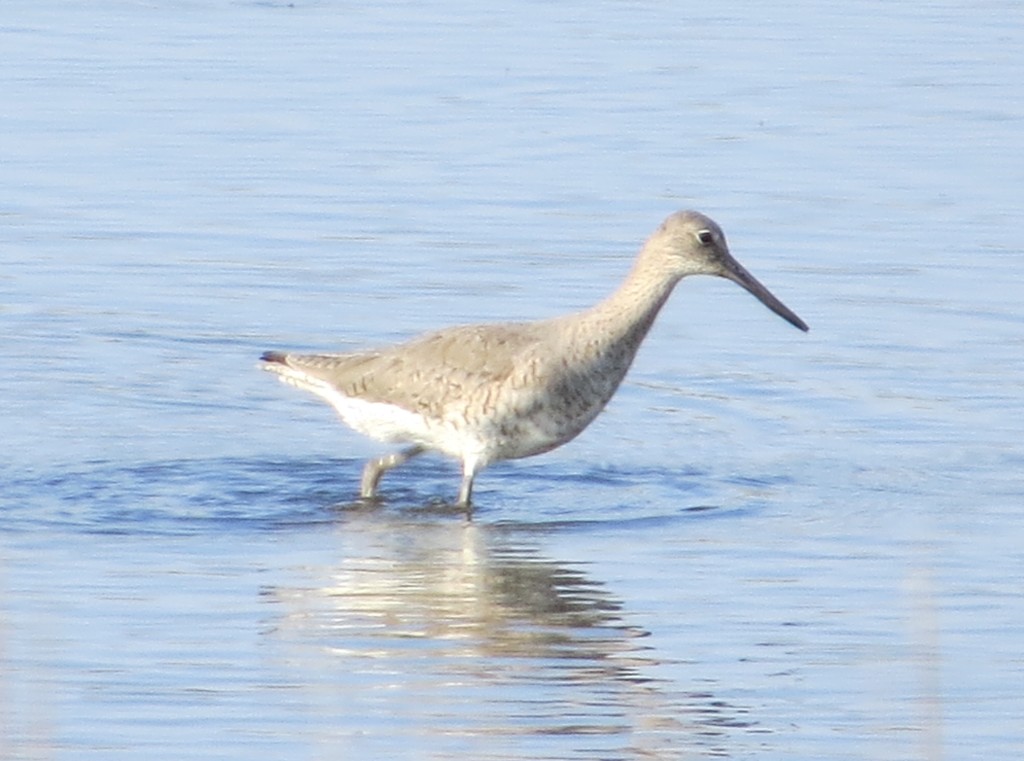 To a non-birder this is pretty drab bird, but it can be quite flashy when it flies revealing a striking white and black pattern. I watched the bird for over a half hour hoping to catch a glimpse of it flying, but it never did. Eventually I had to get back to the house. Flashy wings or not, the Willet never fails to impress Minnesota birders because it is such an uncommon migrant. As such I posted Joel’s sighting on FB. I love posting birds like this because we are such an underbirded county–good birds may attract a few visitors who in turn could find something great in the home county.
To a non-birder this is pretty drab bird, but it can be quite flashy when it flies revealing a striking white and black pattern. I watched the bird for over a half hour hoping to catch a glimpse of it flying, but it never did. Eventually I had to get back to the house. Flashy wings or not, the Willet never fails to impress Minnesota birders because it is such an uncommon migrant. As such I posted Joel’s sighting on FB. I love posting birds like this because we are such an underbirded county–good birds may attract a few visitors who in turn could find something great in the home county.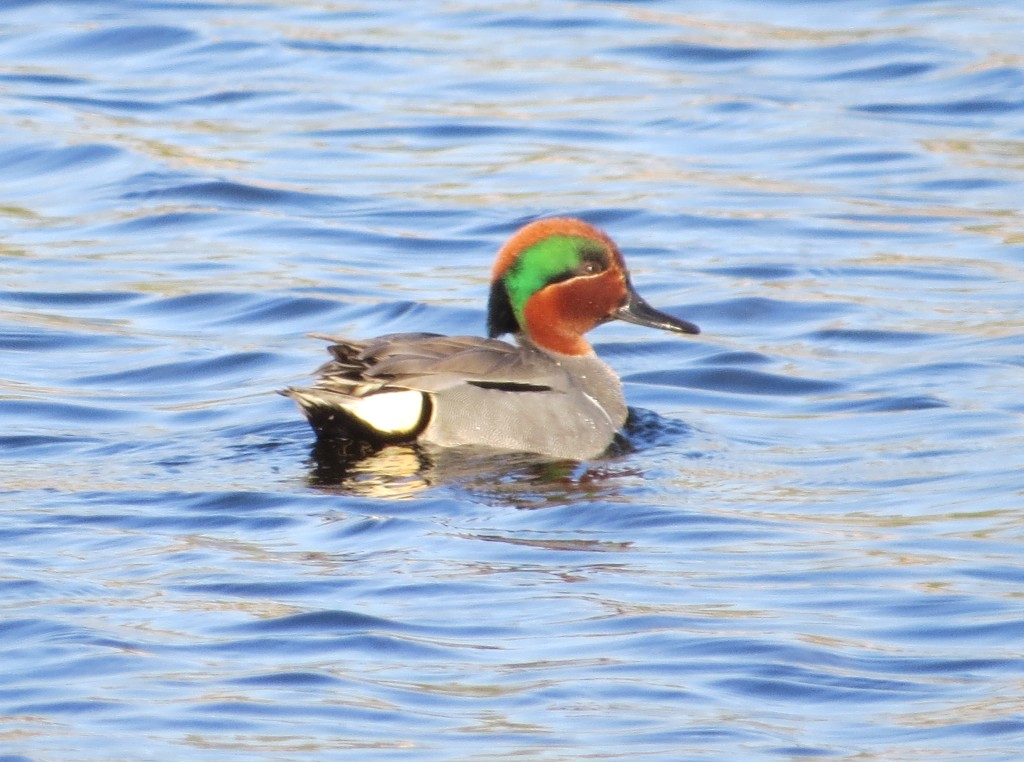
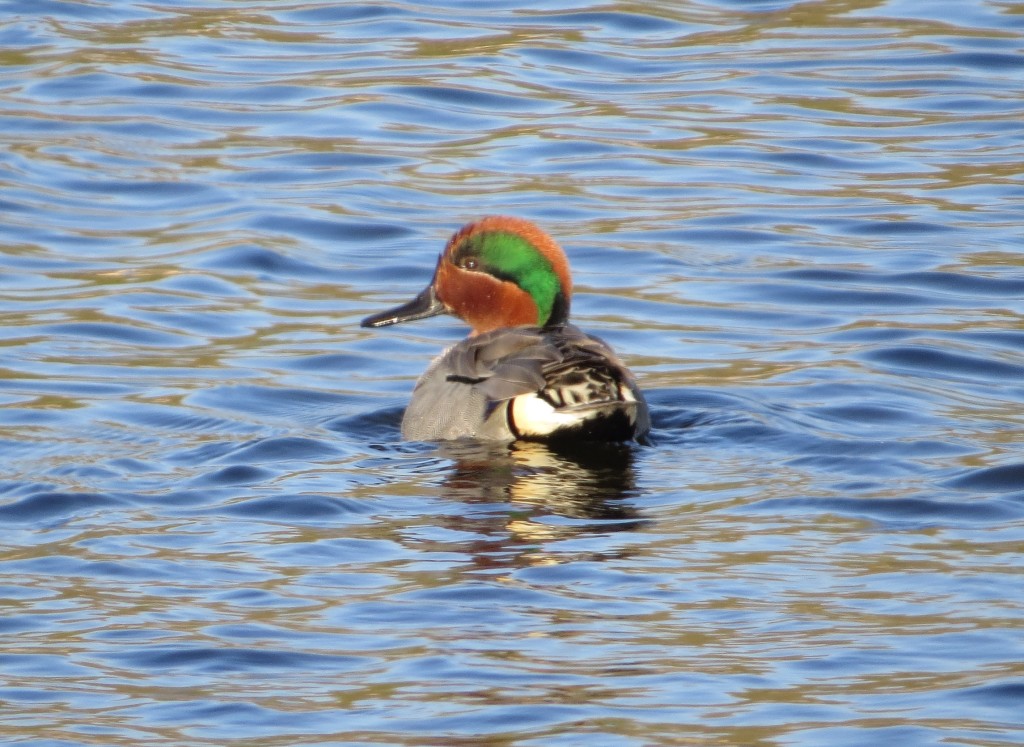 As I was Teal-gazing, though, someone answered the Willet ad in the classifieds. Visiting birder Brad Abendroth struck out on the Willet but instead discovered a whopping 23 American Avocets at that pond!
As I was Teal-gazing, though, someone answered the Willet ad in the classifieds. Visiting birder Brad Abendroth struck out on the Willet but instead discovered a whopping 23 American Avocets at that pond!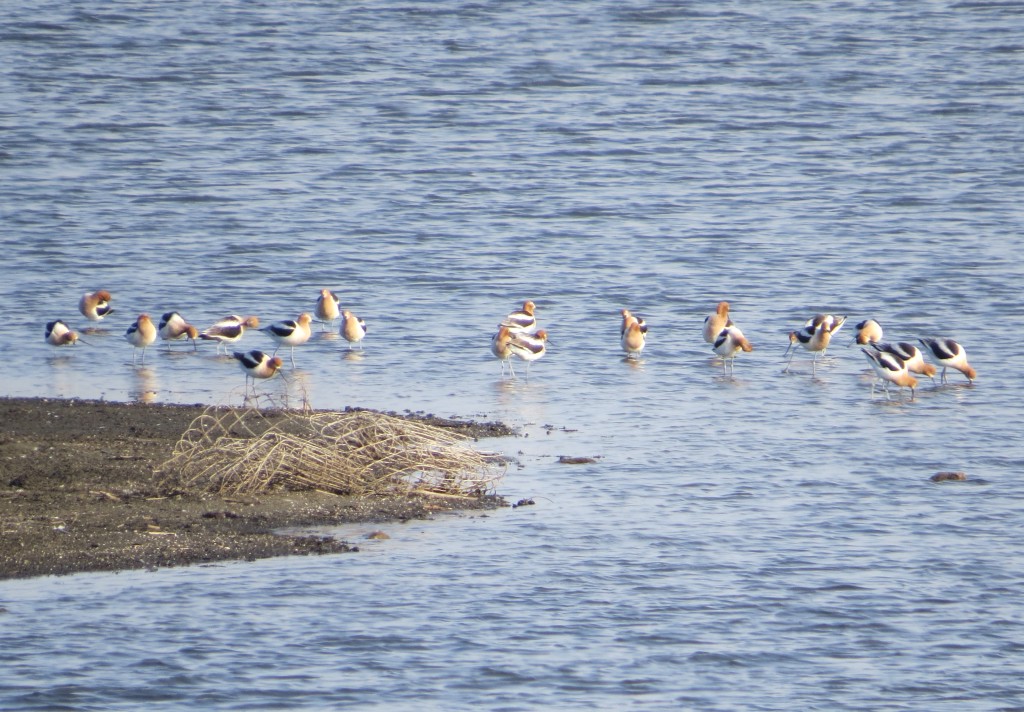 The birding fun doesn’t end there. Later in the day I took the kids on a short hike at my Gray Partridge spot. As we walked a fence-line in 20 mph winds we got lucky and kicked up a single Gray Partridge from just 2 feet away! It startled Marin pretty good; she wanted to walk behind me after that. Evan enjoyed seeing this lifer. Based on the deep rusty color of the outer tail feathers, it must have been a male. When I saw the two the other day, one had bright rusty outer tail feathers like this and the other had lighter-colored ones, possibly indicating a pair. If that’s the case, perhaps the female we didn’t see today was sitting tight on a nest. We can only hope.
The birding fun doesn’t end there. Later in the day I took the kids on a short hike at my Gray Partridge spot. As we walked a fence-line in 20 mph winds we got lucky and kicked up a single Gray Partridge from just 2 feet away! It startled Marin pretty good; she wanted to walk behind me after that. Evan enjoyed seeing this lifer. Based on the deep rusty color of the outer tail feathers, it must have been a male. When I saw the two the other day, one had bright rusty outer tail feathers like this and the other had lighter-colored ones, possibly indicating a pair. If that’s the case, perhaps the female we didn’t see today was sitting tight on a nest. We can only hope.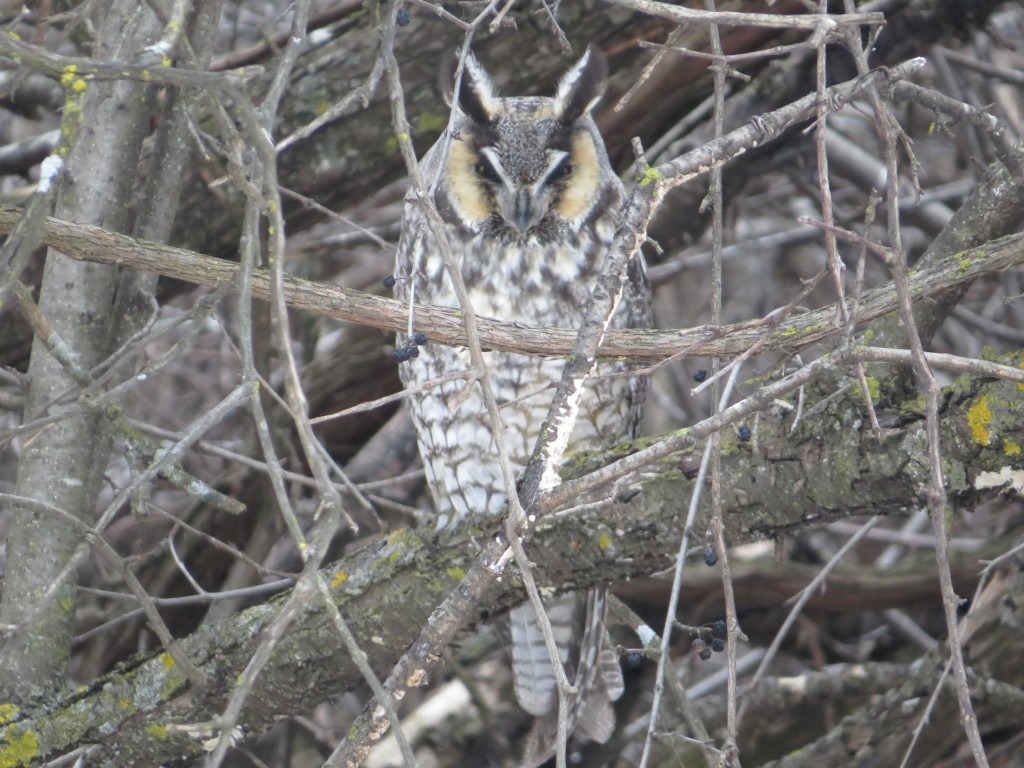 So the Long-eared got Evan caught up with me on Owls at 14 Species. Then there was that Northern Saw-whet I went to see, which for reasons I still cannot figure out, Evan opted out of that easy, guaranteed, short chase and instead went to his sister’s dance practice. Once again the Owl numbers were askew. However, our whole family recently made a stop at the Saw-whet location so my coworker, Brad, could collect the pellets for some science students to dissect. Evan got his lifer and tied me once again. A bonus was that we saw it with an un-pelletized deer mouse.
So the Long-eared got Evan caught up with me on Owls at 14 Species. Then there was that Northern Saw-whet I went to see, which for reasons I still cannot figure out, Evan opted out of that easy, guaranteed, short chase and instead went to his sister’s dance practice. Once again the Owl numbers were askew. However, our whole family recently made a stop at the Saw-whet location so my coworker, Brad, could collect the pellets for some science students to dissect. Evan got his lifer and tied me once again. A bonus was that we saw it with an un-pelletized deer mouse.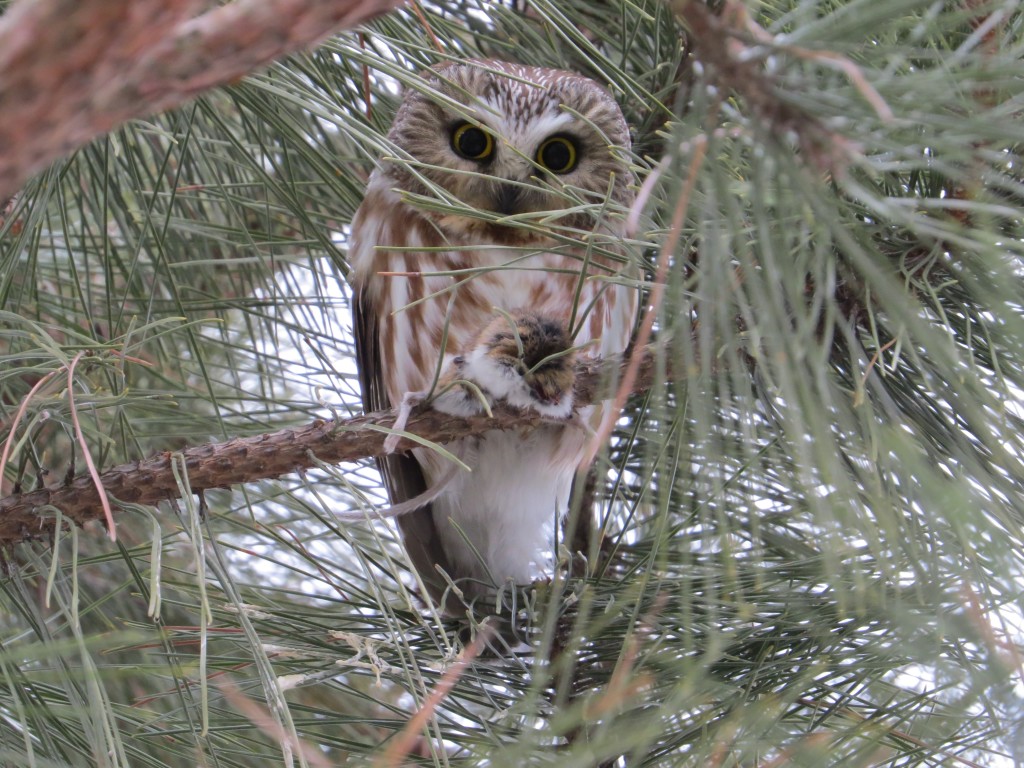 Evan and I both now stand at 15 Owl species apiece. Here are the species we have seen listed in the order that Evan saw them:
Evan and I both now stand at 15 Owl species apiece. Here are the species we have seen listed in the order that Evan saw them: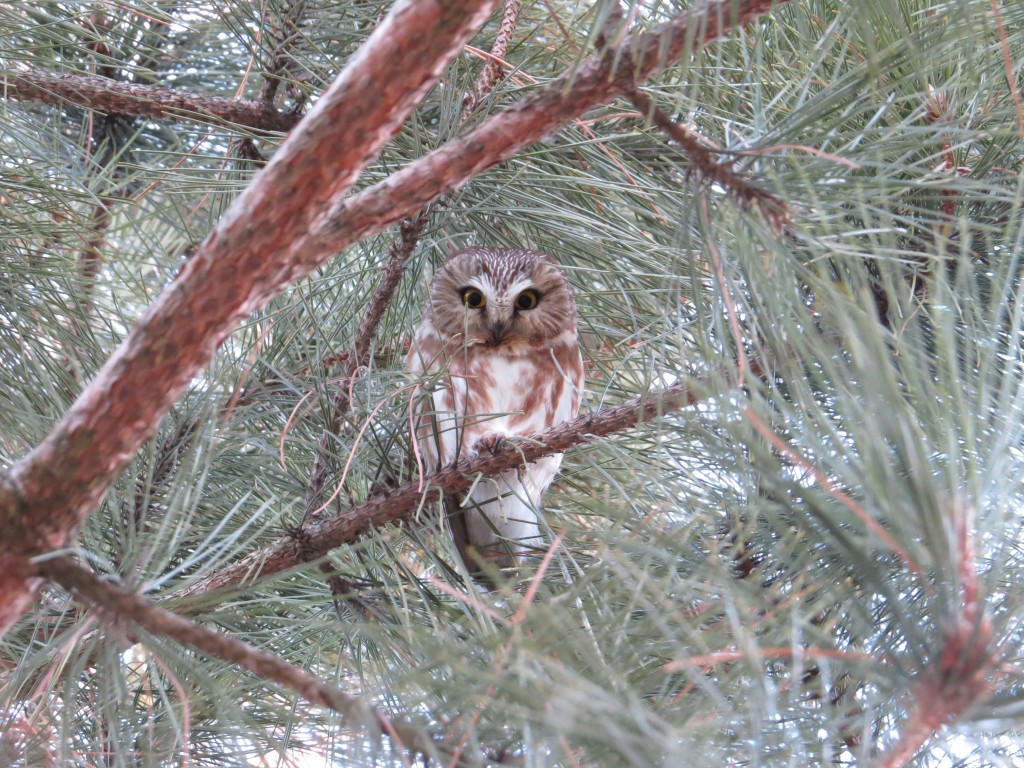 The Saw-whet is not much bigger than a pop can. I don’t think I’ve seen an animal that’s cuter. Jeremy’s friends pinpointed it for us right away. That was probably a good thing…
The Saw-whet is not much bigger than a pop can. I don’t think I’ve seen an animal that’s cuter. Jeremy’s friends pinpointed it for us right away. That was probably a good thing…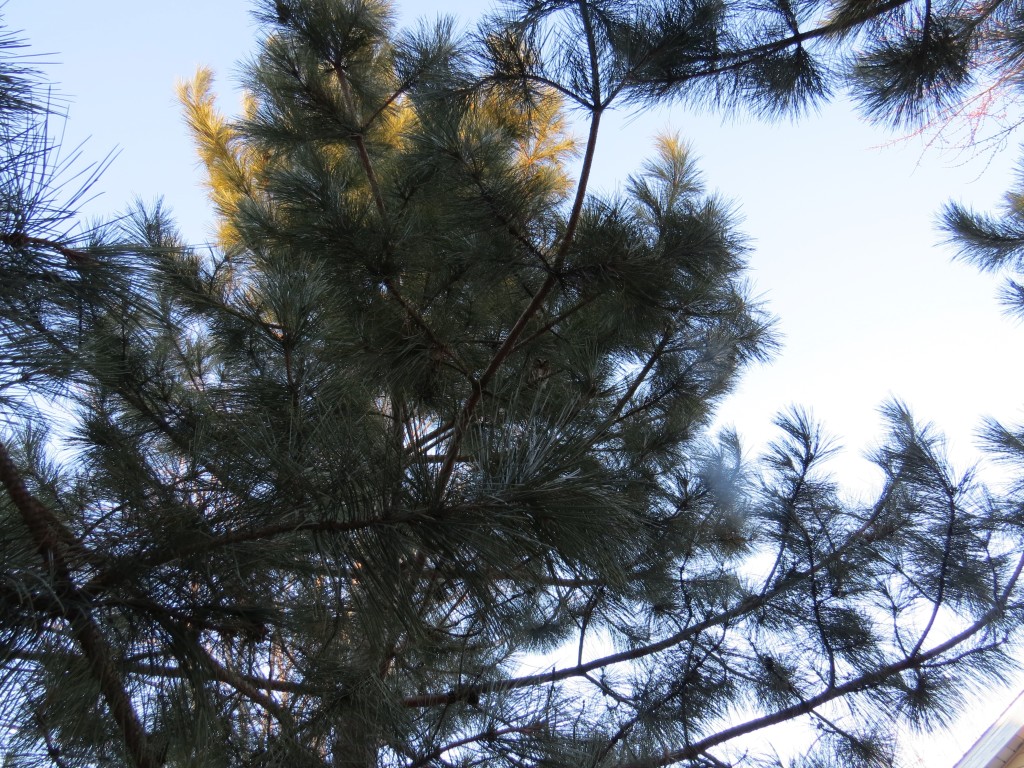
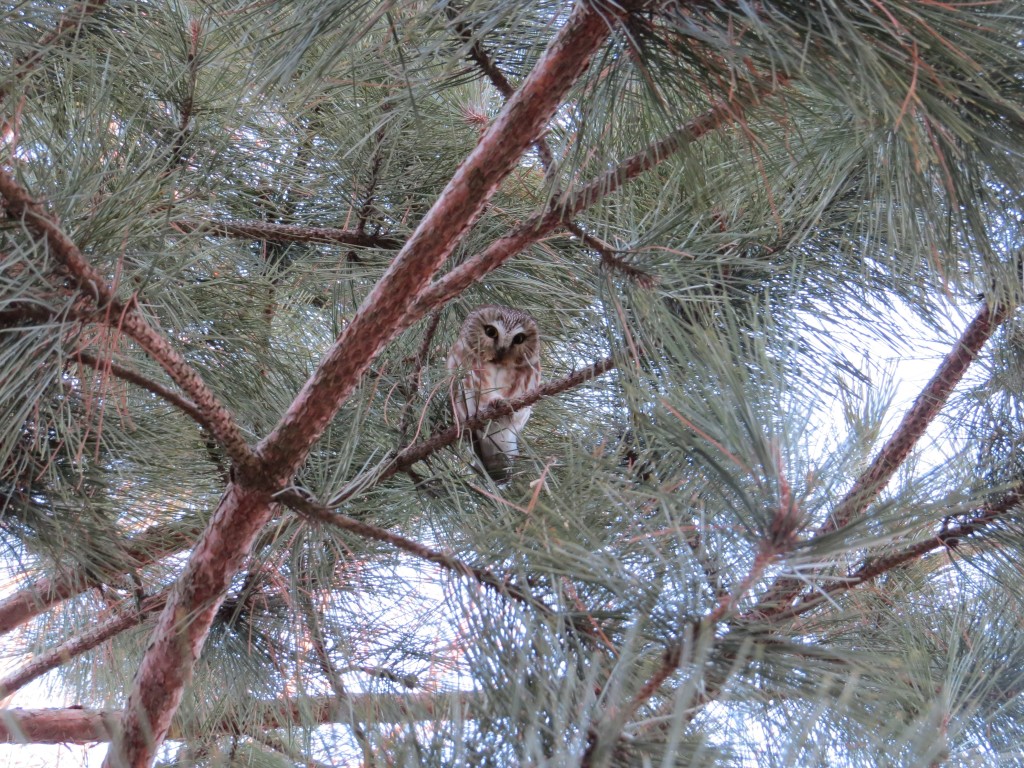
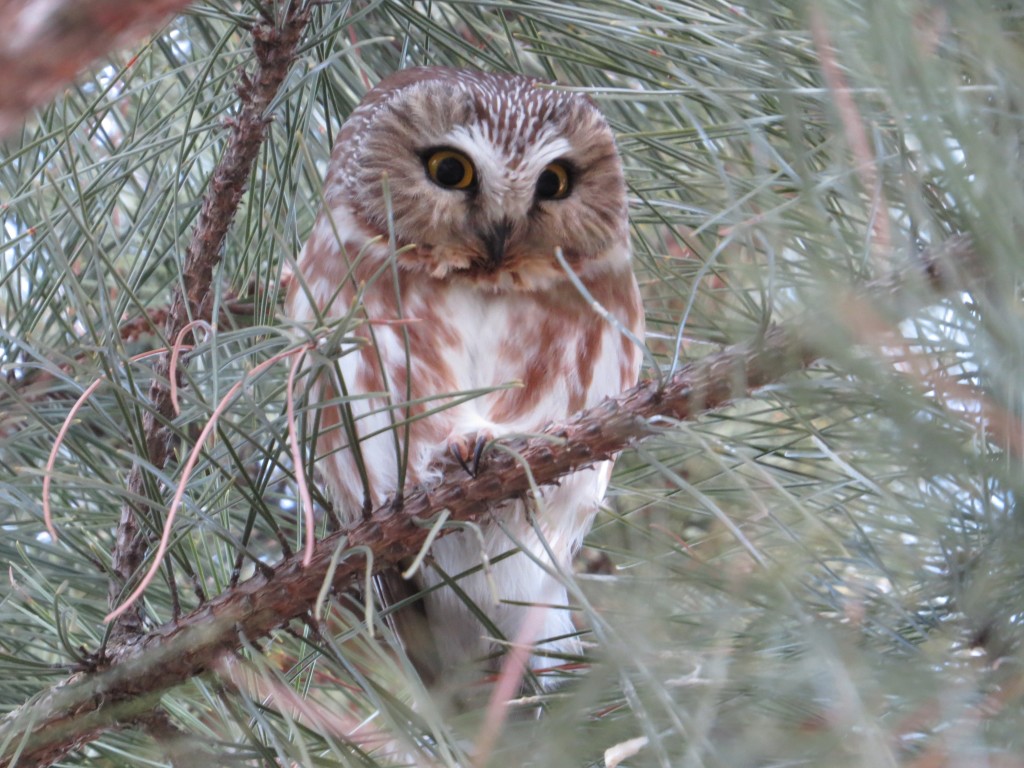 Occasionally it looked at me.
Occasionally it looked at me.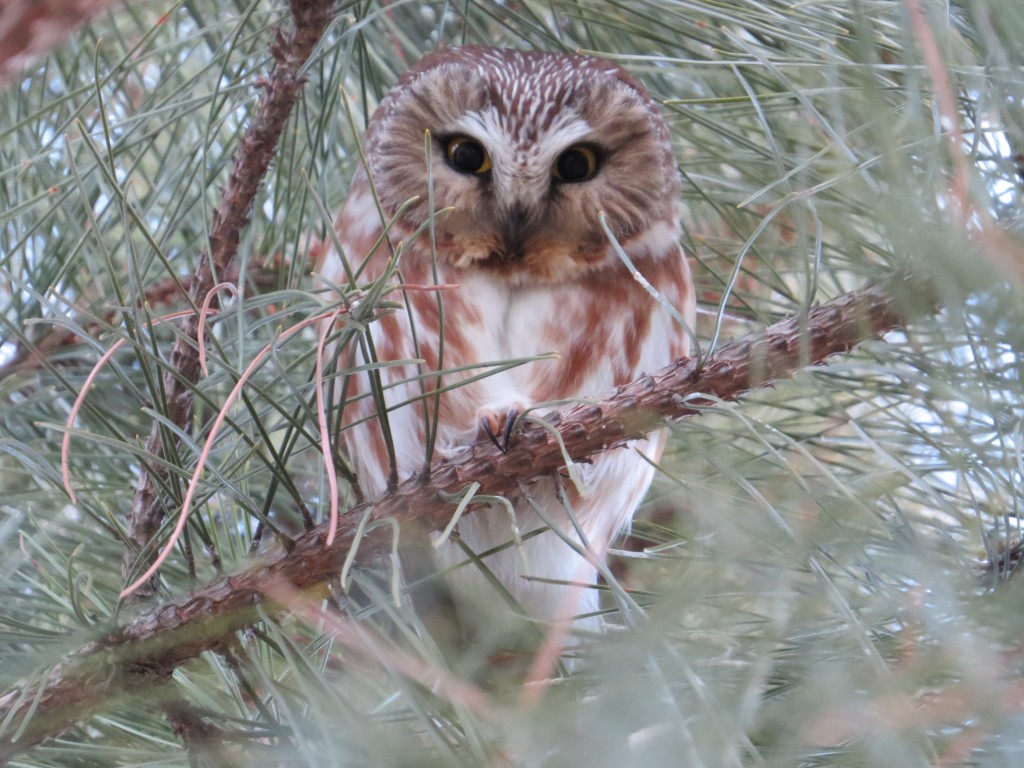 But it was mostly captivated by Steve.
But it was mostly captivated by Steve.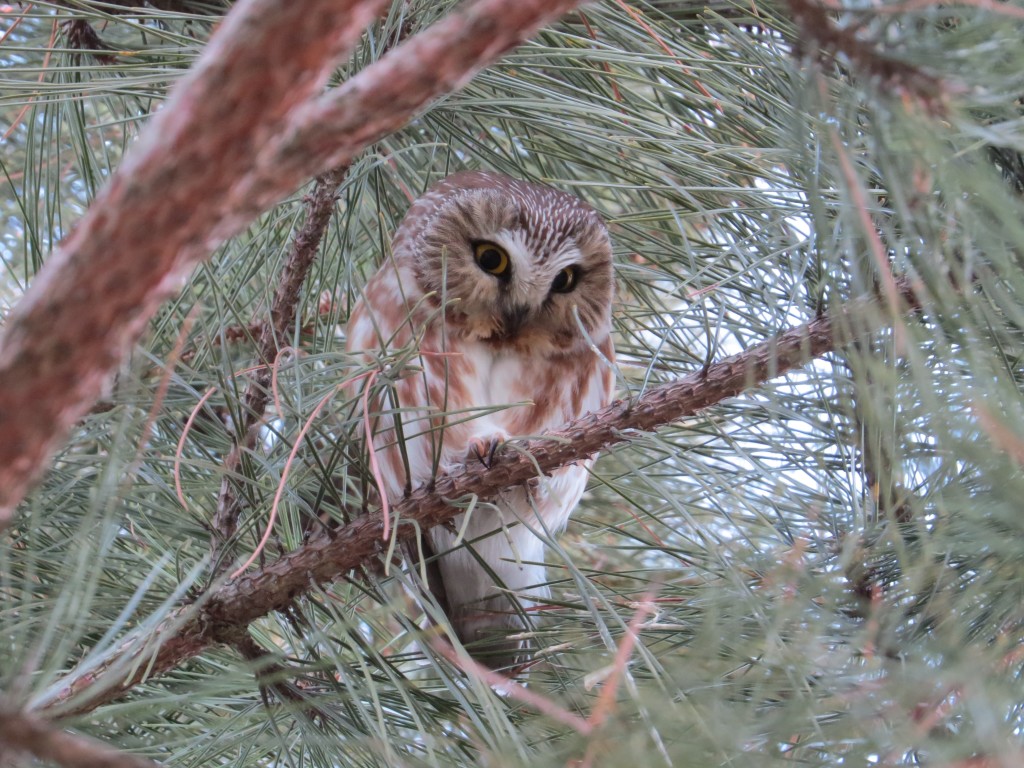
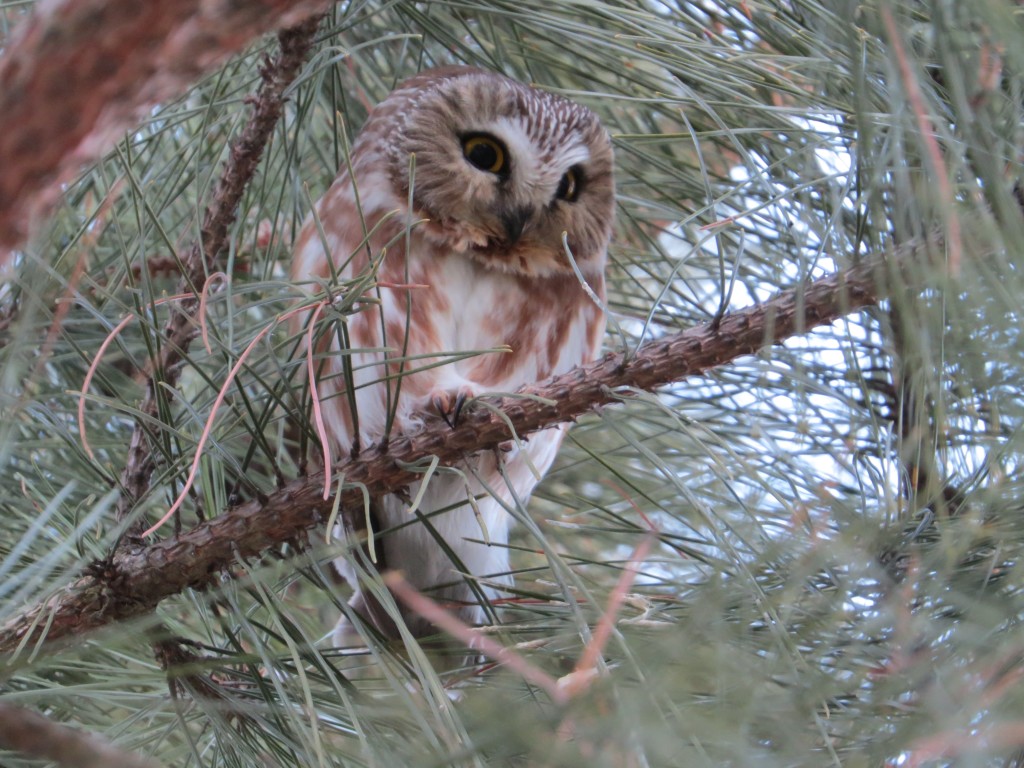 What was fascinating to me was how sloth-like this Owl was in moving its head. The movement was almost indiscernible. The fact that we were finally looking at a real Northern Saw-whet Owl combined with a close encounter with a tame bird makes this one of the best Owl experiences I’ve ever had.
What was fascinating to me was how sloth-like this Owl was in moving its head. The movement was almost indiscernible. The fact that we were finally looking at a real Northern Saw-whet Owl combined with a close encounter with a tame bird makes this one of the best Owl experiences I’ve ever had.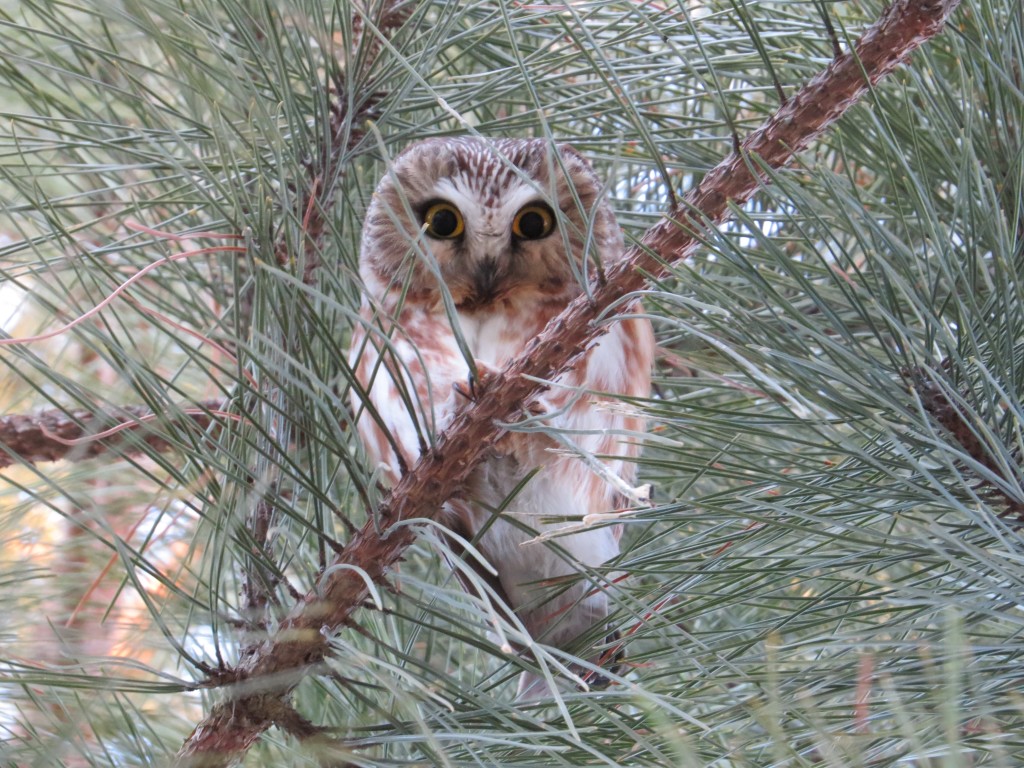 After taking last looks at the Owl and admiring the massive pile of pellets and all the whitewash from an Owl that has sat in this same spot every day for the winter, Steve and I thanked the homeowners and headed home feeling good…or evil. Steve called up his twin brother who is also a birder and rubbed in his new lifer. I went to the liquor store.
After taking last looks at the Owl and admiring the massive pile of pellets and all the whitewash from an Owl that has sat in this same spot every day for the winter, Steve and I thanked the homeowners and headed home feeling good…or evil. Steve called up his twin brother who is also a birder and rubbed in his new lifer. I went to the liquor store.



 Something even more amazing happened while we tried to lure out this guy–a second Black-back showed up! There was a male and a female! Unfortunately I never did see that classic field mark of the yellow crown on the male, but Tommy and Gordon each got to see it. I will continue to search for these birds until I finally see that and finally get good photos of this species.
Something even more amazing happened while we tried to lure out this guy–a second Black-back showed up! There was a male and a female! Unfortunately I never did see that classic field mark of the yellow crown on the male, but Tommy and Gordon each got to see it. I will continue to search for these birds until I finally see that and finally get good photos of this species.



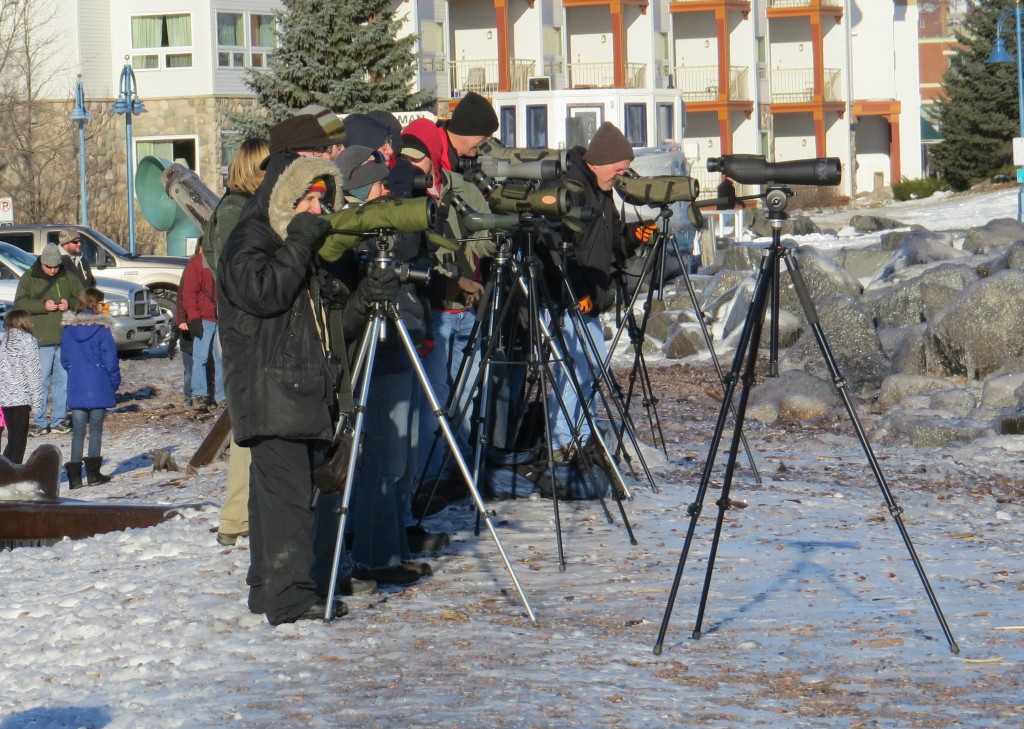 Willmar, of course, sent its own small delegation of eager birders to the Great Birder Assembly. Joining me in the pursuit of a shared, epic lifer were Randy Frederickson and Joel Schmidt. The gathering also gave my yearly and life birder lists a boost.
Willmar, of course, sent its own small delegation of eager birders to the Great Birder Assembly. Joining me in the pursuit of a shared, epic lifer were Randy Frederickson and Joel Schmidt. The gathering also gave my yearly and life birder lists a boost. Here’s what all the fuss is about:
Here’s what all the fuss is about: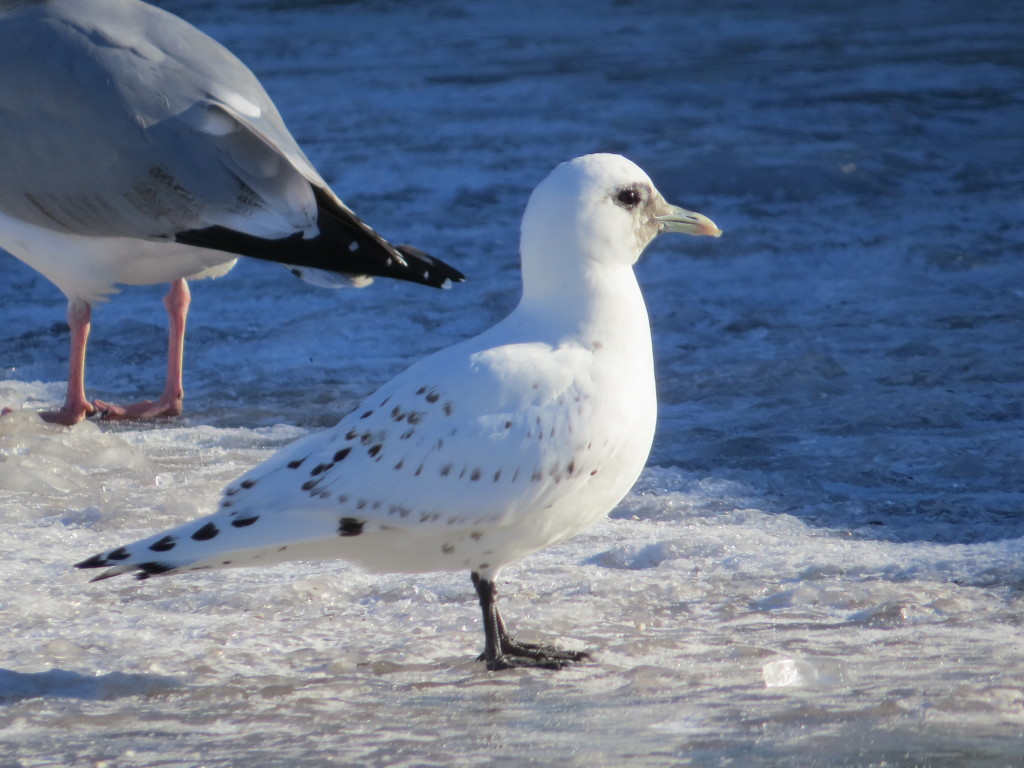
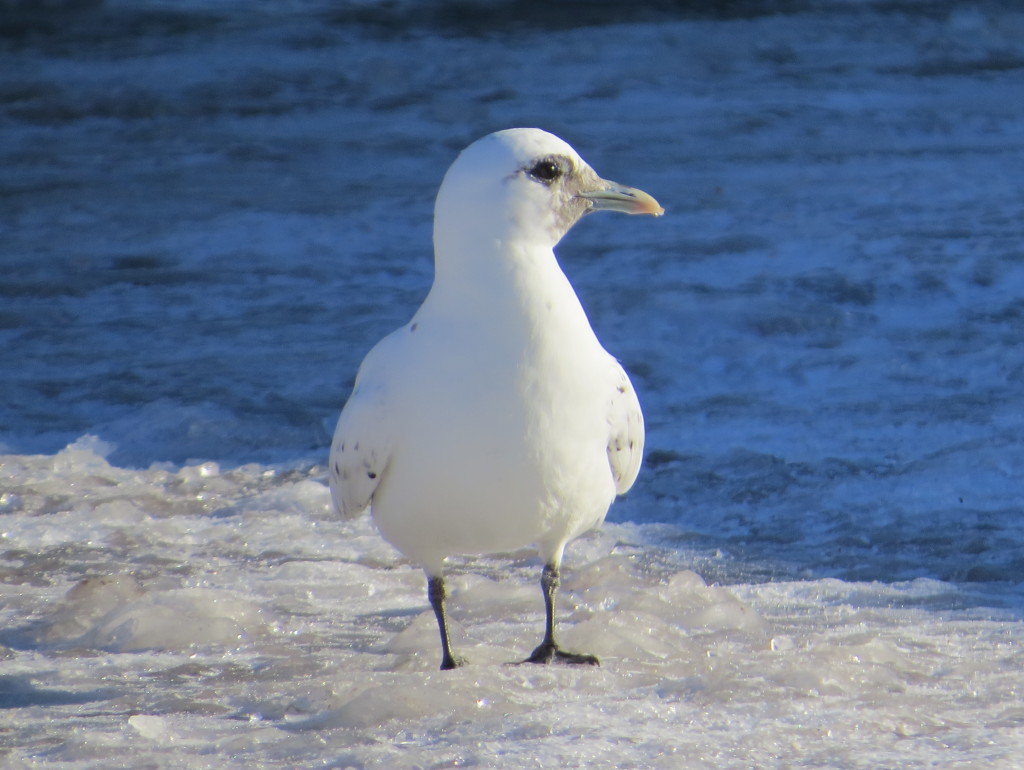
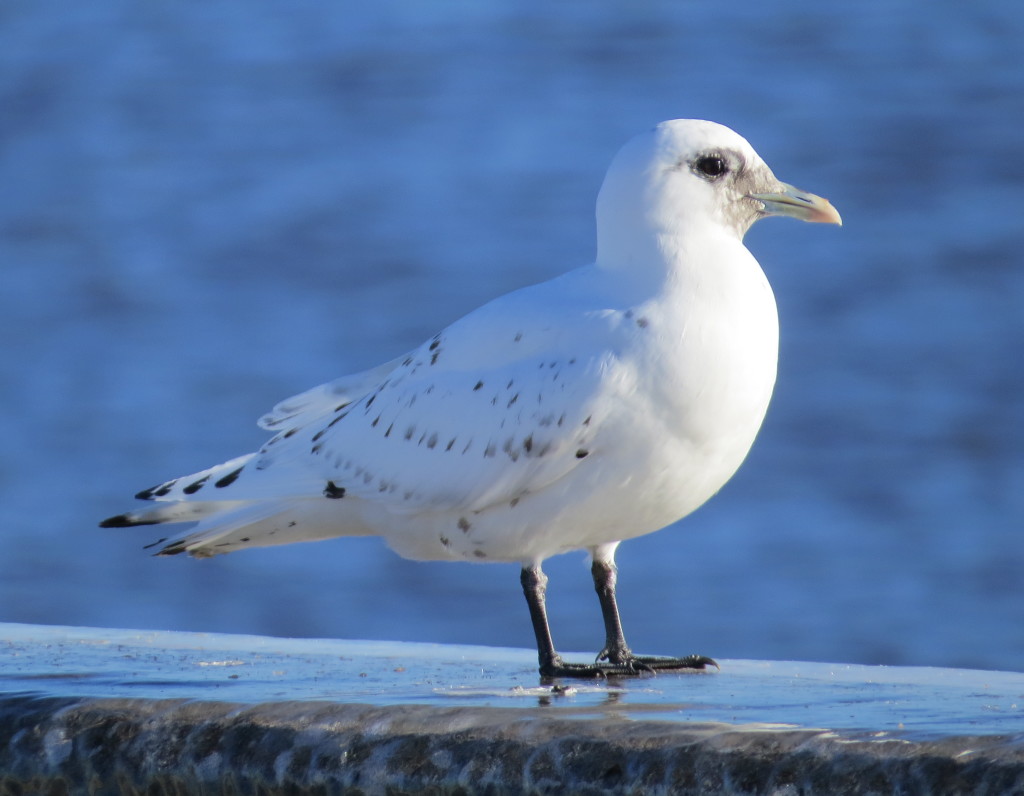
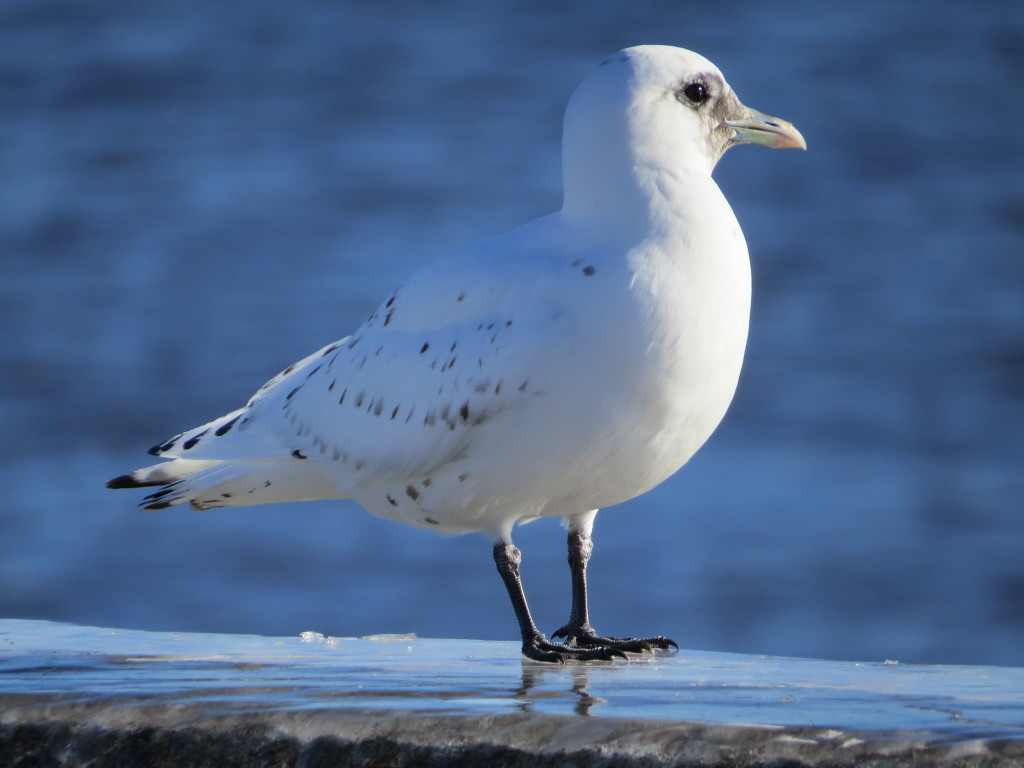 Conditions for viewing the IVGU were awful: wave action from Lake Superior had created a thick glaze of ice over every place an observer might stand. Never have I feared a concussion or wished I owned cleats more. It was downright dangerous. Even the Ivory walked with trepidation.
Conditions for viewing the IVGU were awful: wave action from Lake Superior had created a thick glaze of ice over every place an observer might stand. Never have I feared a concussion or wished I owned cleats more. It was downright dangerous. Even the Ivory walked with trepidation.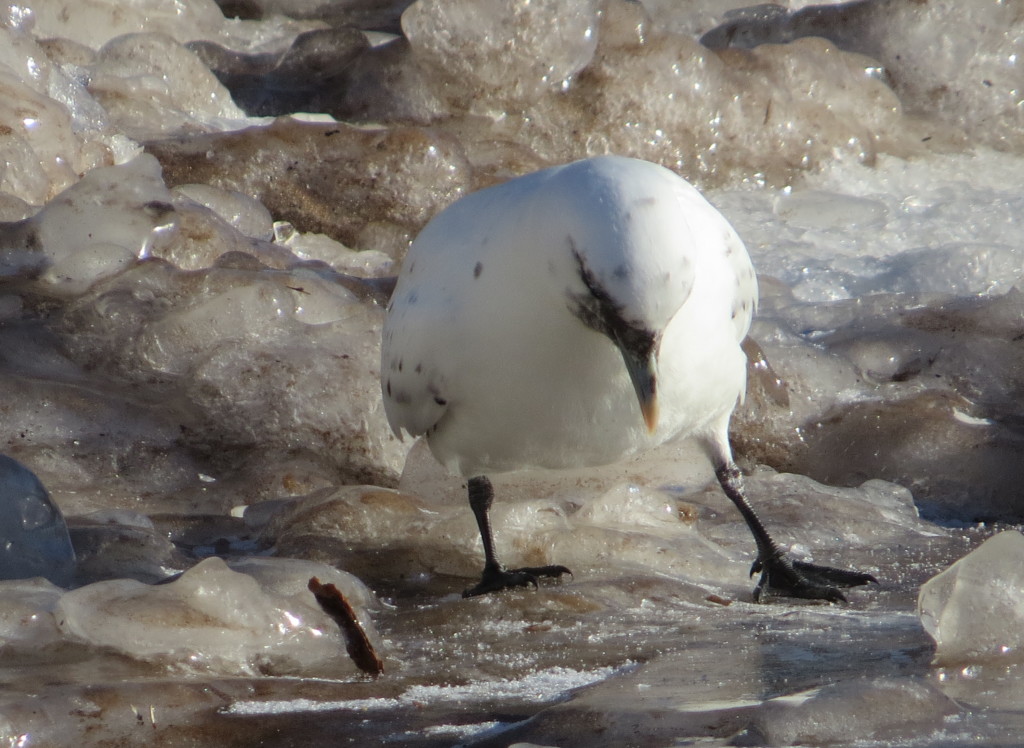 At one point a birder next to me didn’t really know how to proceed off the icy knoll on which we stood. I was getting annoyed with his prolonged hesitation. Then I felt like a complete jerk when the older fellow asked me if I would take his arm and help him down. As I gripped his quivering arm, I realized that this could be me in 30 or so years. It was a reminder of how quickly life moves and why events like this are so important, why we need to experience the phenomenal while we can. Going with friends, like Randy and Joel, make it even better, especially when celebratory beers are had at a place like Bent Paddle Brewhouse.
At one point a birder next to me didn’t really know how to proceed off the icy knoll on which we stood. I was getting annoyed with his prolonged hesitation. Then I felt like a complete jerk when the older fellow asked me if I would take his arm and help him down. As I gripped his quivering arm, I realized that this could be me in 30 or so years. It was a reminder of how quickly life moves and why events like this are so important, why we need to experience the phenomenal while we can. Going with friends, like Randy and Joel, make it even better, especially when celebratory beers are had at a place like Bent Paddle Brewhouse.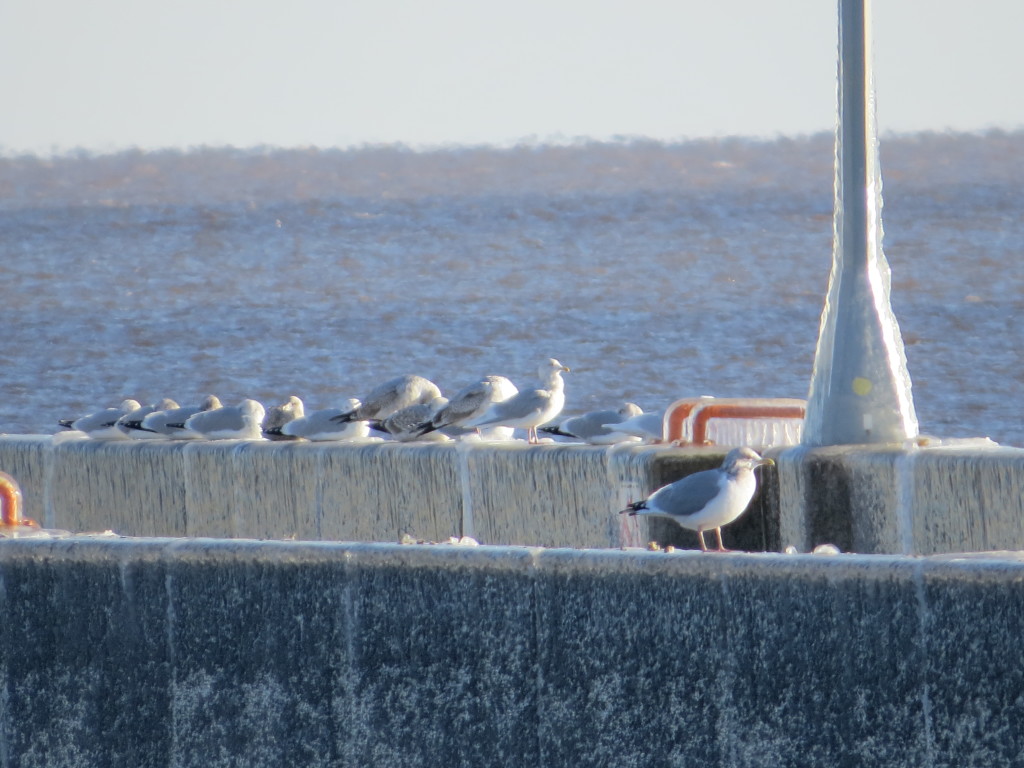 Here was an immature bird that is Thayer’s/Iceland intergrade. The local Larus Jedi call him Stumpy because of his missing tail.
Here was an immature bird that is Thayer’s/Iceland intergrade. The local Larus Jedi call him Stumpy because of his missing tail.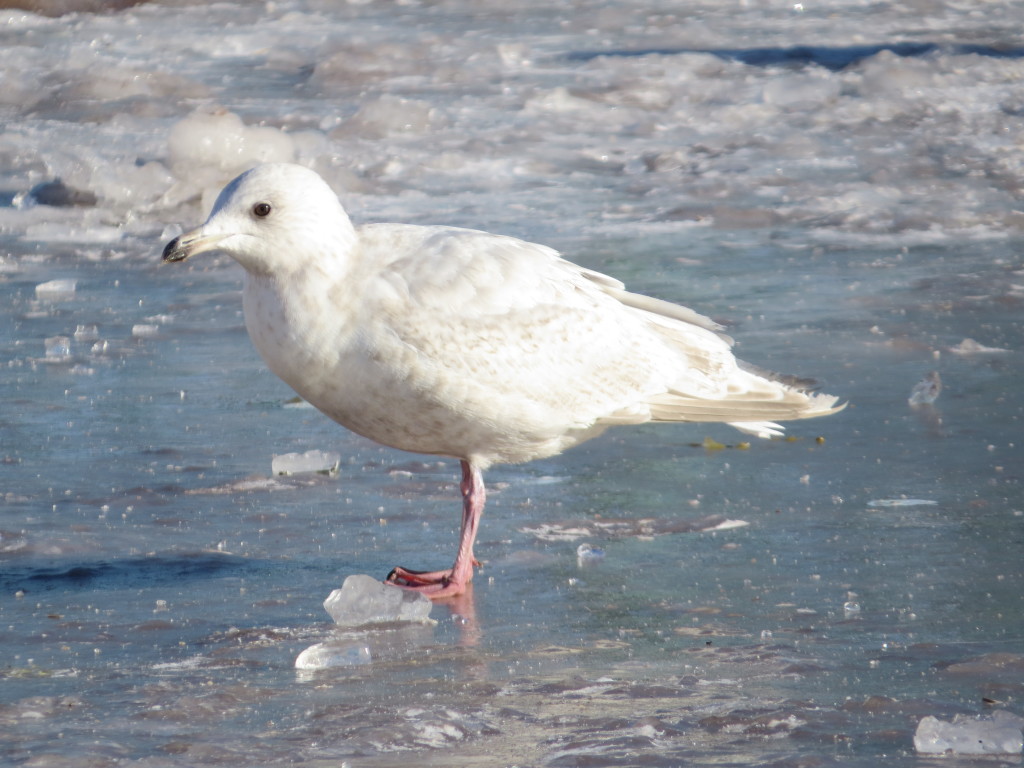 We did see a couple of adult Thayer’s but no Glaucous Gulls this time. Since I got the full Gull smorgasbord a month ago, besides the Ivory I was most excited about all the American Black Ducks. I counted well over a dozen among the 300 Mallards. They really do stand out and the proximity and sunlight made them especially photogenic on this gorgeous day. This is a duck I just don’t see enough, so this was quite enjoyable.
We did see a couple of adult Thayer’s but no Glaucous Gulls this time. Since I got the full Gull smorgasbord a month ago, besides the Ivory I was most excited about all the American Black Ducks. I counted well over a dozen among the 300 Mallards. They really do stand out and the proximity and sunlight made them especially photogenic on this gorgeous day. This is a duck I just don’t see enough, so this was quite enjoyable.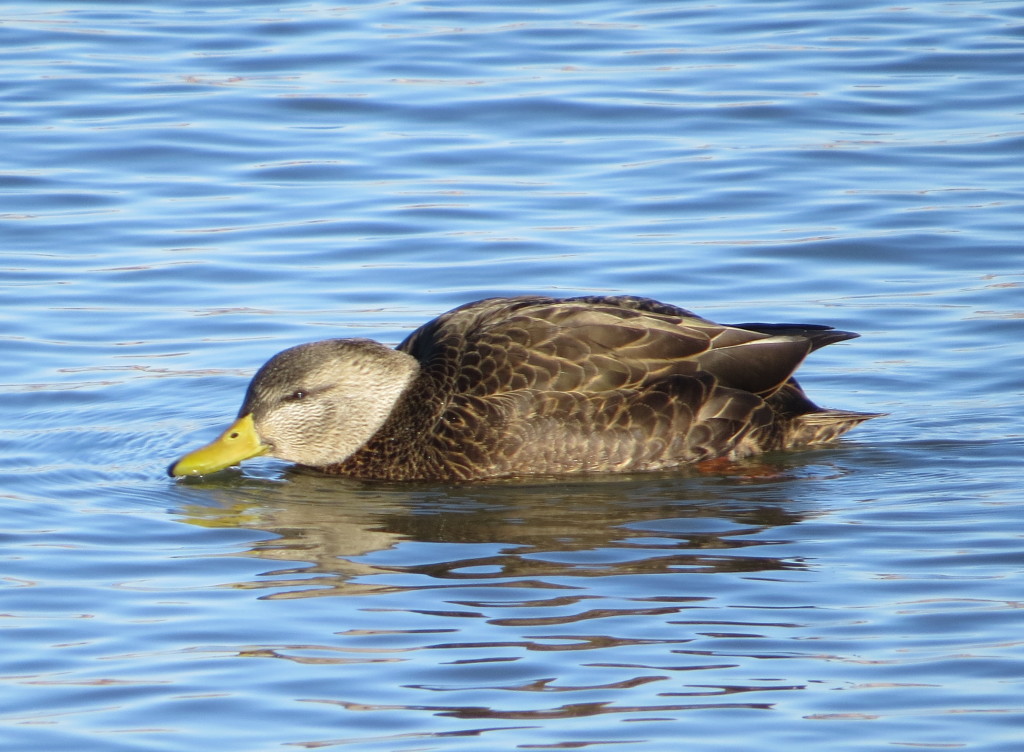
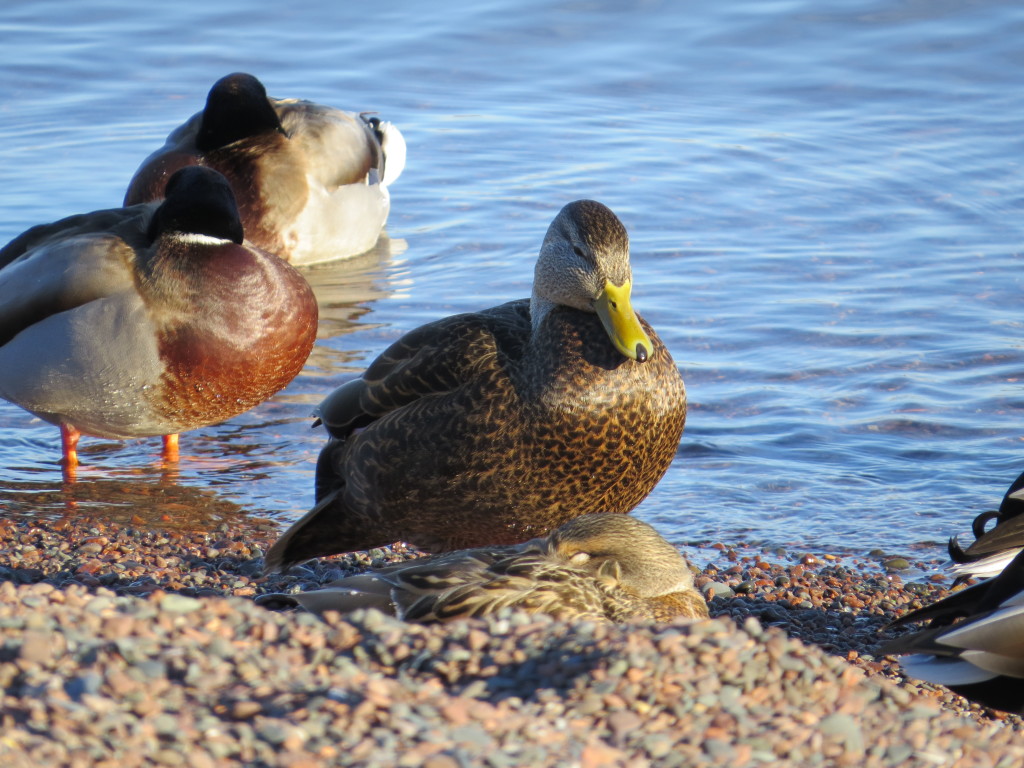
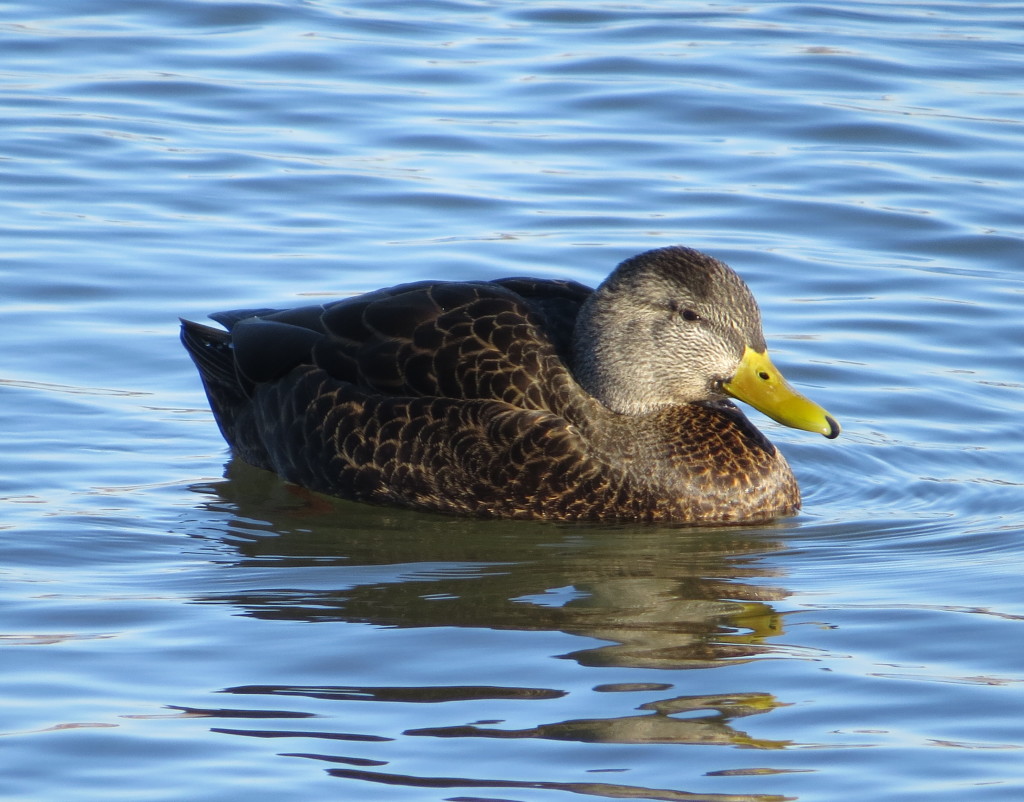 We lingered around Canal Park for a couple hours hoping to find Joel a Great Black-backed Gull lifer, but it just wasn’t in the cards. What was in the cards was the arrival of the longest ship known to the Great Lakes, the 1014-foot long Paul R. Tregurtha:
We lingered around Canal Park for a couple hours hoping to find Joel a Great Black-backed Gull lifer, but it just wasn’t in the cards. What was in the cards was the arrival of the longest ship known to the Great Lakes, the 1014-foot long Paul R. Tregurtha: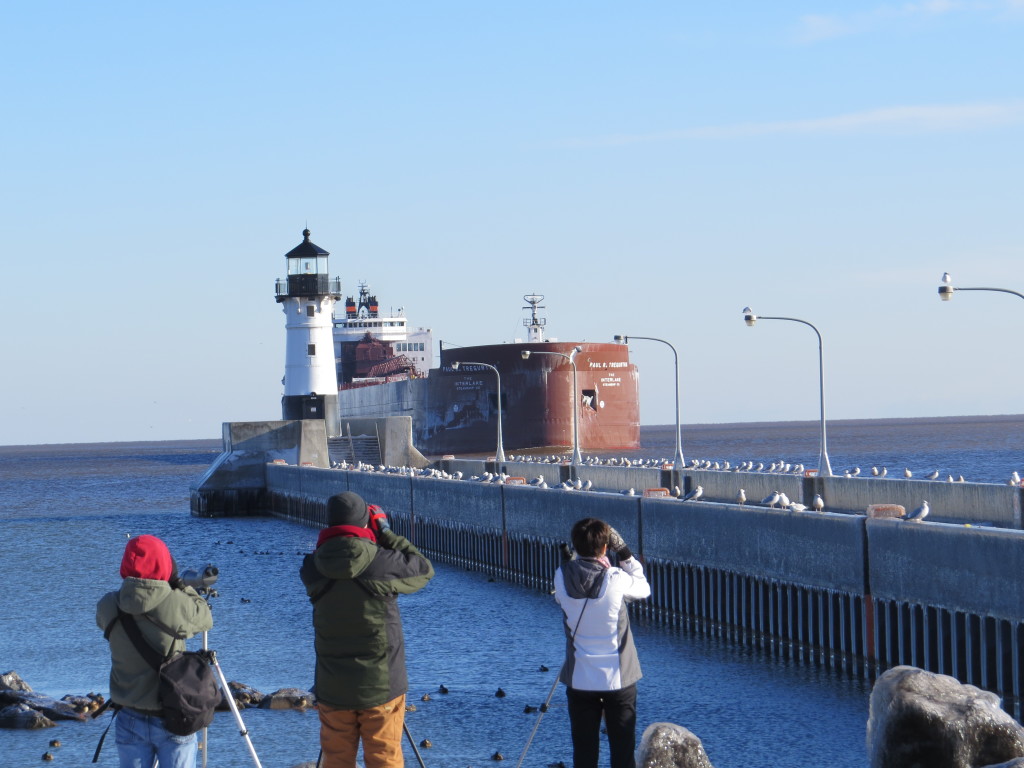


 An accidental rare species from the Arctic and the largest ship on the Great Lakes coming in to port made for a most exciting outing. We had one more errand that would put this day completely up and over the top–crossing the Blatnik Bridge to Superior, Wisconsin to pick up a 2016 Gyrfalcon! In less than a year’s time I have seen three Gyrfalcons, which still is not enough because like Jello, there’s always room for Gyr. Photos at this distance were practically impossible, but I’m okay with
An accidental rare species from the Arctic and the largest ship on the Great Lakes coming in to port made for a most exciting outing. We had one more errand that would put this day completely up and over the top–crossing the Blatnik Bridge to Superior, Wisconsin to pick up a 2016 Gyrfalcon! In less than a year’s time I have seen three Gyrfalcons, which still is not enough because like Jello, there’s always room for Gyr. Photos at this distance were practically impossible, but I’m okay with 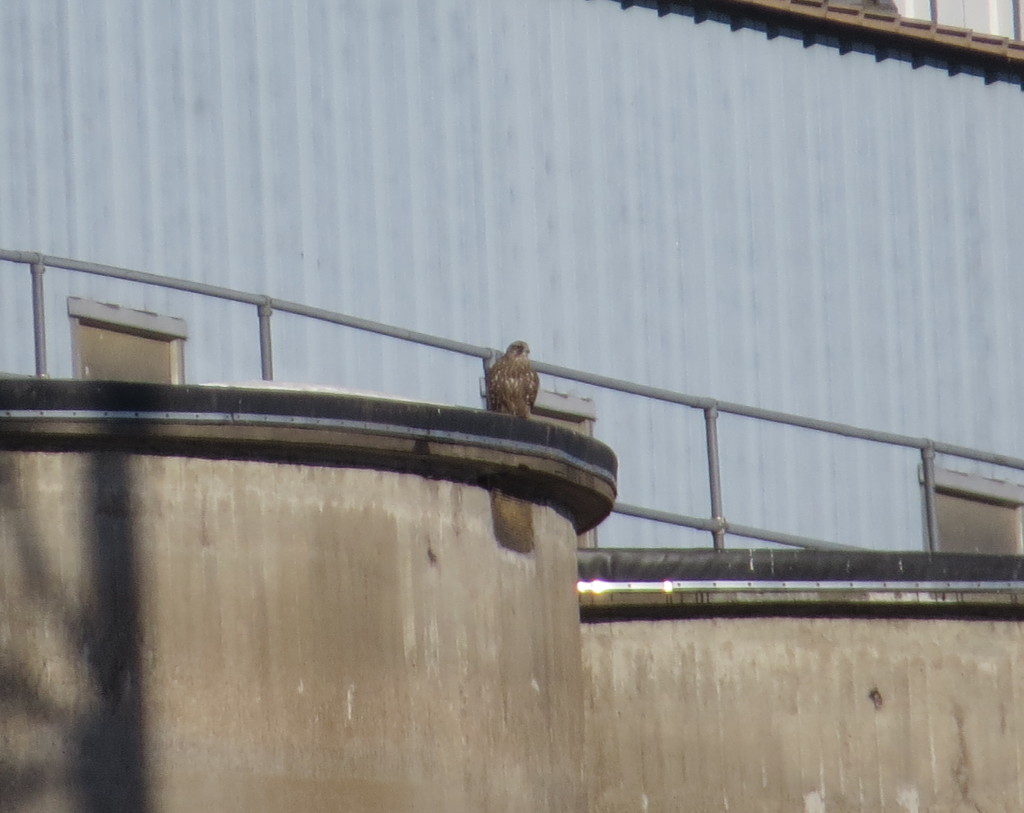
 The next stop was for Milt Blomberg’s Varied Thrush at Oakland Cemetery in Marine on St. Croix. It was also a no show. I did not spend more than a few minutes looking for this bird which would merely be a year bird; there was bigger game at stake. We needed to get down to Afton State Park in time for the evening show of some Short-eared Owls. This would be a much hoped-for lifer. We made it by my target time of 4:00, but barely. As you can see, the heavy snow in the first picture had transformed the eastern portion of the state into Hoth. The kids were prepared.
The next stop was for Milt Blomberg’s Varied Thrush at Oakland Cemetery in Marine on St. Croix. It was also a no show. I did not spend more than a few minutes looking for this bird which would merely be a year bird; there was bigger game at stake. We needed to get down to Afton State Park in time for the evening show of some Short-eared Owls. This would be a much hoped-for lifer. We made it by my target time of 4:00, but barely. As you can see, the heavy snow in the first picture had transformed the eastern portion of the state into Hoth. The kids were prepared. The kids and I walked around the border of this entire prairie area, hoping to spot a Short-eared Owl flying at any moment. I should say that I was hoping to spot an Owl; they were happy to be out of the car and frolicking in the snow. Despair–for me–was sinking in as it looked like this would be strike three for the day’s agenda. But then on the walk back toward the car, a voice boomed from the other side of the prairie, “Hey! Short-eared Owl!” God? No, it was Pete Nichols, moderator of the MN Birding Facebook Group. This was his turf, and he had come to check up on the Owls and give us an assist. Thanks, Pete!
The kids and I walked around the border of this entire prairie area, hoping to spot a Short-eared Owl flying at any moment. I should say that I was hoping to spot an Owl; they were happy to be out of the car and frolicking in the snow. Despair–for me–was sinking in as it looked like this would be strike three for the day’s agenda. But then on the walk back toward the car, a voice boomed from the other side of the prairie, “Hey! Short-eared Owl!” God? No, it was Pete Nichols, moderator of the MN Birding Facebook Group. This was his turf, and he had come to check up on the Owls and give us an assist. Thanks, Pete!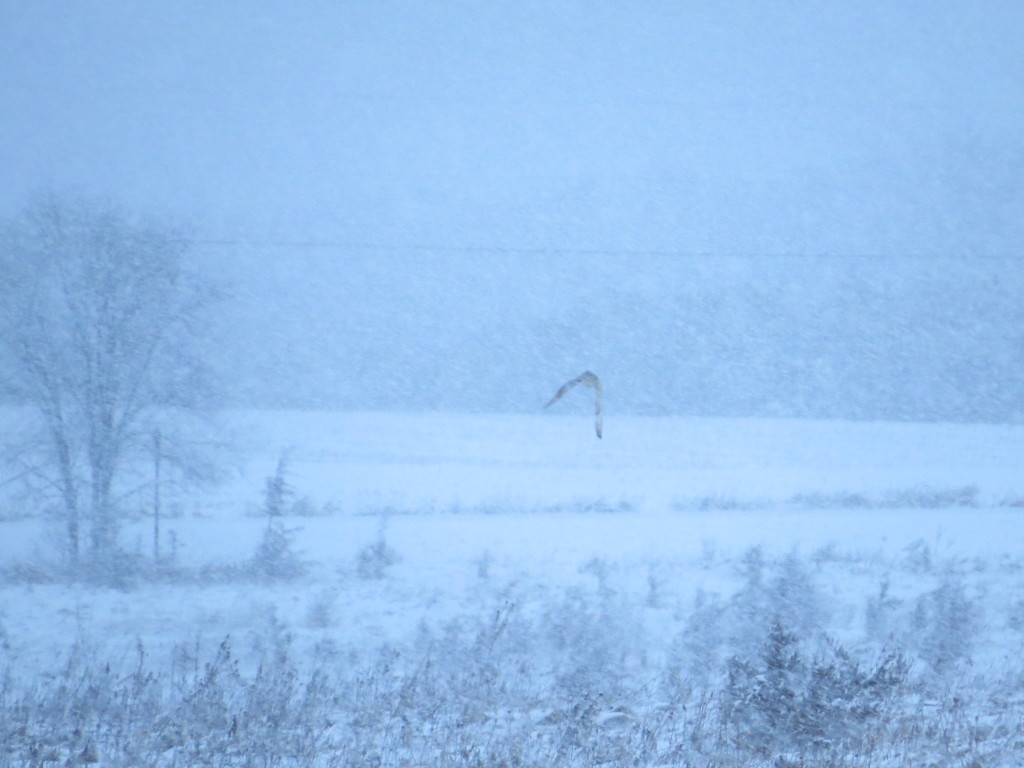
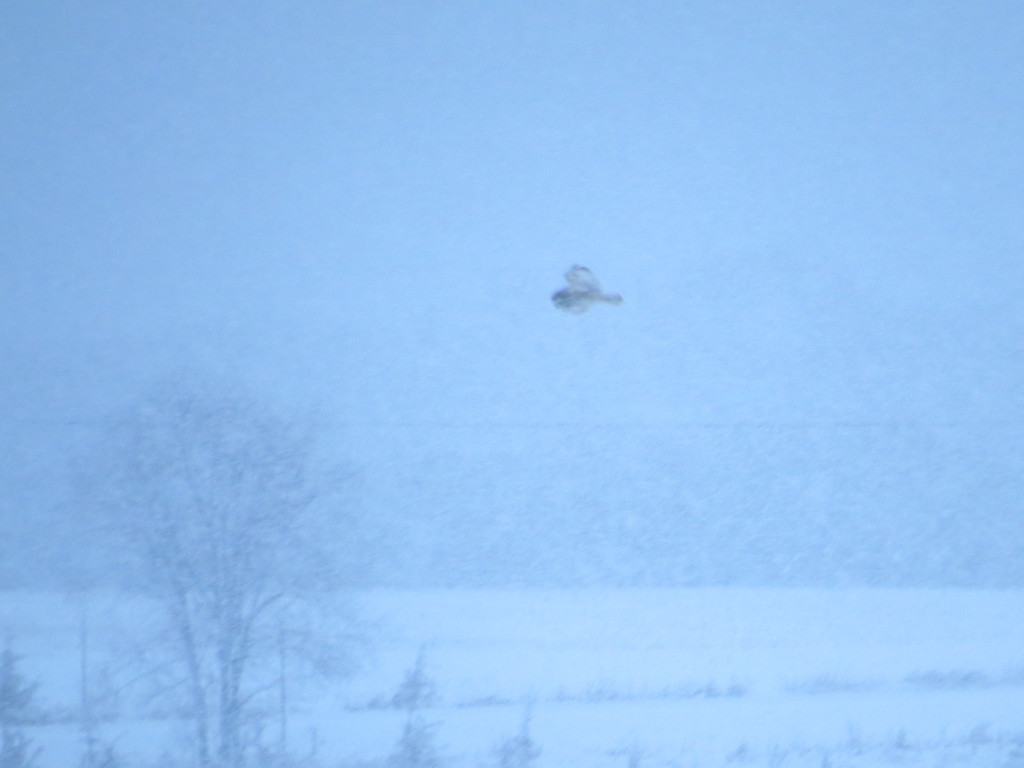 1 for 3 isn’t bad especially when that one is an Owl lifer. More important, though, was that I had a good day out of the house with the kids seeing a beautiful part of the state and exploring some great state parks together. The lack of birds may have even been a good thing as it forced me to pay more attention to the kids, to photograph them. After all, the Owls aren’t changing and will always be there.
1 for 3 isn’t bad especially when that one is an Owl lifer. More important, though, was that I had a good day out of the house with the kids seeing a beautiful part of the state and exploring some great state parks together. The lack of birds may have even been a good thing as it forced me to pay more attention to the kids, to photograph them. After all, the Owls aren’t changing and will always be there.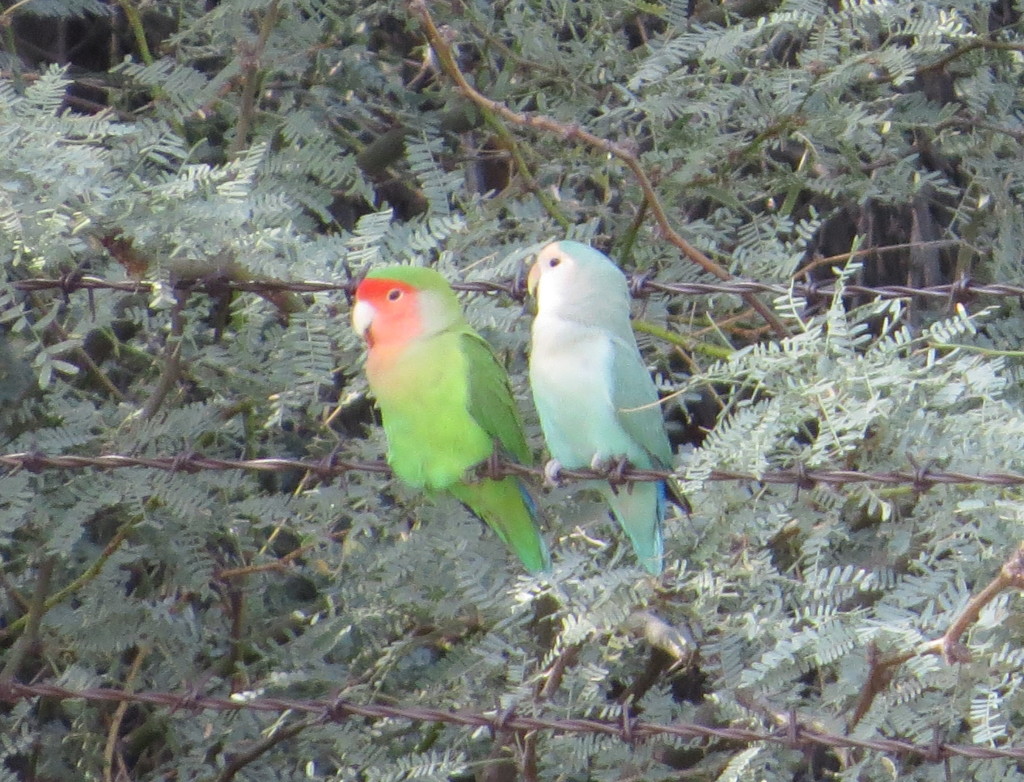 The Lovebirds have adapted well to the oases of the water-filled landscaping in the greater Phoenix area. They especially like palms which have proven useful for nesting.
The Lovebirds have adapted well to the oases of the water-filled landscaping in the greater Phoenix area. They especially like palms which have proven useful for nesting.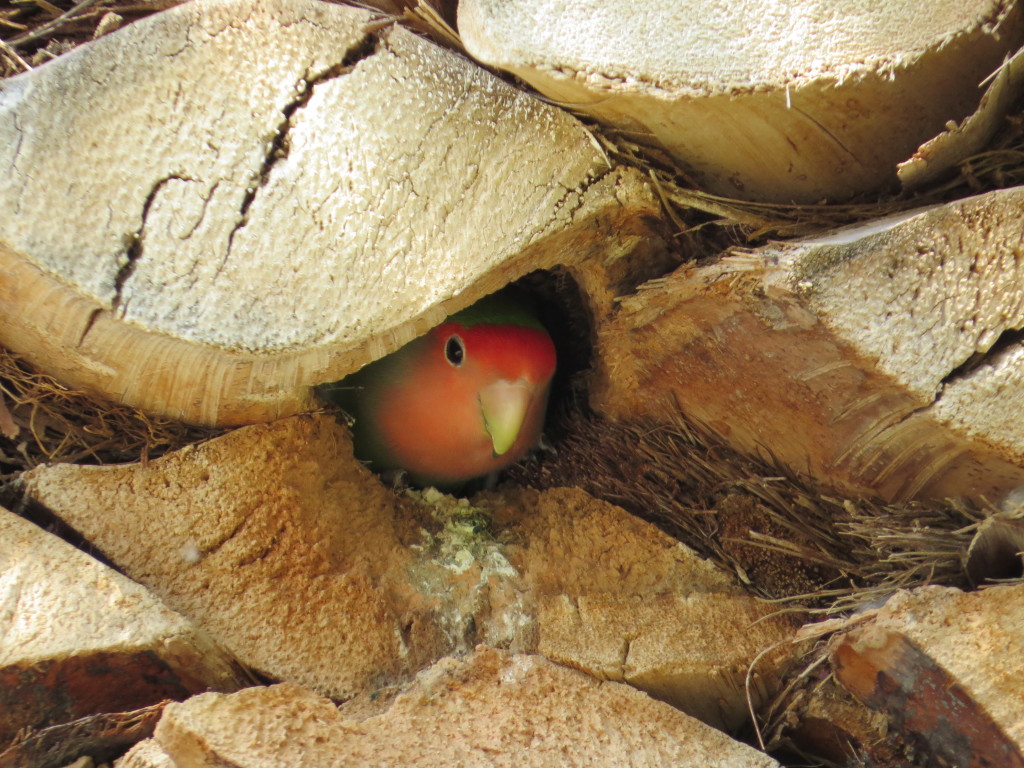 These birds are truly cute. Melissa agrees.
These birds are truly cute. Melissa agrees.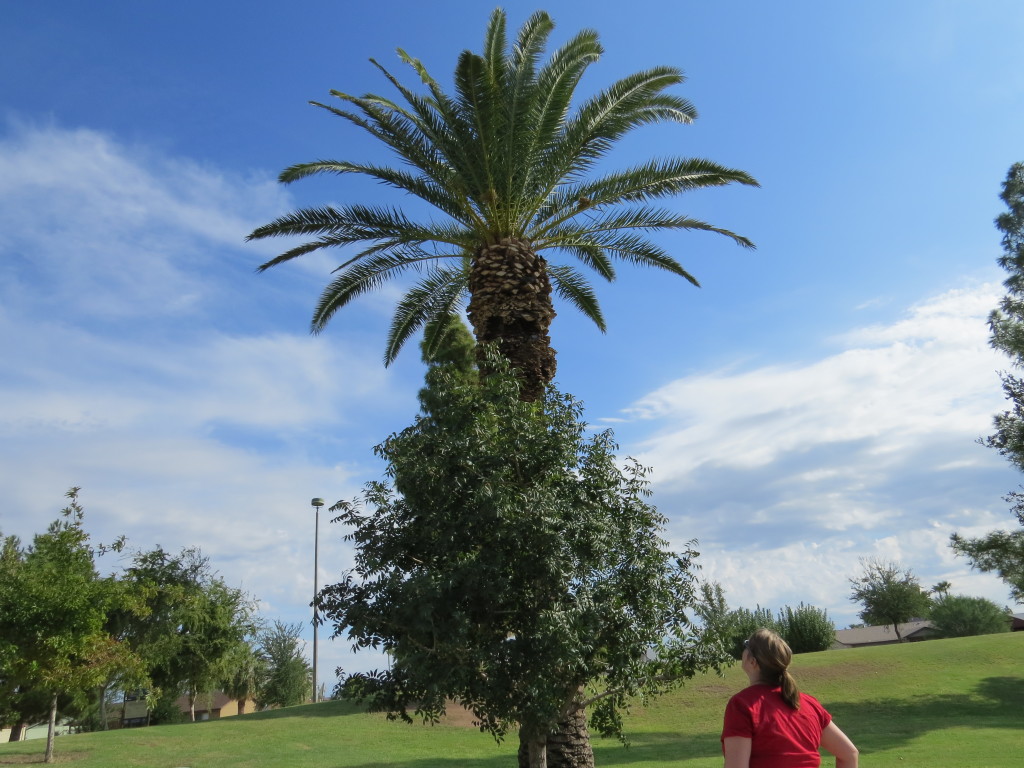
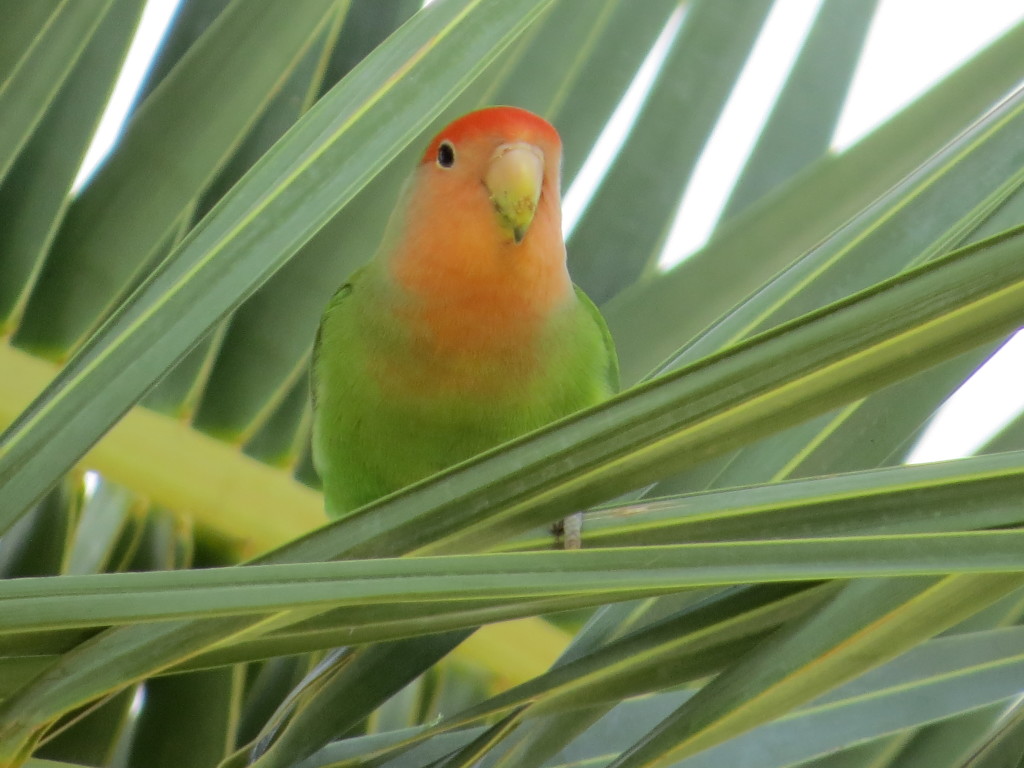
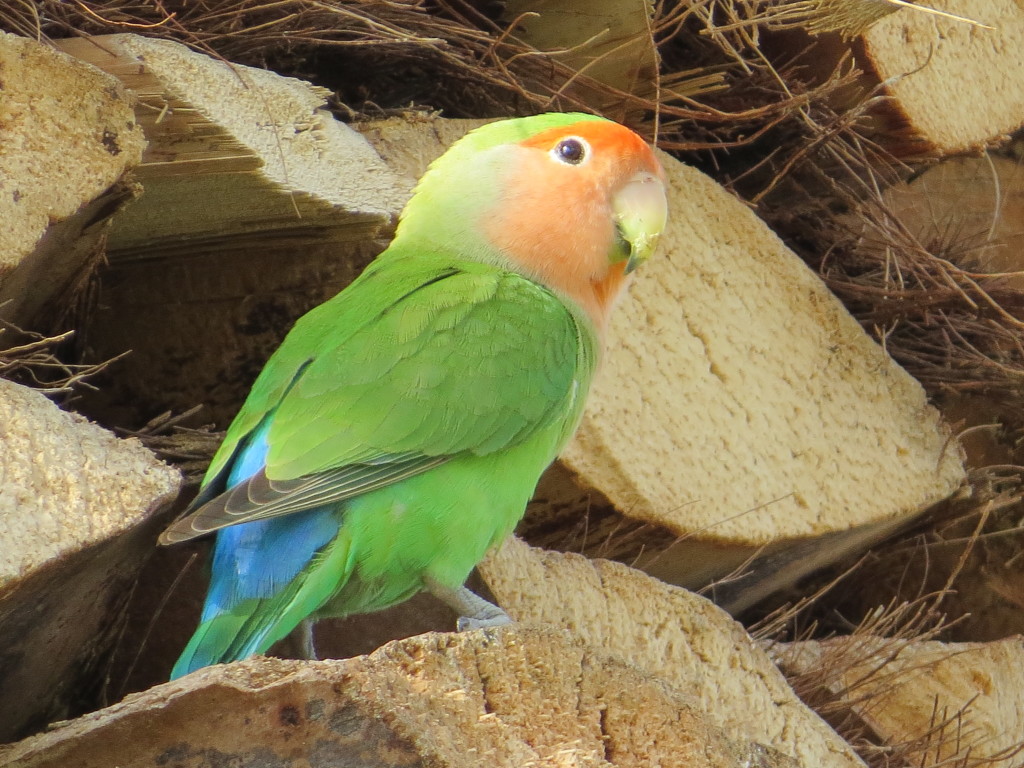 Here’s an important public service announcement for those of you not acquainted with the Lovebird. It is safe to say that despite this being an “easy” bird, I don’t think I would have found them without Gordon’s help. Here’s why: my sense of this bird’s scale was way off. Since all you ever see on blogs are impressive close-ups of this crushable bird, I was looking for something that I thought was Pigeon-sized. I guess I was wrong.
Here’s an important public service announcement for those of you not acquainted with the Lovebird. It is safe to say that despite this being an “easy” bird, I don’t think I would have found them without Gordon’s help. Here’s why: my sense of this bird’s scale was way off. Since all you ever see on blogs are impressive close-ups of this crushable bird, I was looking for something that I thought was Pigeon-sized. I guess I was wrong. 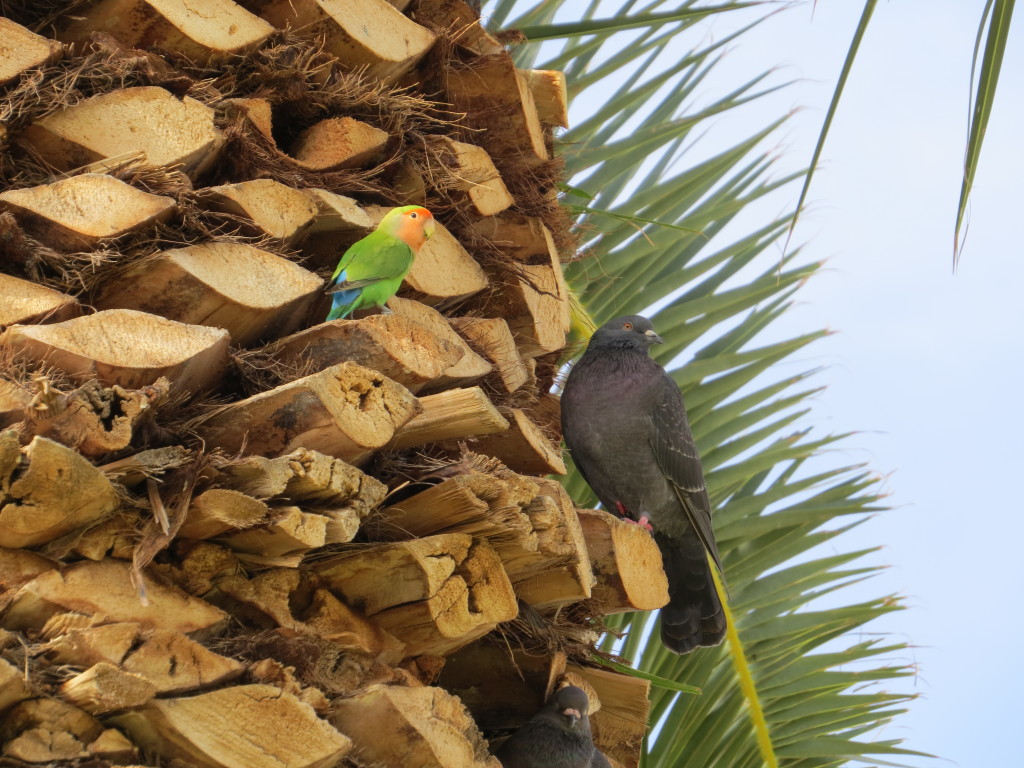
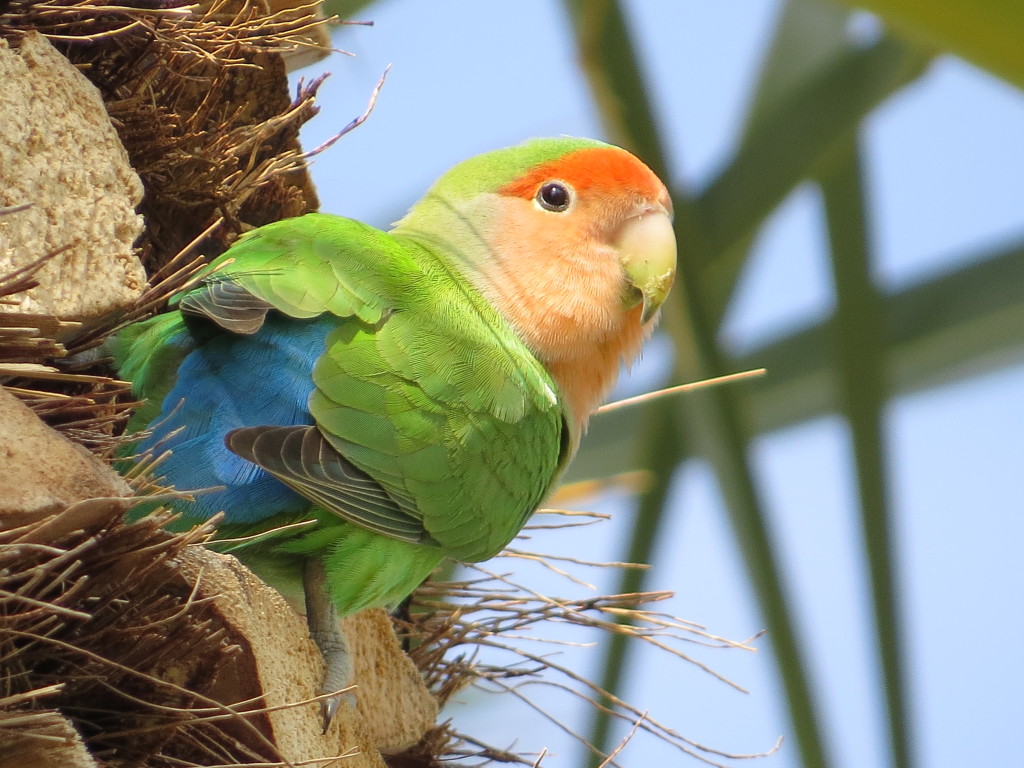 It’s hard to stop taking pictures of such a cute bird, but that’s mostly because Kiwanis didn’t offer up much more than Neotropic Cormorants and Pigeons. A pair of Gilded Flickers at our feet was a nice bonus.
It’s hard to stop taking pictures of such a cute bird, but that’s mostly because Kiwanis didn’t offer up much more than Neotropic Cormorants and Pigeons. A pair of Gilded Flickers at our feet was a nice bonus.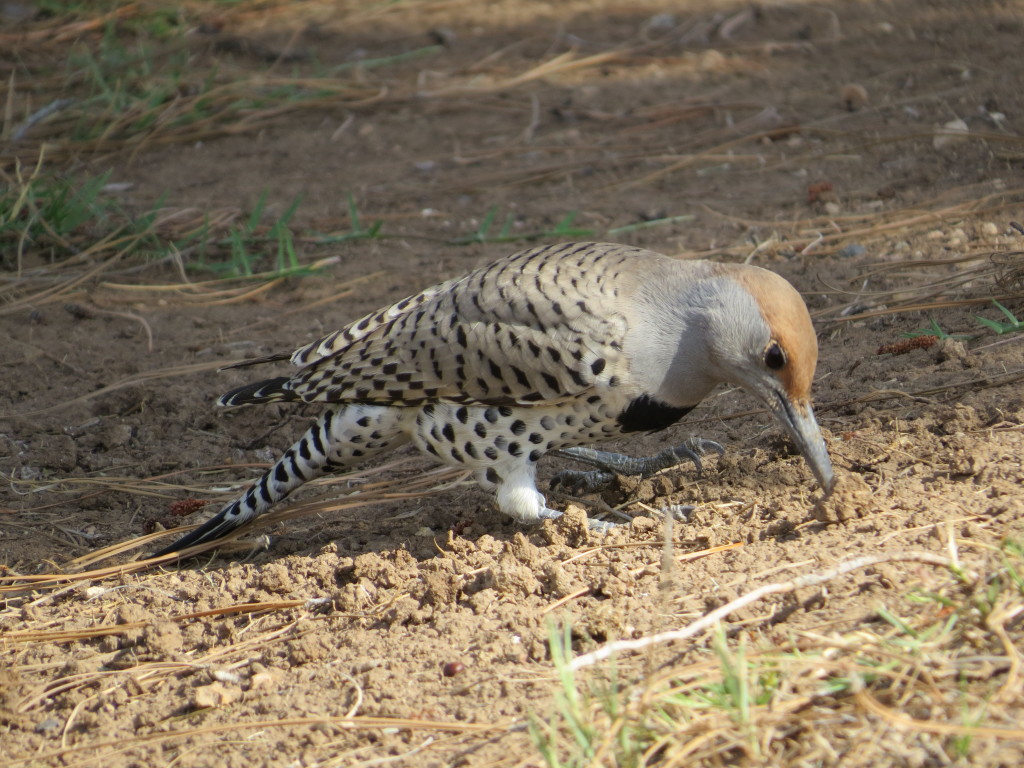 With the Lovebird lifer out of the way, we made the short trek up to Tempe Town Lake. The Brown Pelican was a bird I’d like to think I could have found on my own. Gordon wasn’t taking any chances. He led the way and spotted it out in marsh section of Tempe Town Lake.
With the Lovebird lifer out of the way, we made the short trek up to Tempe Town Lake. The Brown Pelican was a bird I’d like to think I could have found on my own. Gordon wasn’t taking any chances. He led the way and spotted it out in marsh section of Tempe Town Lake.
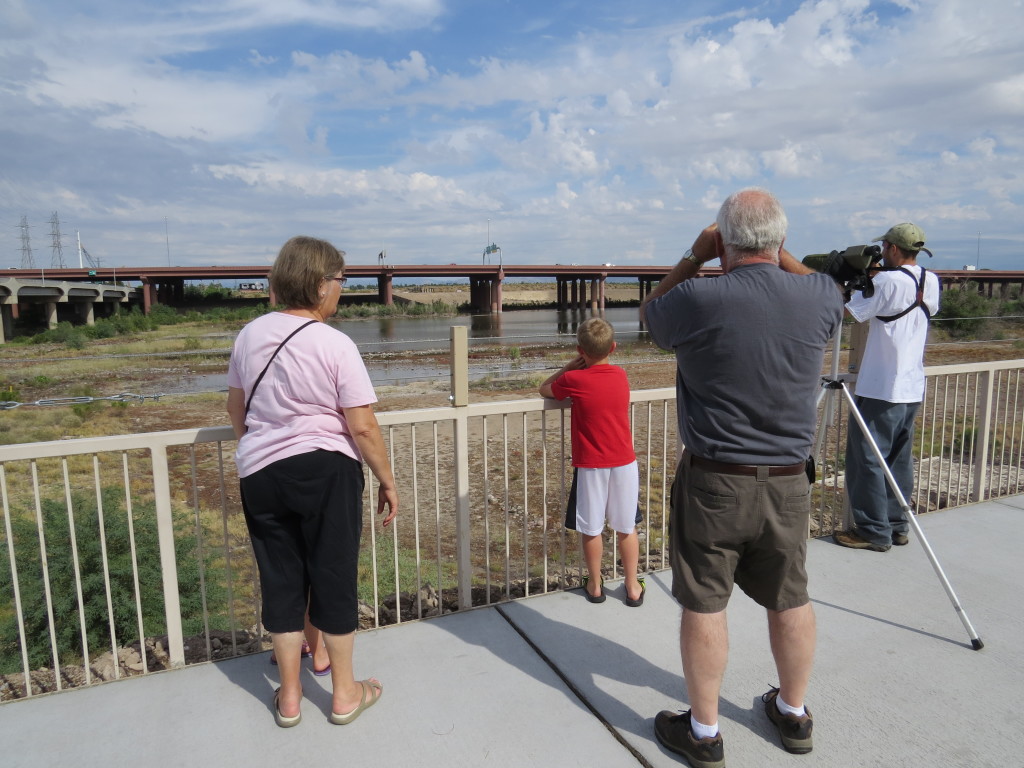
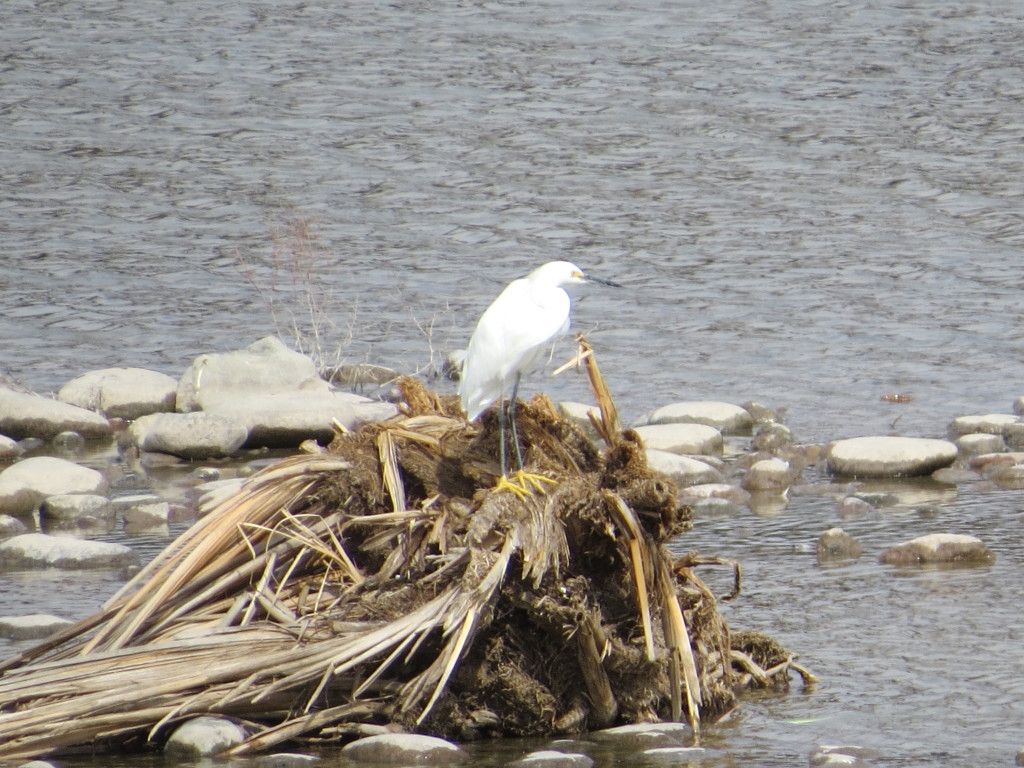
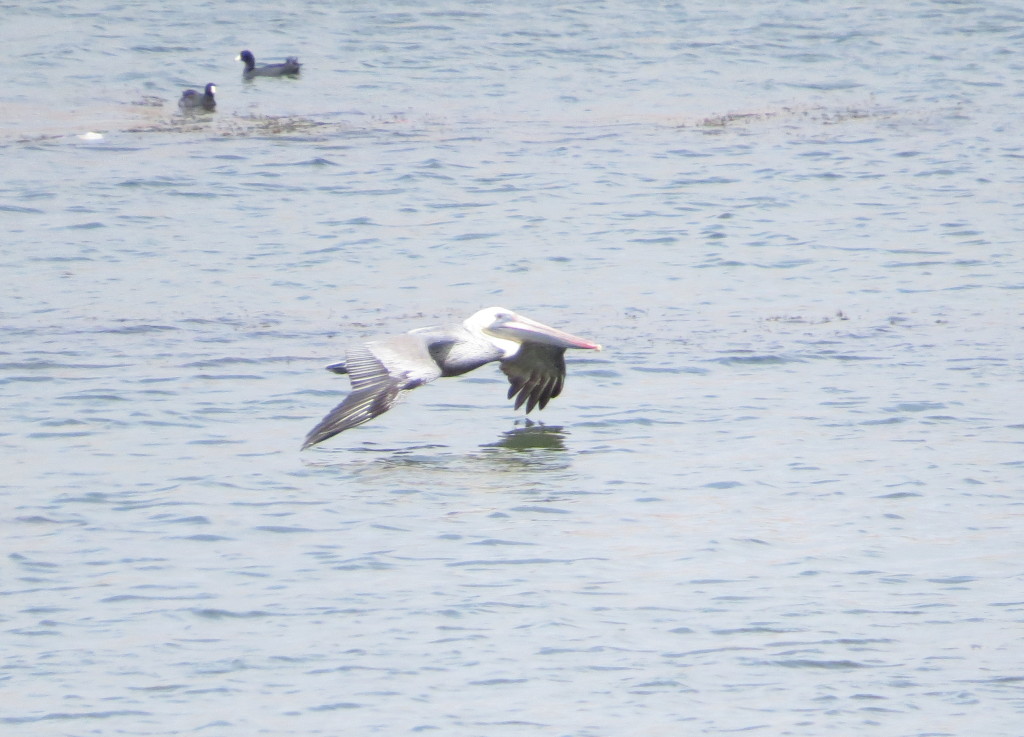
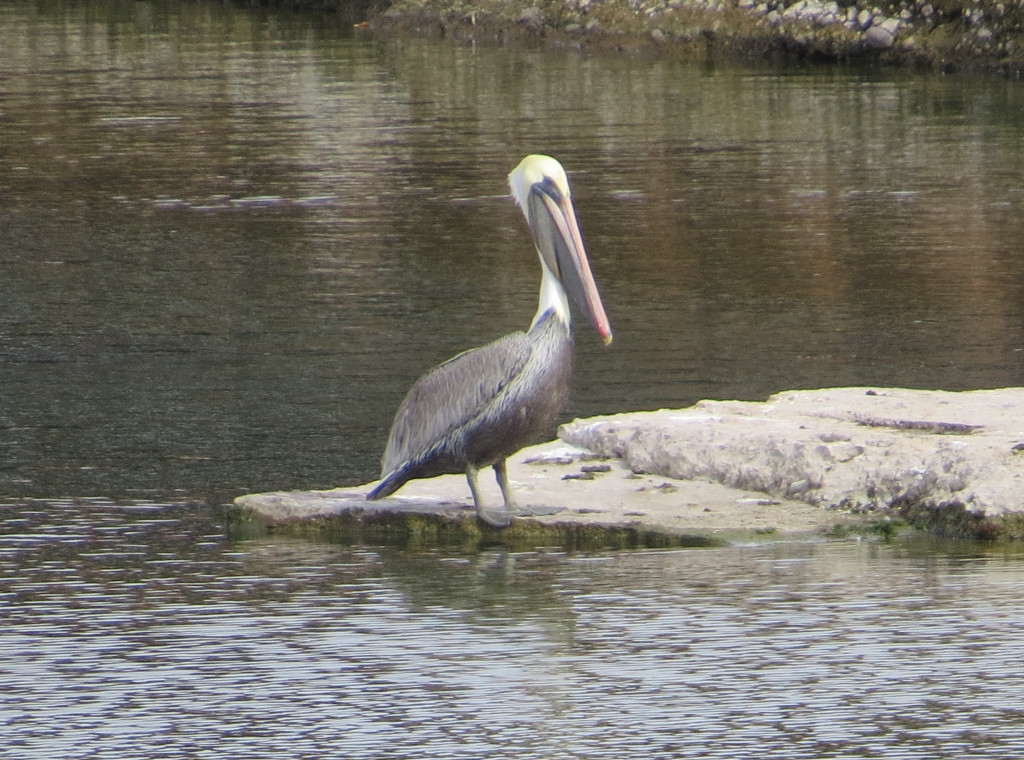 Finally the Pelican/Lovebird anxiety was no more. After saying our goodbyes to Gordon, we had much of the day to do whatever, like check out the impressive collections of potted cacti and caged Macaws at Leaf&Feather in Maricopa. I had no idea so many species of Macaws existed. Might have to put Brazil on the bucket list.
Finally the Pelican/Lovebird anxiety was no more. After saying our goodbyes to Gordon, we had much of the day to do whatever, like check out the impressive collections of potted cacti and caged Macaws at Leaf&Feather in Maricopa. I had no idea so many species of Macaws existed. Might have to put Brazil on the bucket list.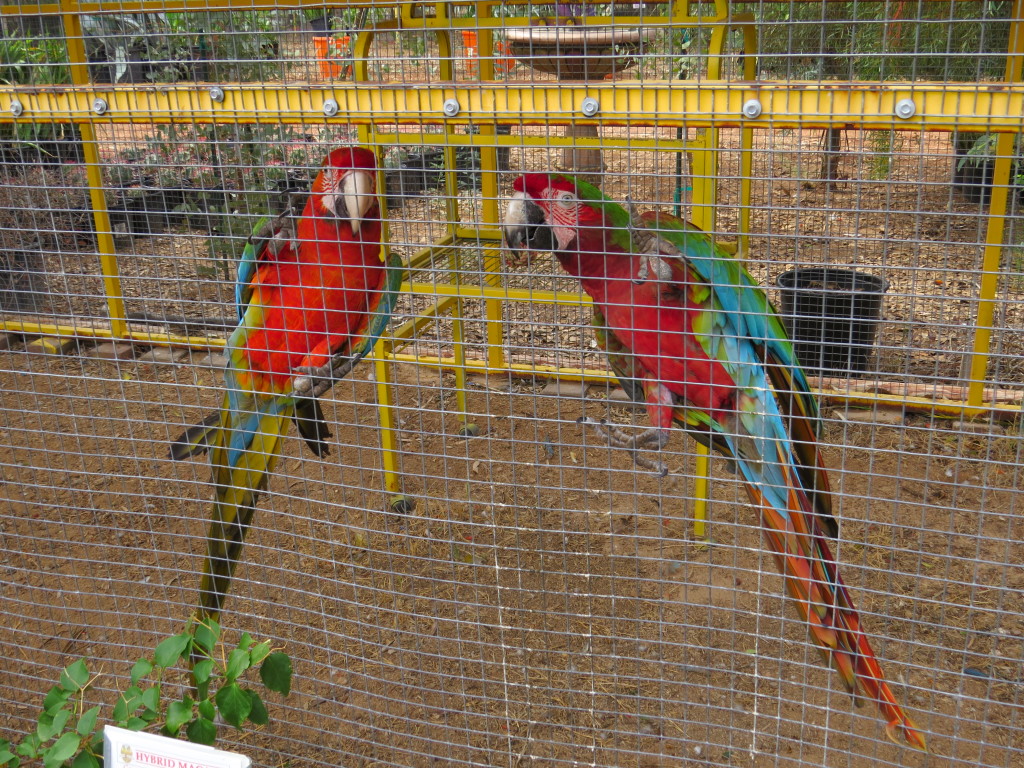 We also spent time playing in one of the most impressive rain storms I have seen, in Arizona no less.
We also spent time playing in one of the most impressive rain storms I have seen, in Arizona no less.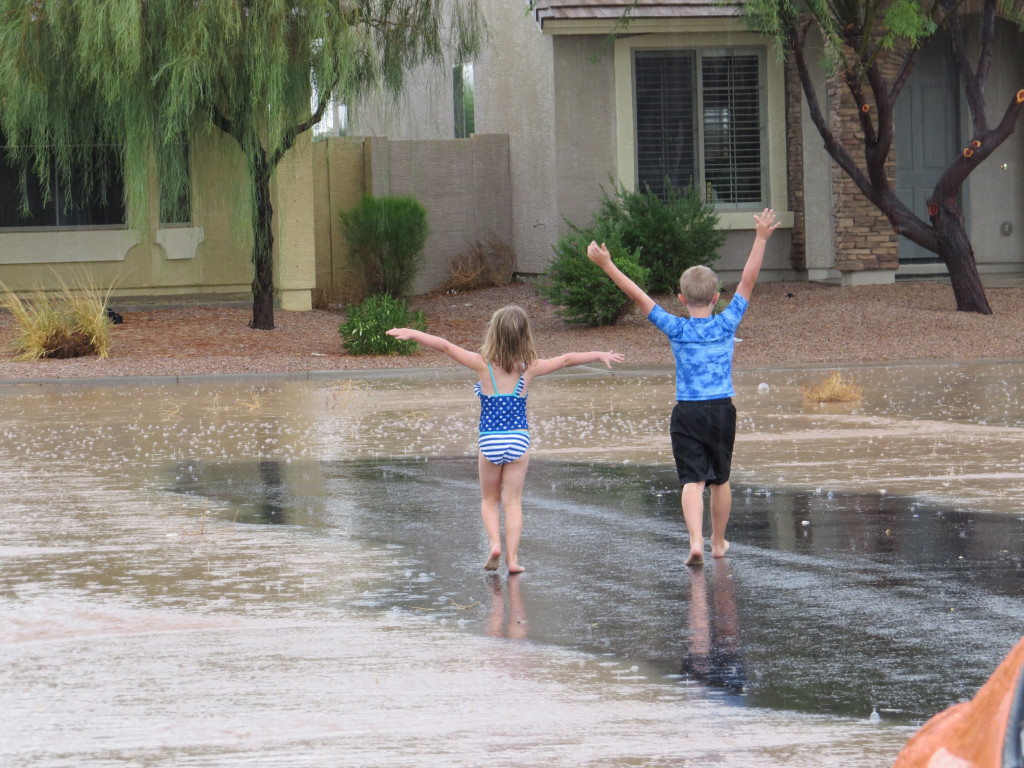
 Some children were not as enthused about the deluge and were downright grumpy.
Some children were not as enthused about the deluge and were downright grumpy.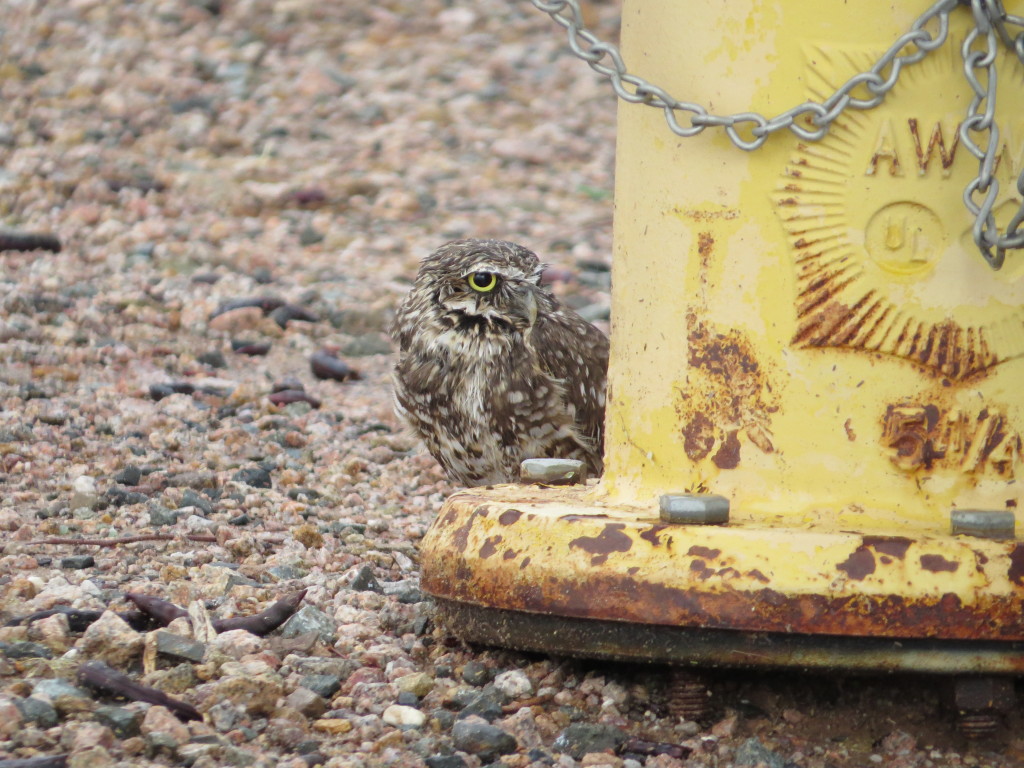
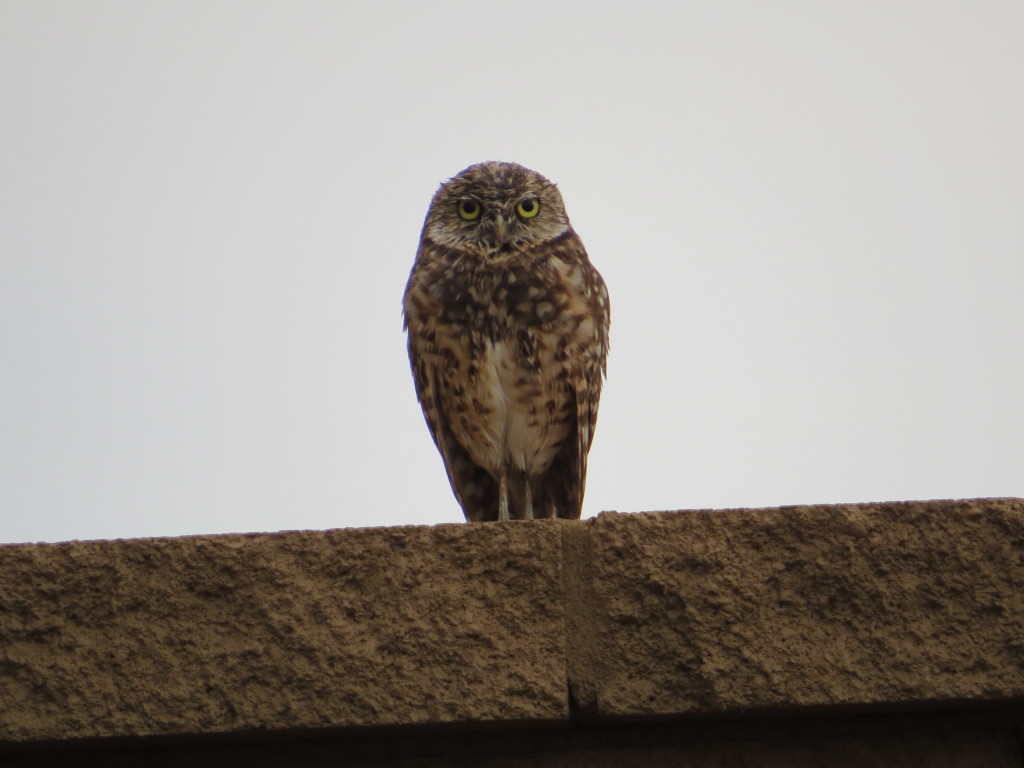 Another AZ trip is on record, full of many new birds and great memories. It’s time get back to MN though with some good winter owling. Stick around, these posts will be coming out fast.
Another AZ trip is on record, full of many new birds and great memories. It’s time get back to MN though with some good winter owling. Stick around, these posts will be coming out fast.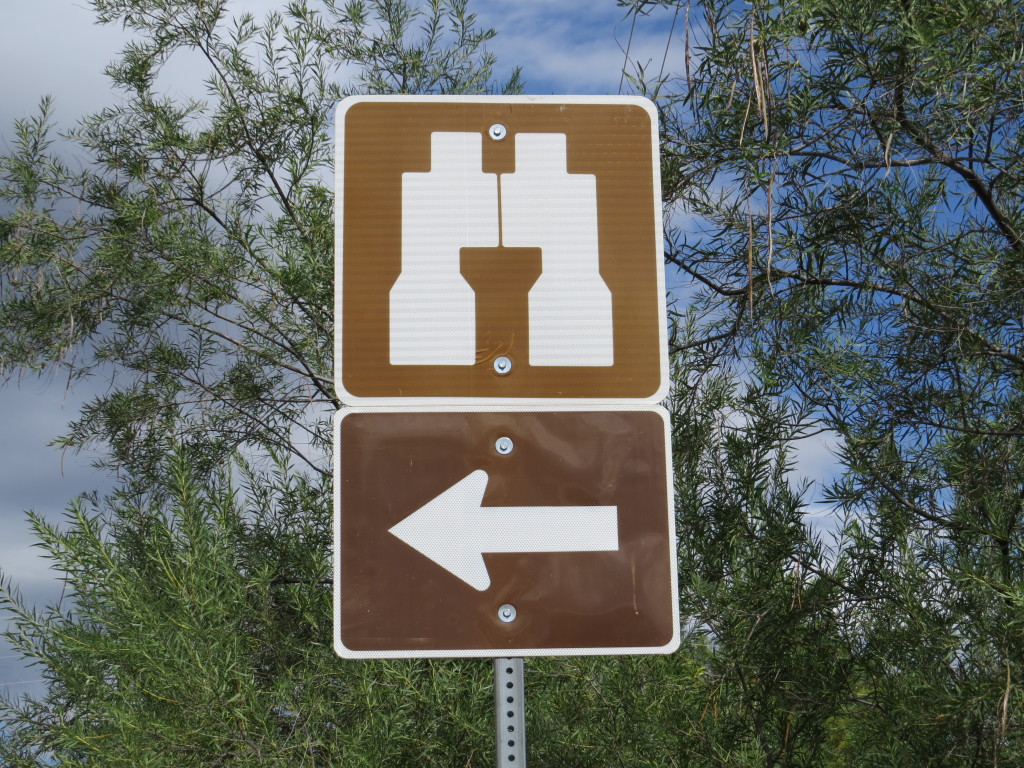
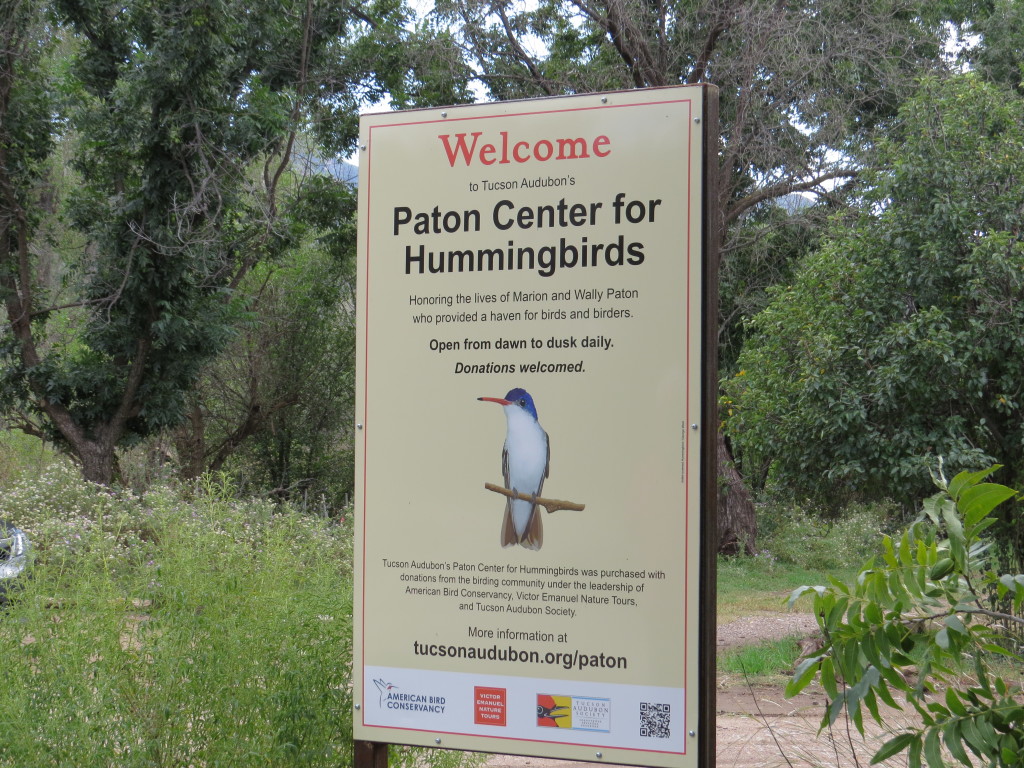 The famous Paton House–hard to believe I was actually here.
The famous Paton House–hard to believe I was actually here.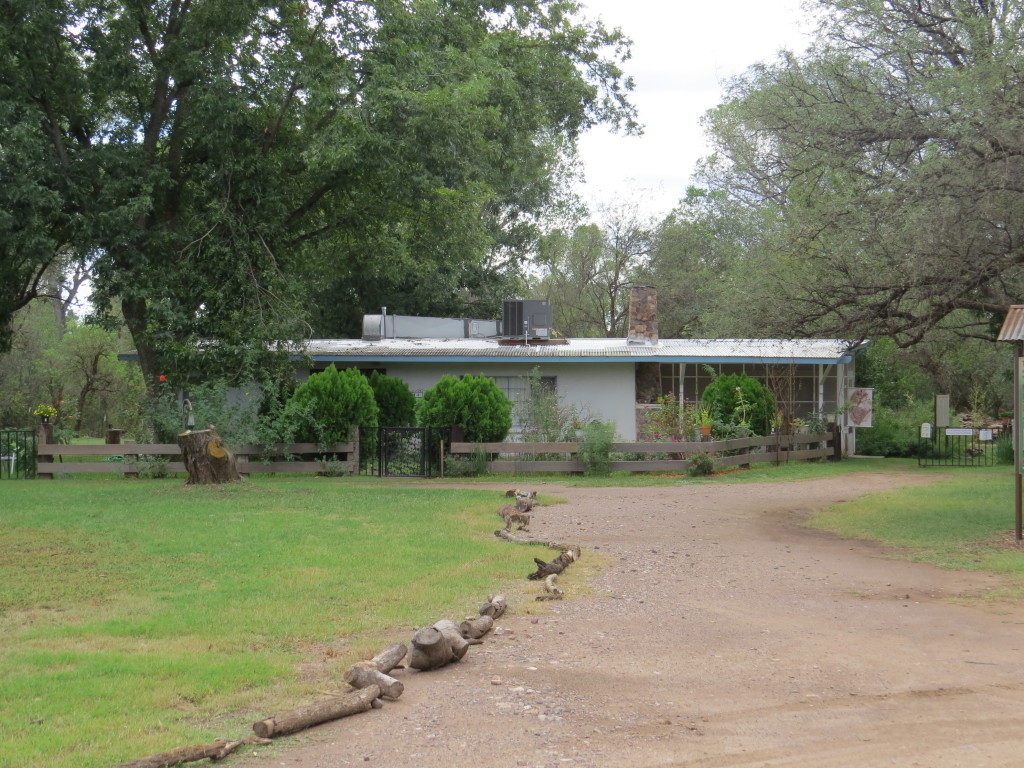 No, we didn’t come for the common White-winged Doves, though they were dapper and only the second time we’d seen one.
No, we didn’t come for the common White-winged Doves, though they were dapper and only the second time we’d seen one.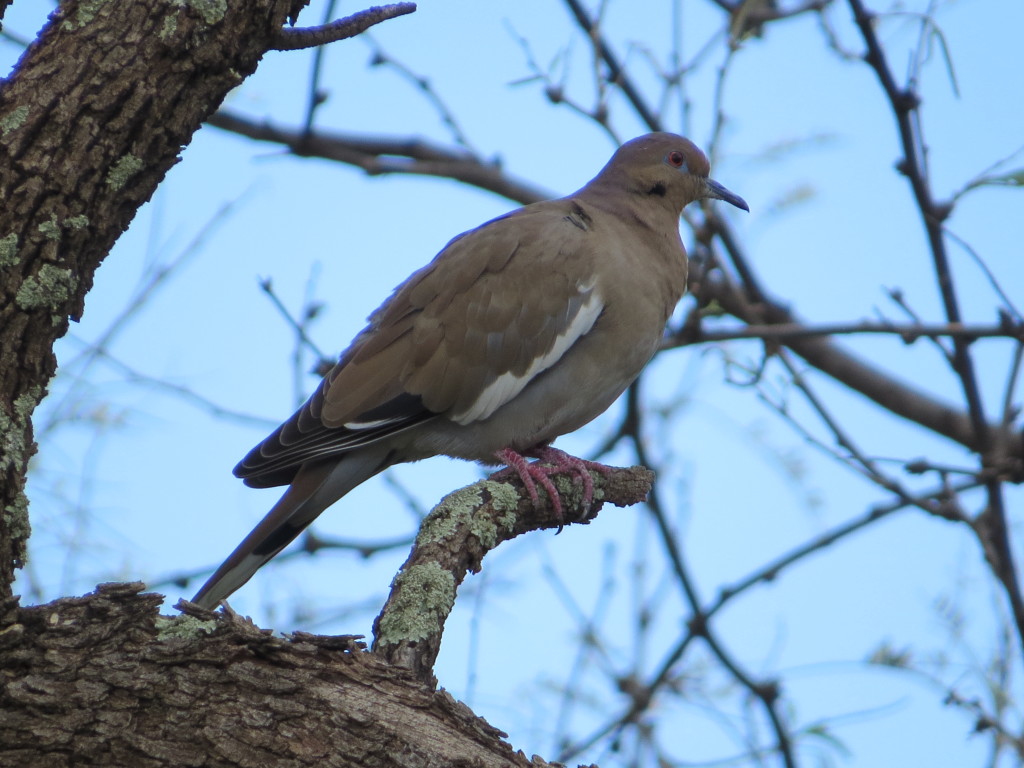 Nor did we come for the WWDO’s cousin, the much less abiding Inca Dove.
Nor did we come for the WWDO’s cousin, the much less abiding Inca Dove.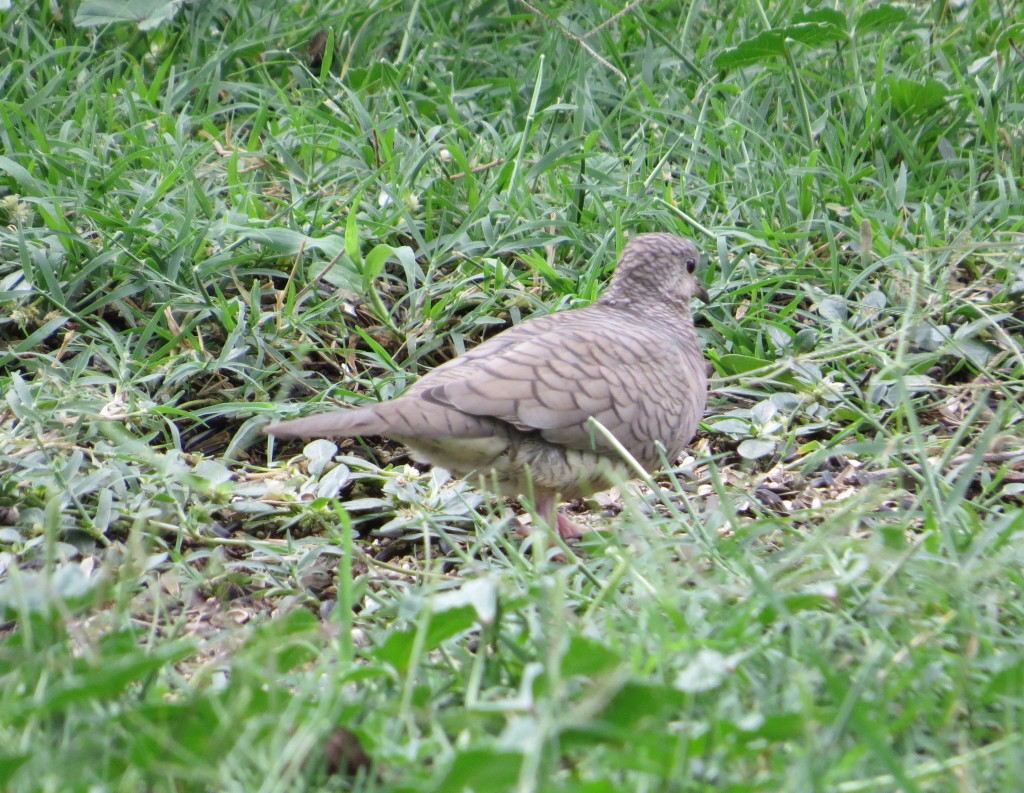 It was nice to see a Black-headed Grosbeak even if it was a bit scruffy looking, but that’s still not why we came.
It was nice to see a Black-headed Grosbeak even if it was a bit scruffy looking, but that’s still not why we came.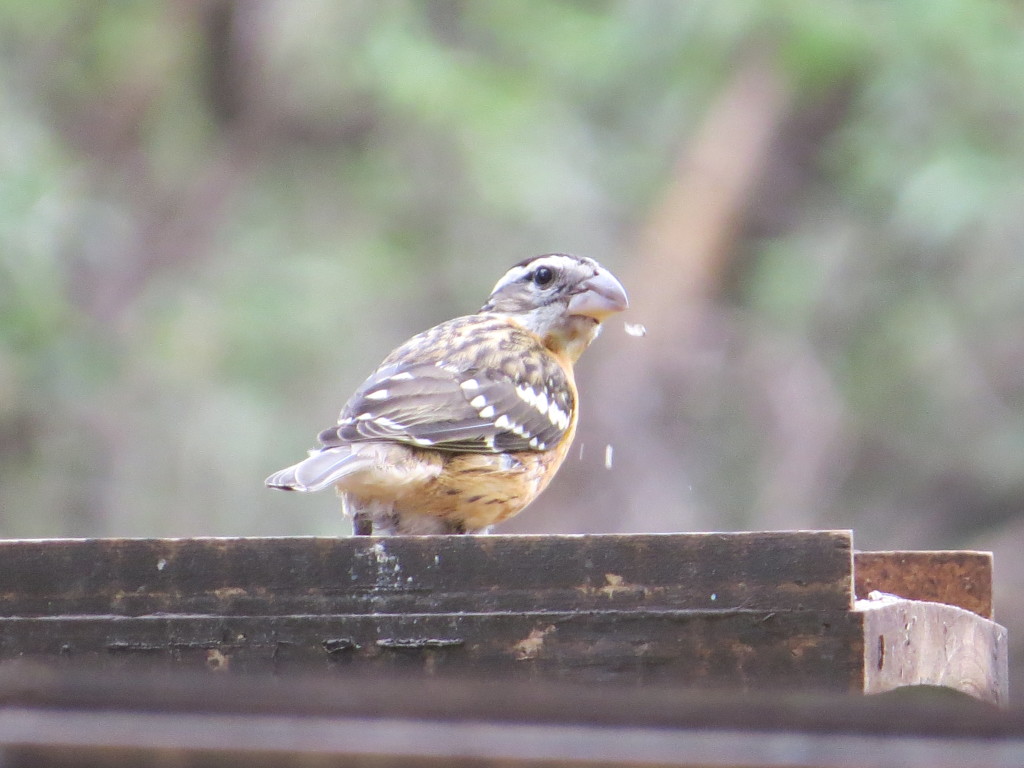
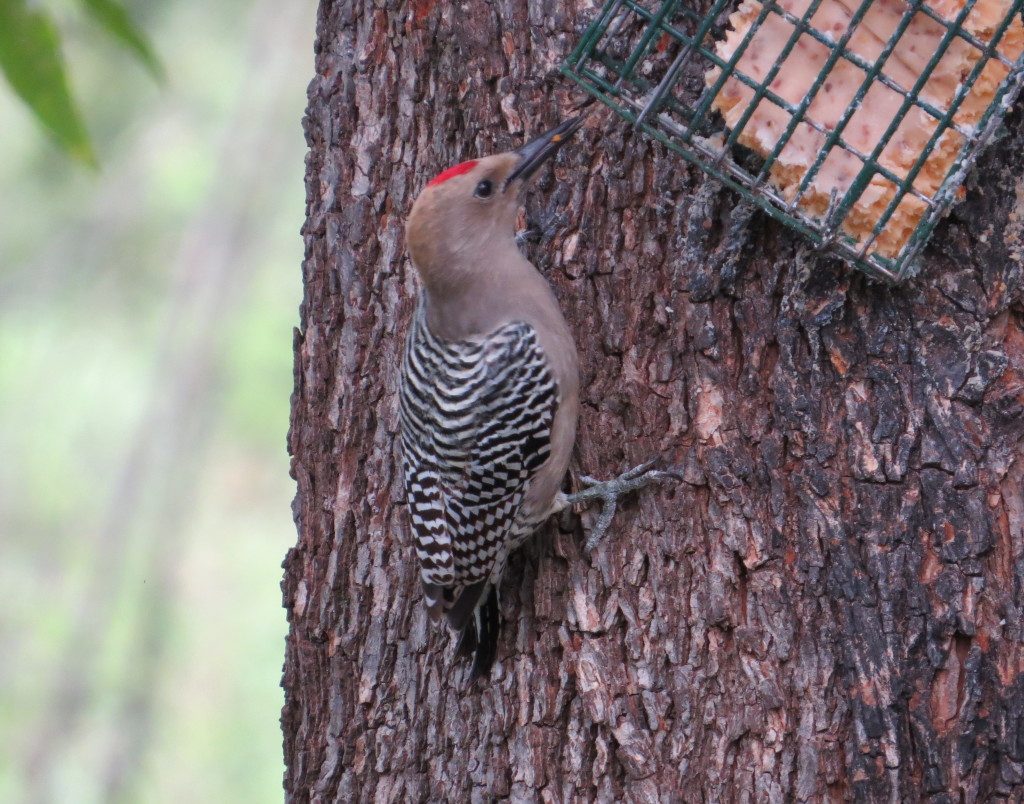 We came for the Hummingbirds. But not for the Broad-billed.
We came for the Hummingbirds. But not for the Broad-billed.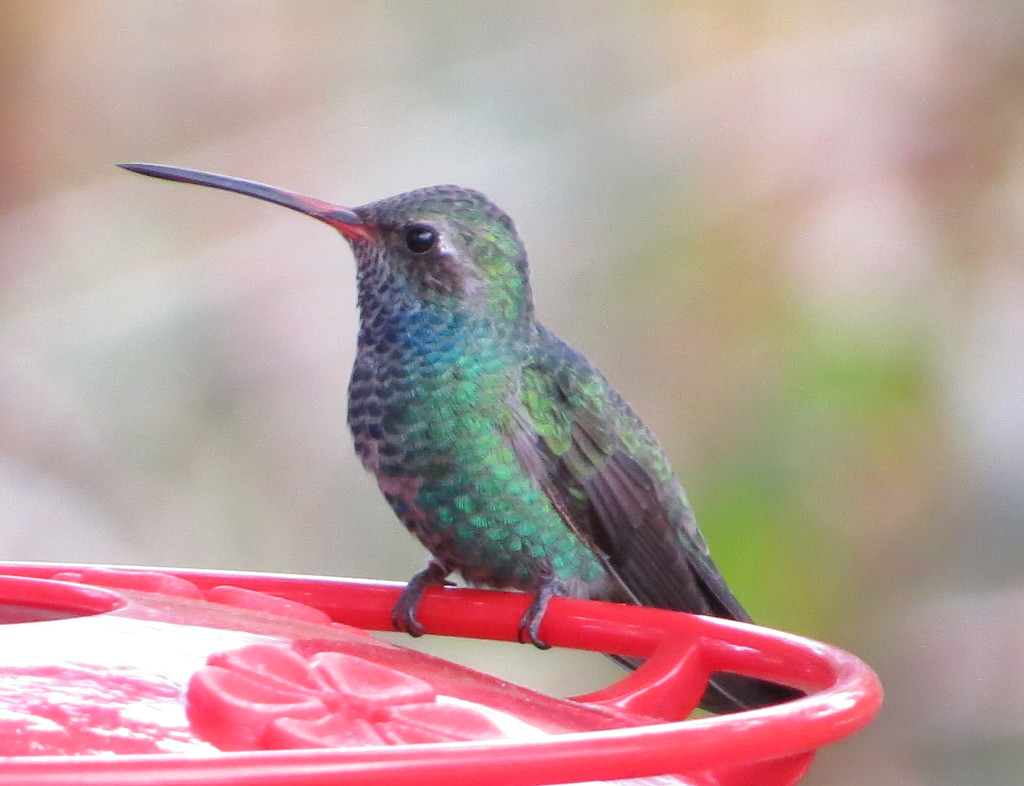
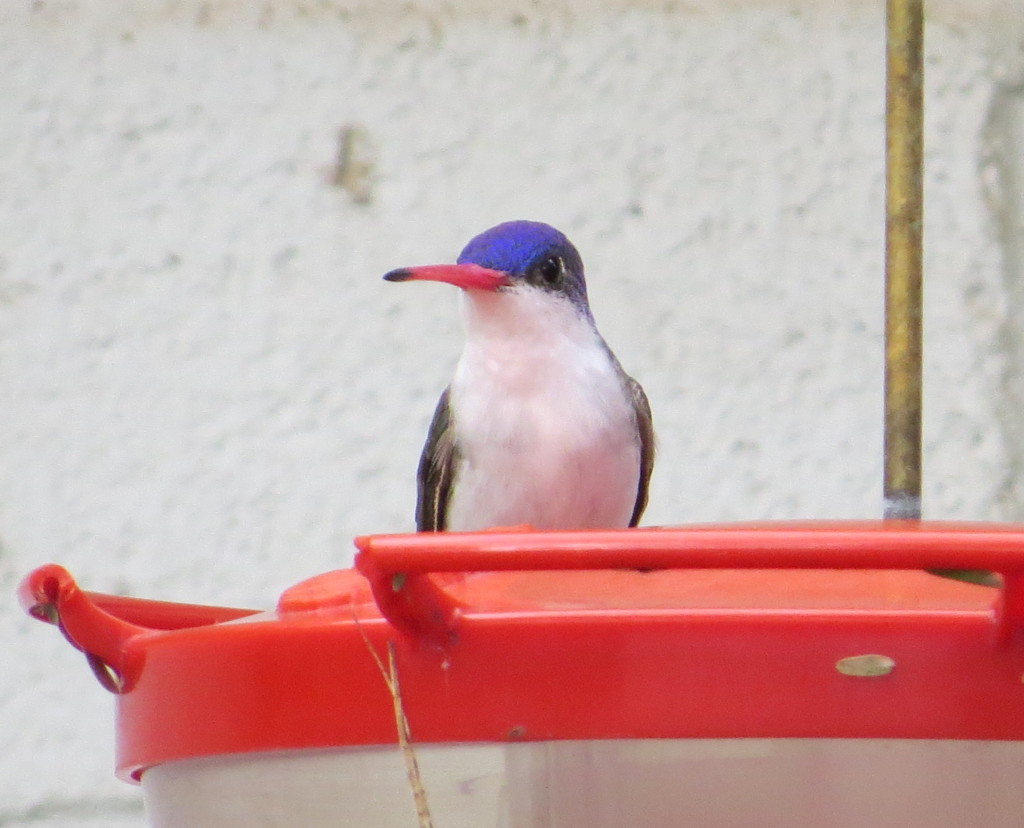 Ain’t it a beaut?
Ain’t it a beaut?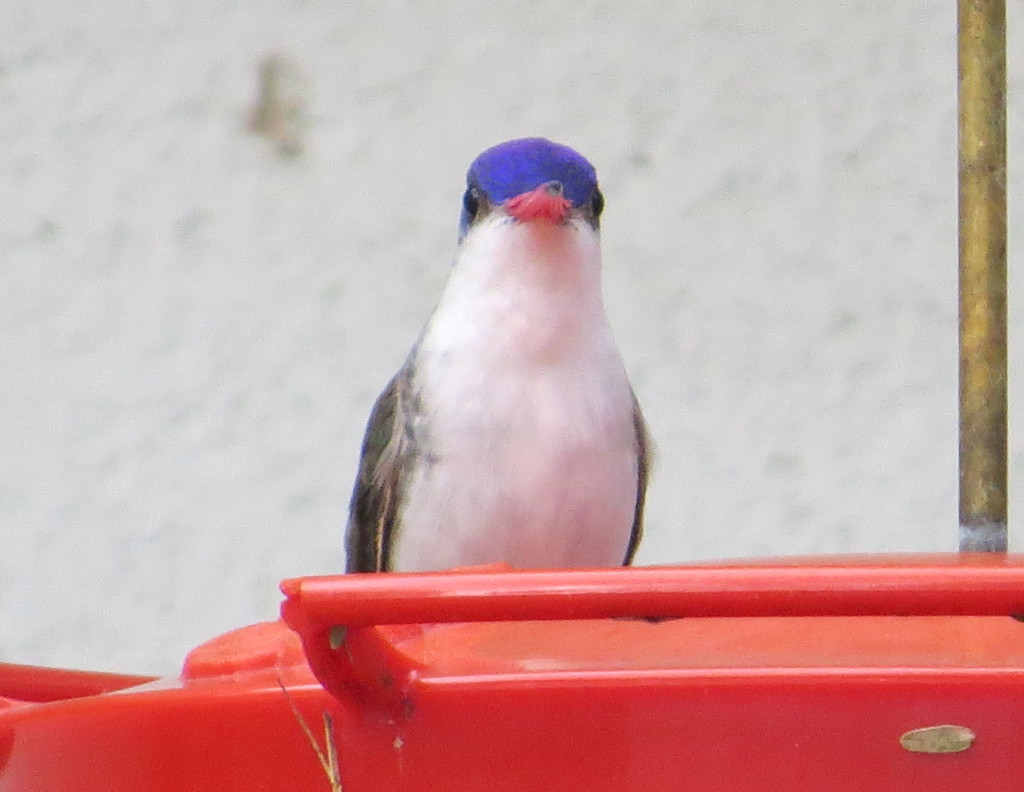 It knows it too. Like Orcas or Dolphins, it pandered to its gawking audience.
It knows it too. Like Orcas or Dolphins, it pandered to its gawking audience.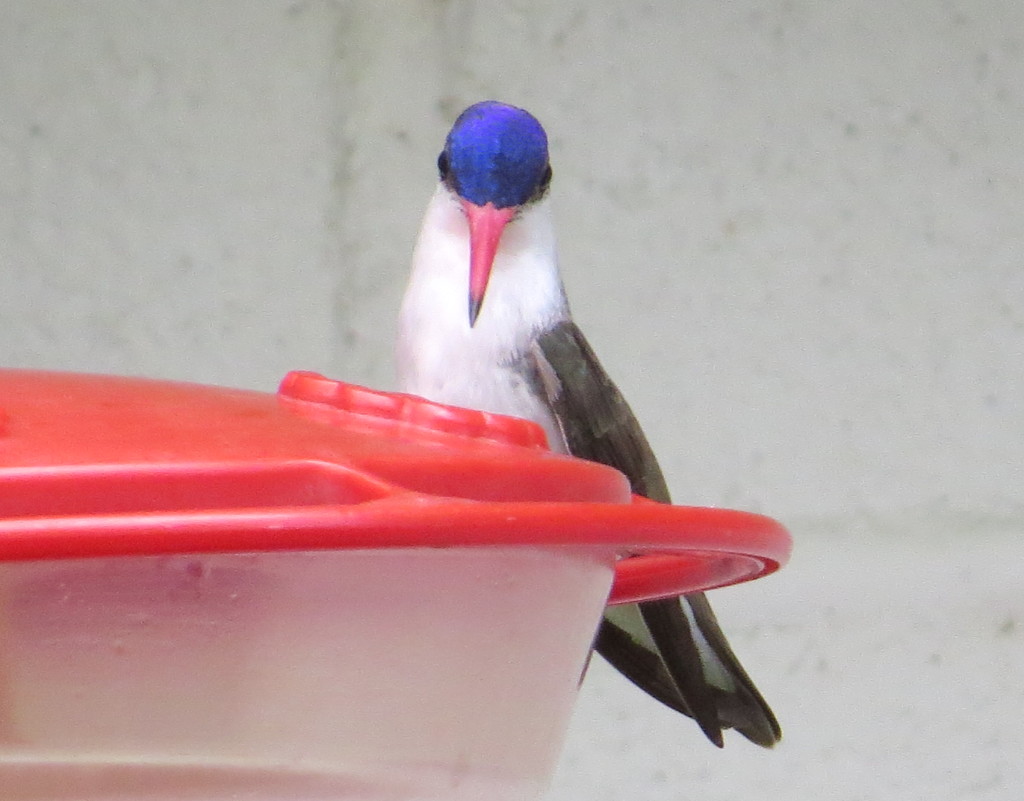 So that was that. Tommy DeBardeleben and Gordon Karre had told me about a much rarer Hummer, the Plain-capped Starthroat, that had been seen regularly somewhere in Patagonia. Not knowing exactly where to go for it and not feeling I could make yet another birding stop with the non-birding family, I didn’t even bother to check into it.
So that was that. Tommy DeBardeleben and Gordon Karre had told me about a much rarer Hummer, the Plain-capped Starthroat, that had been seen regularly somewhere in Patagonia. Not knowing exactly where to go for it and not feeling I could make yet another birding stop with the non-birding family, I didn’t even bother to check into it.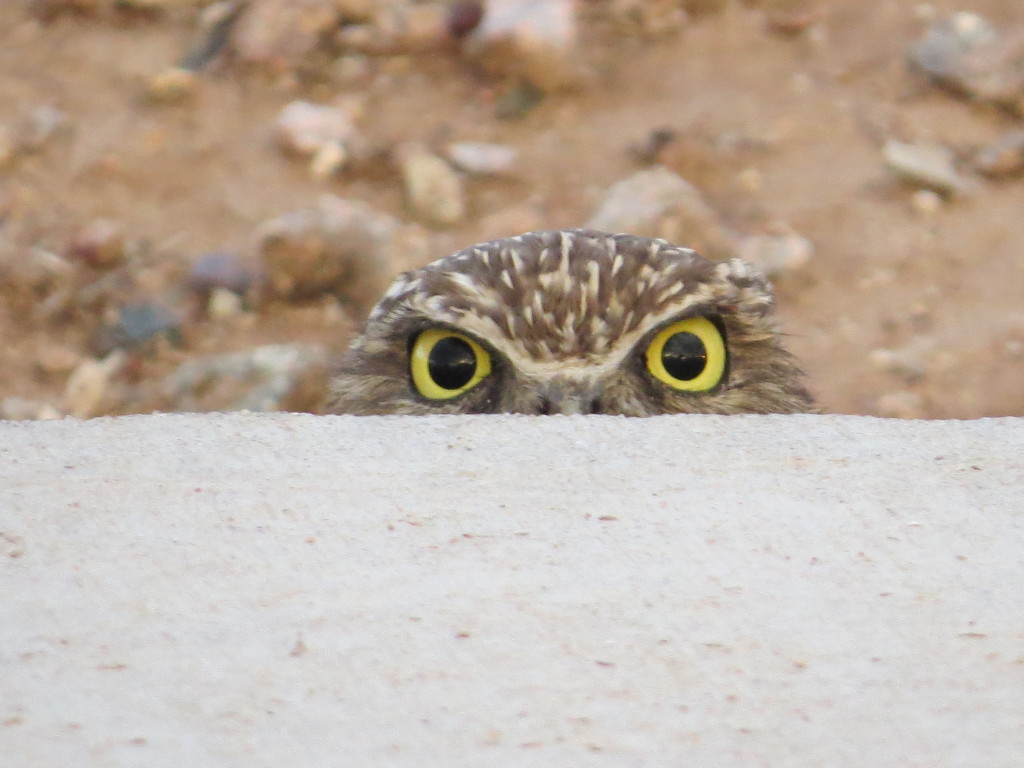 Scanning a residential pond in the low light of the evening, I was excited to see the brilliant pop of color of the male Vermilion Flycatcher in my binoculars. They never get old.
Scanning a residential pond in the low light of the evening, I was excited to see the brilliant pop of color of the male Vermilion Flycatcher in my binoculars. They never get old.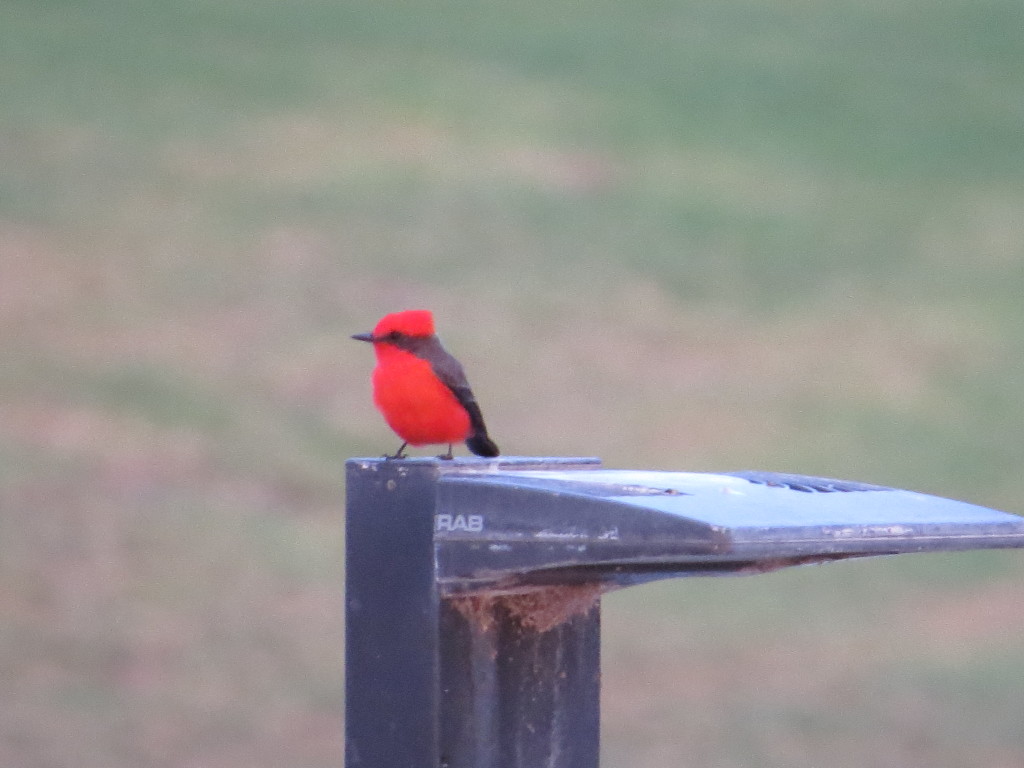 We also saw a Jackrabbit of some sort which was a cool experience.
We also saw a Jackrabbit of some sort which was a cool experience.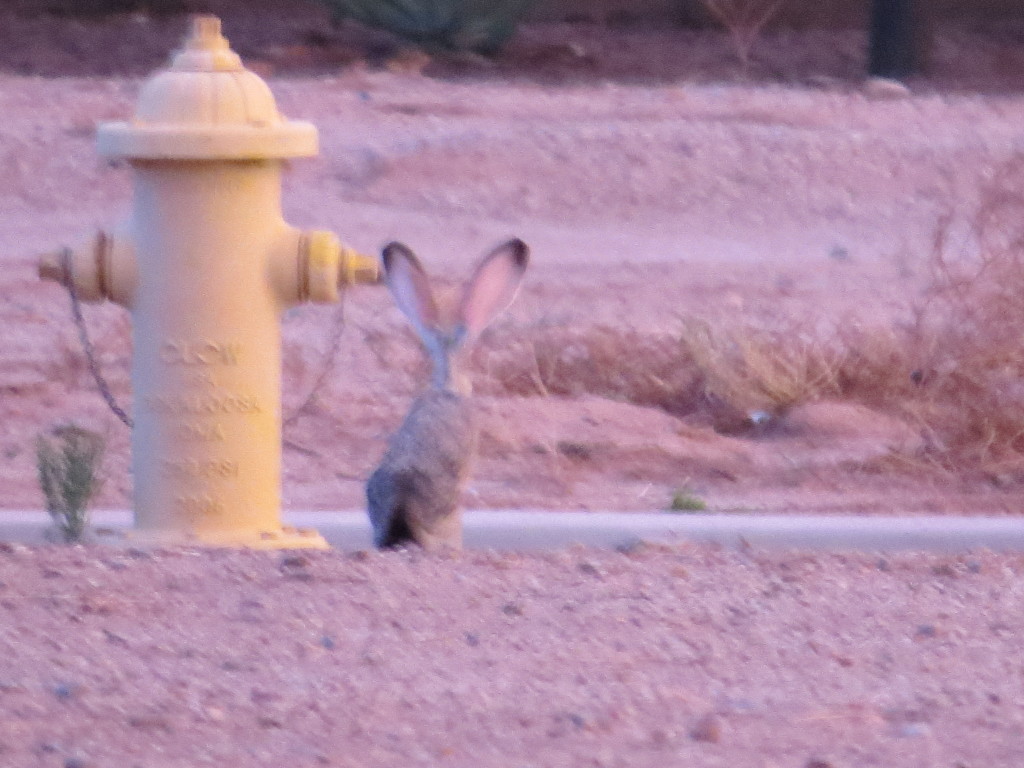 The Arizona fun isn’t over. Next up is the final post and arguably the ugliest and cutest birds you will see.
The Arizona fun isn’t over. Next up is the final post and arguably the ugliest and cutest birds you will see.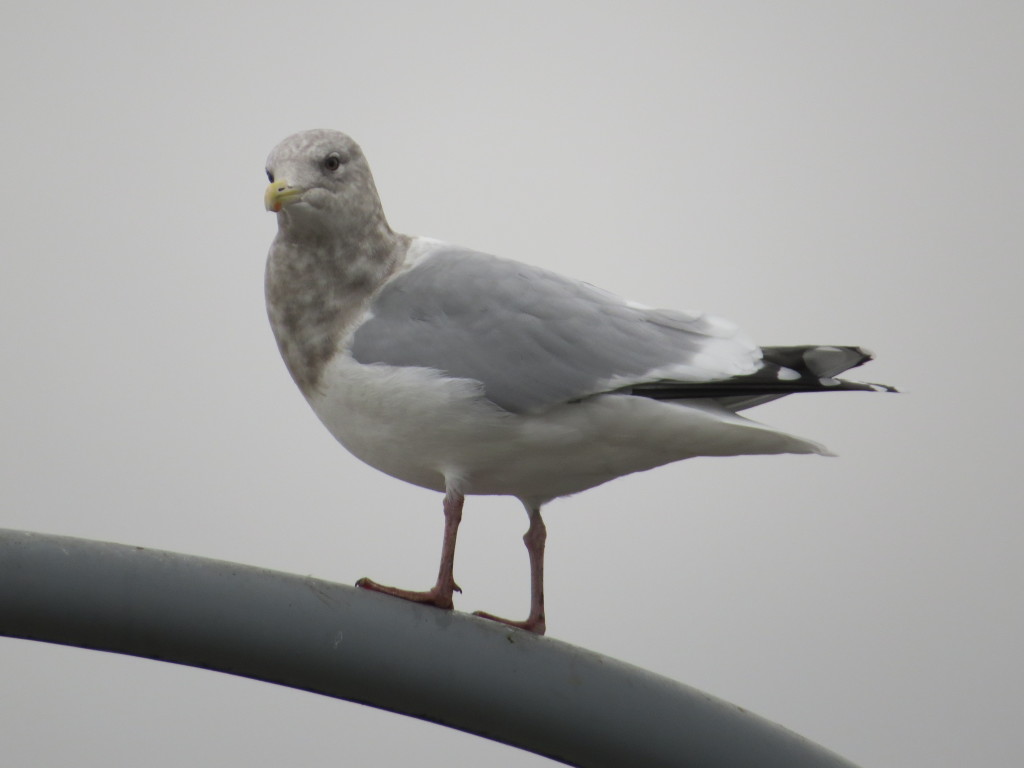
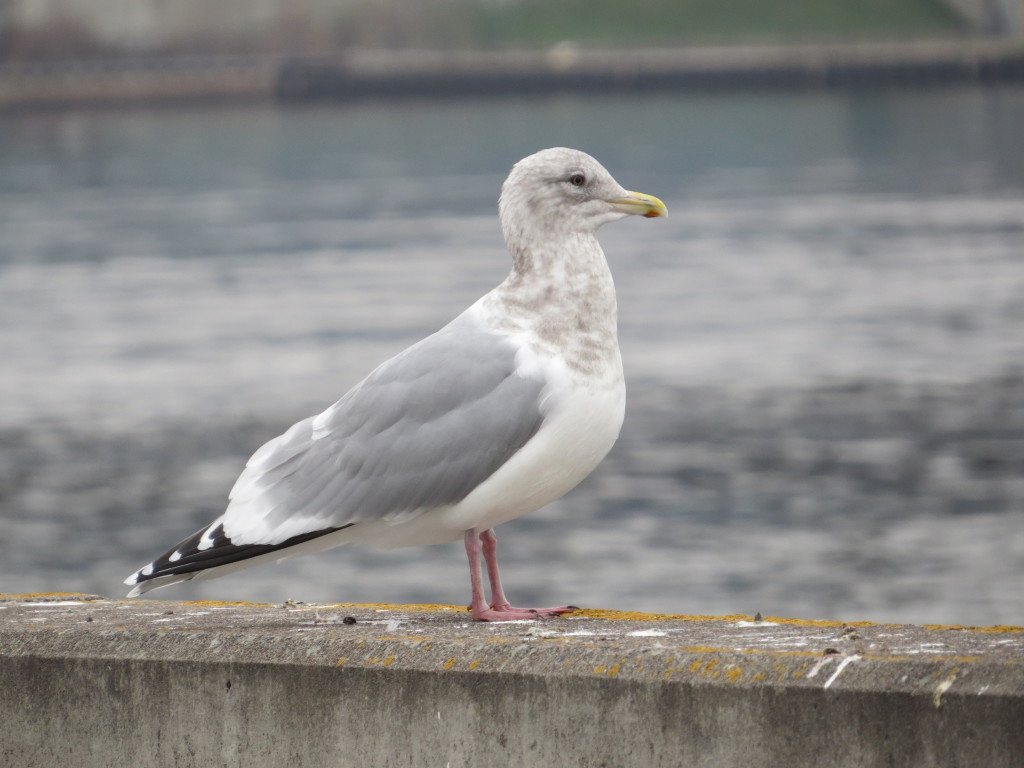
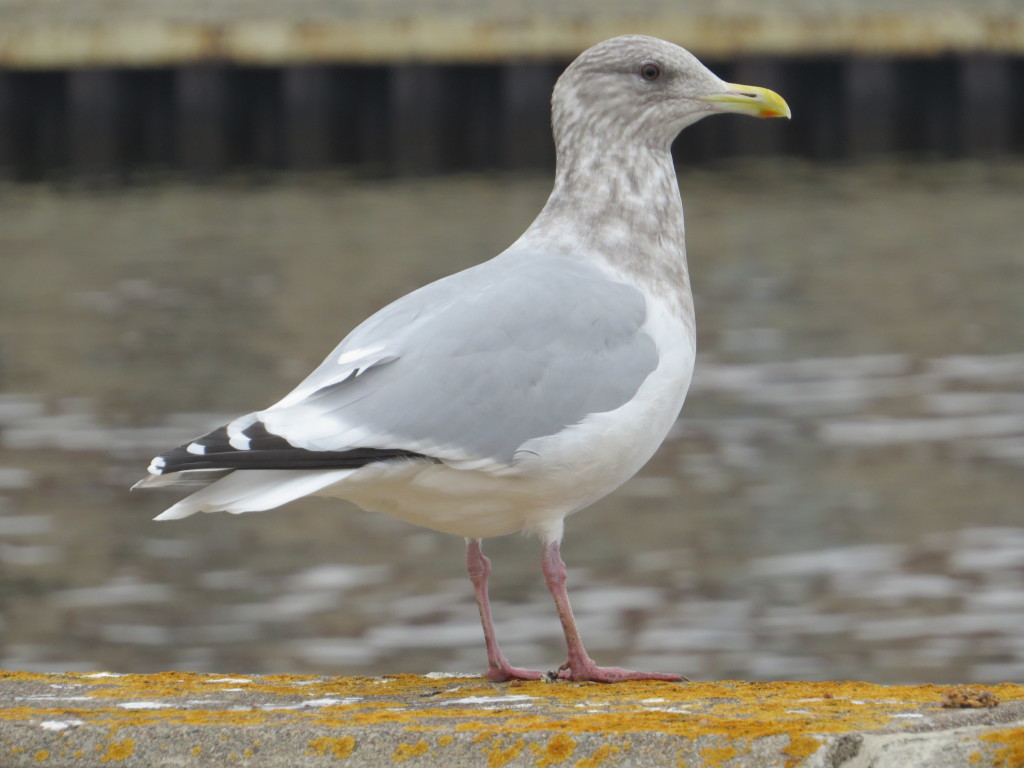
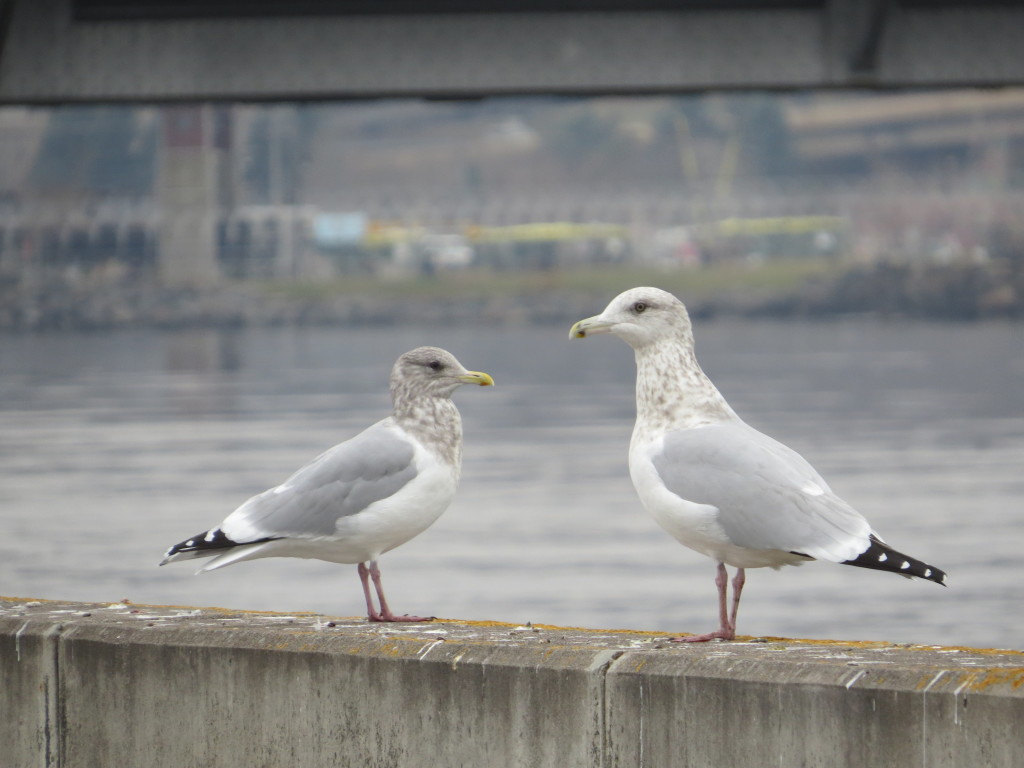 Gull identification is hard, especially if one is only looking at pictures or studying field guides. Learning them from books is even kind of boring which I proved by falling asleep one night studying Gulls in Sibley. To study Gulls and get to know them, one must learn Gulls through immersion–get yourself up close and in person among the Gulls and go with someone who knows more about the Gulls than you do. Though I didn’t add any lifers on this try, my confidence and excitement for Gulling increased under the tutelage of John.
Gull identification is hard, especially if one is only looking at pictures or studying field guides. Learning them from books is even kind of boring which I proved by falling asleep one night studying Gulls in Sibley. To study Gulls and get to know them, one must learn Gulls through immersion–get yourself up close and in person among the Gulls and go with someone who knows more about the Gulls than you do. Though I didn’t add any lifers on this try, my confidence and excitement for Gulling increased under the tutelage of John.
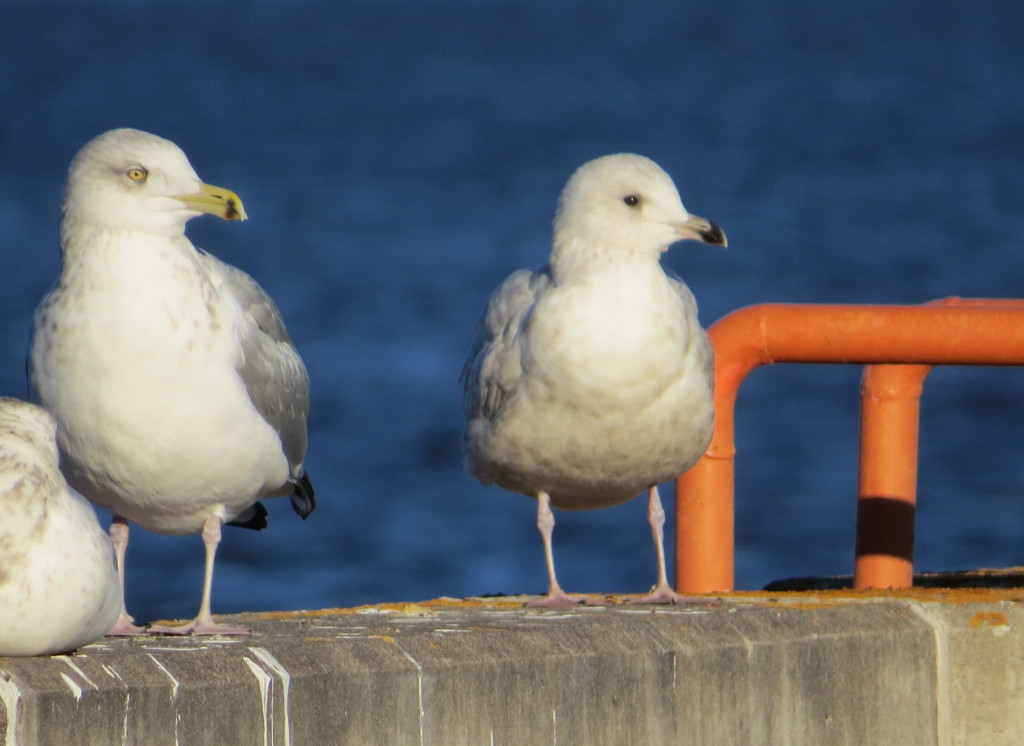
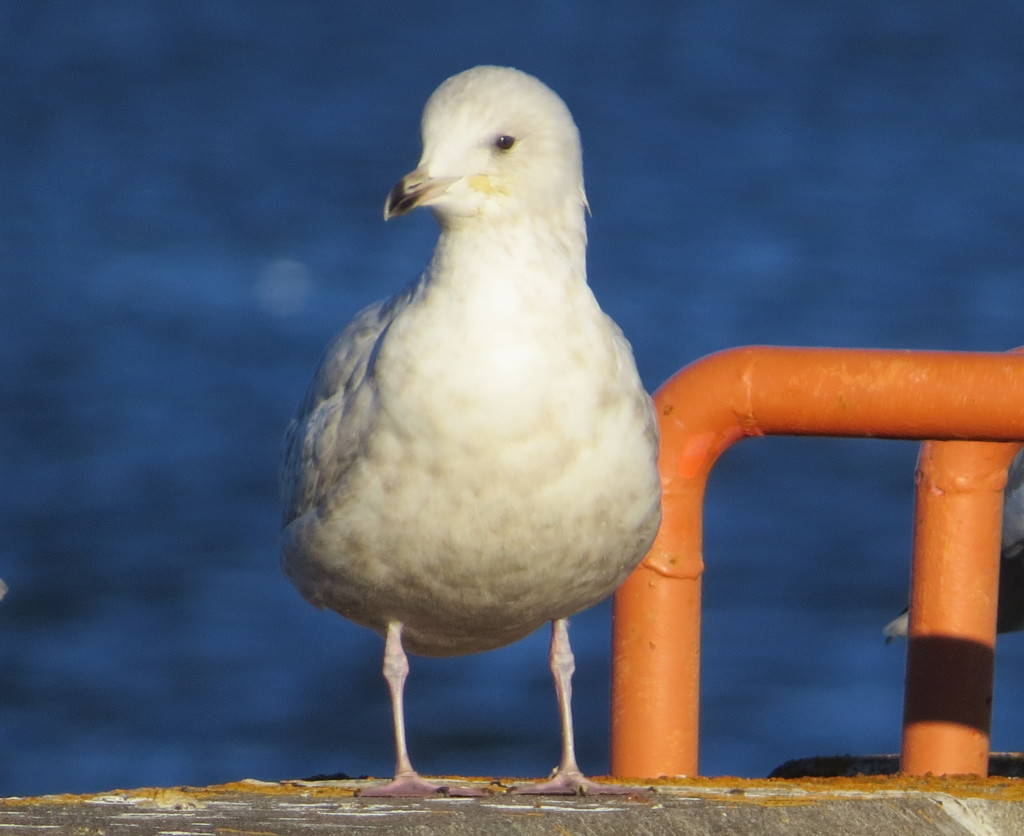 The Iceland was cool, but I was really itching to make my way to that Great Black-backed for some photos. But, you don’t rush down the pier and get out in front of a birding Jedi like Peder Svingen. Patience, young Skywalker. Many Gulls to go through have you.
The Iceland was cool, but I was really itching to make my way to that Great Black-backed for some photos. But, you don’t rush down the pier and get out in front of a birding Jedi like Peder Svingen. Patience, young Skywalker. Many Gulls to go through have you. While I waited, a Thayer’s was begging to be crushed.
While I waited, a Thayer’s was begging to be crushed.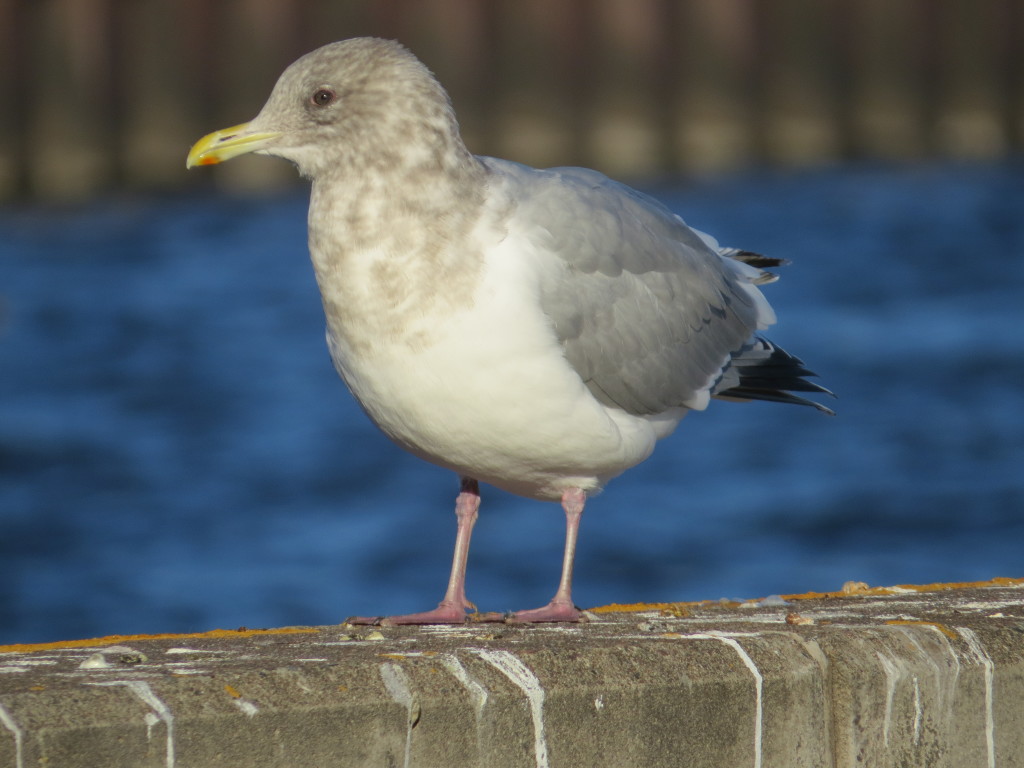
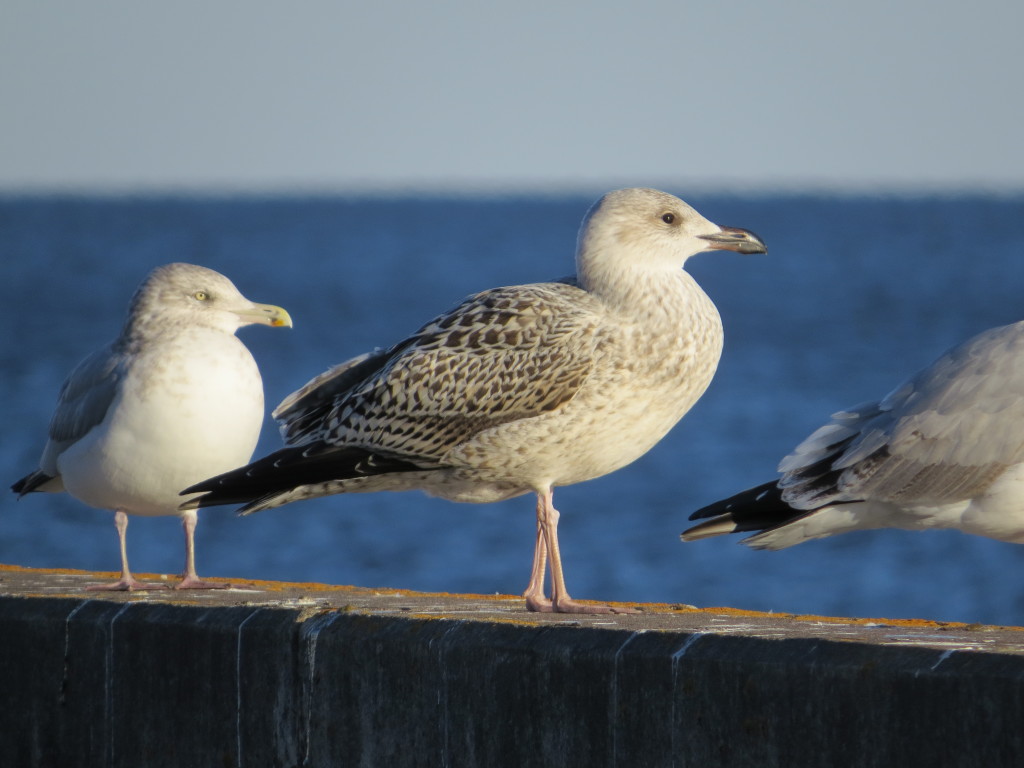 I love how this HEGU is checking him out.
I love how this HEGU is checking him out.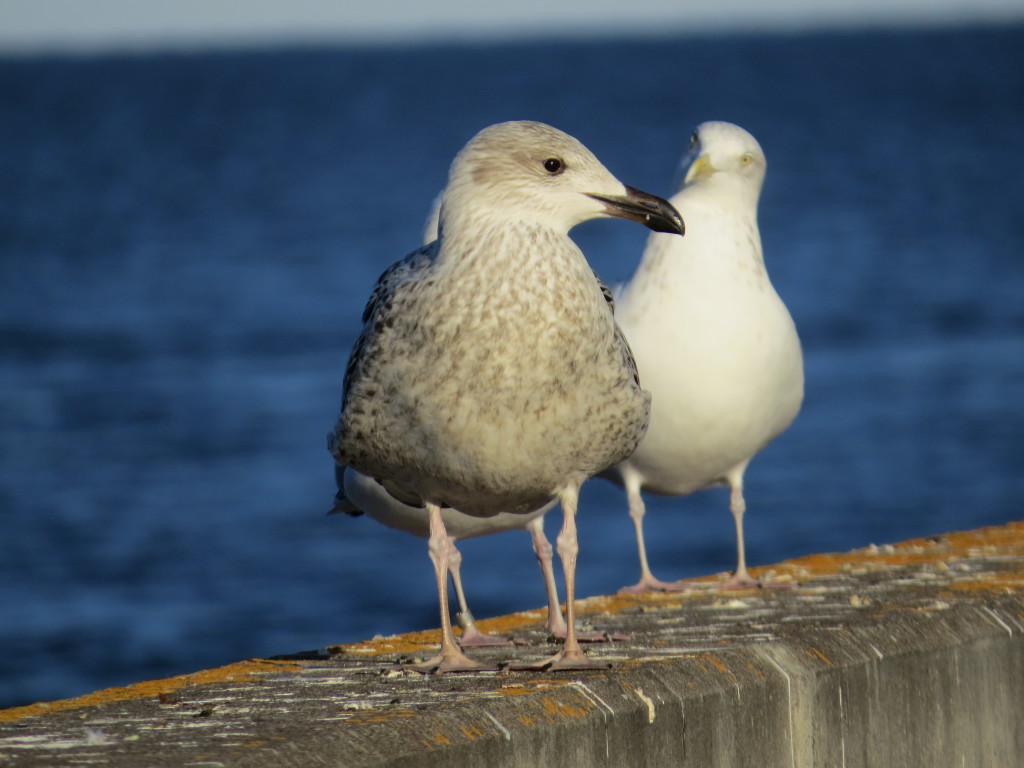
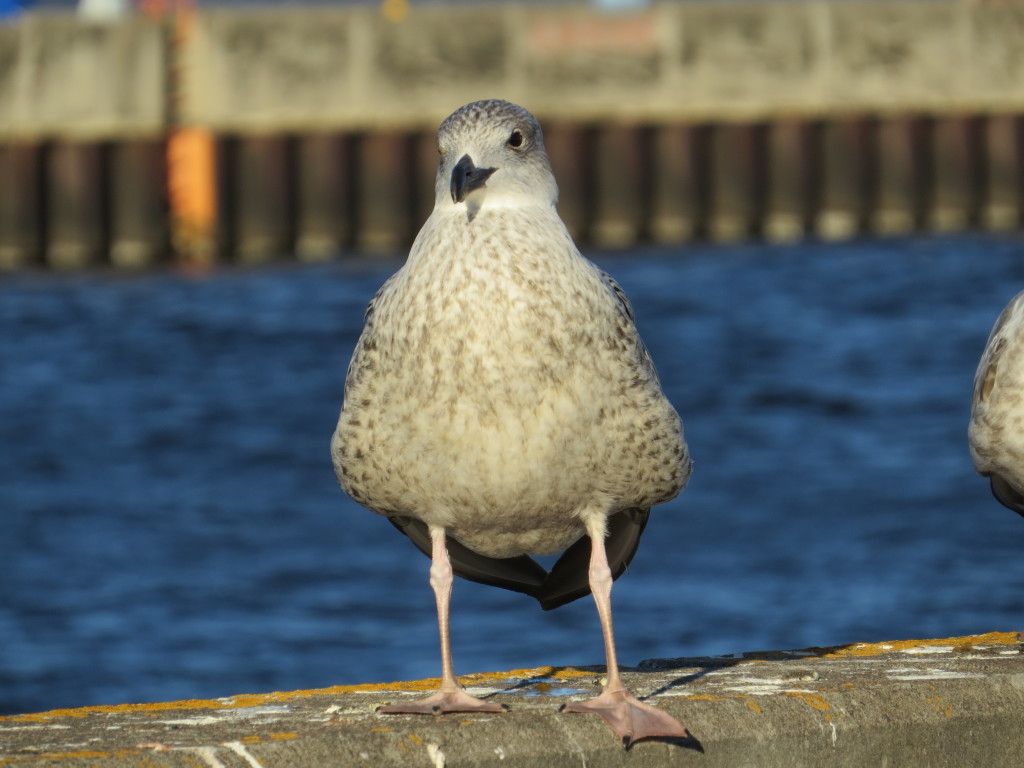 The Great Black-backed Gull is the largest of the Gulls; it dwarfs the Herring Gulls.
The Great Black-backed Gull is the largest of the Gulls; it dwarfs the Herring Gulls.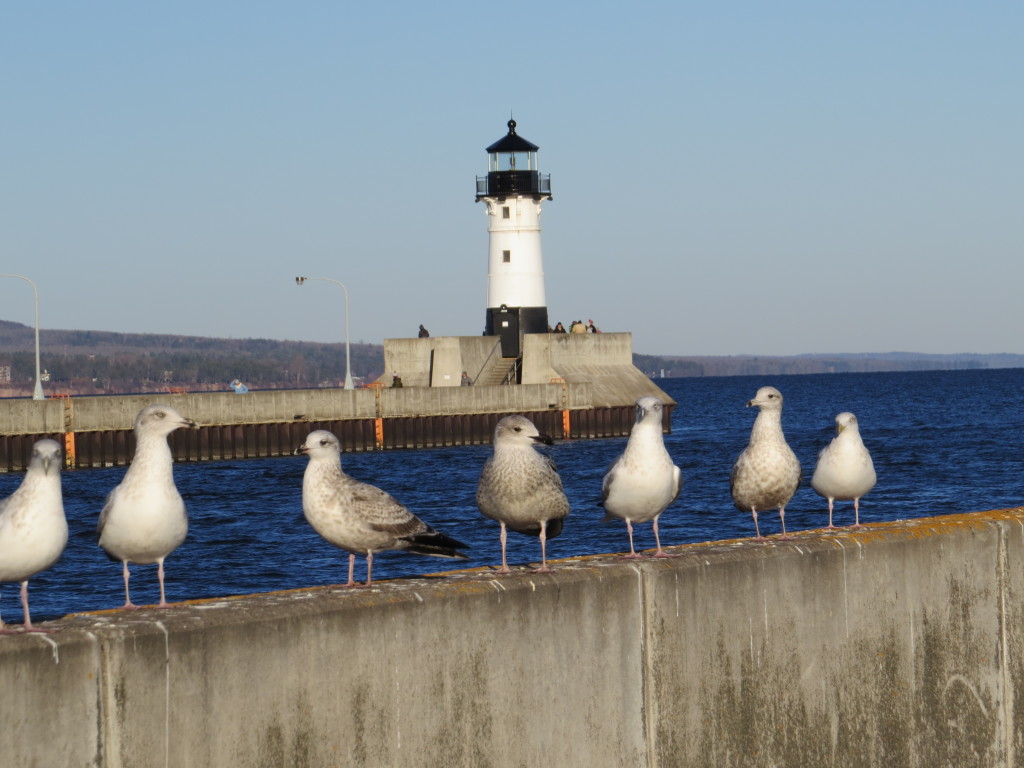
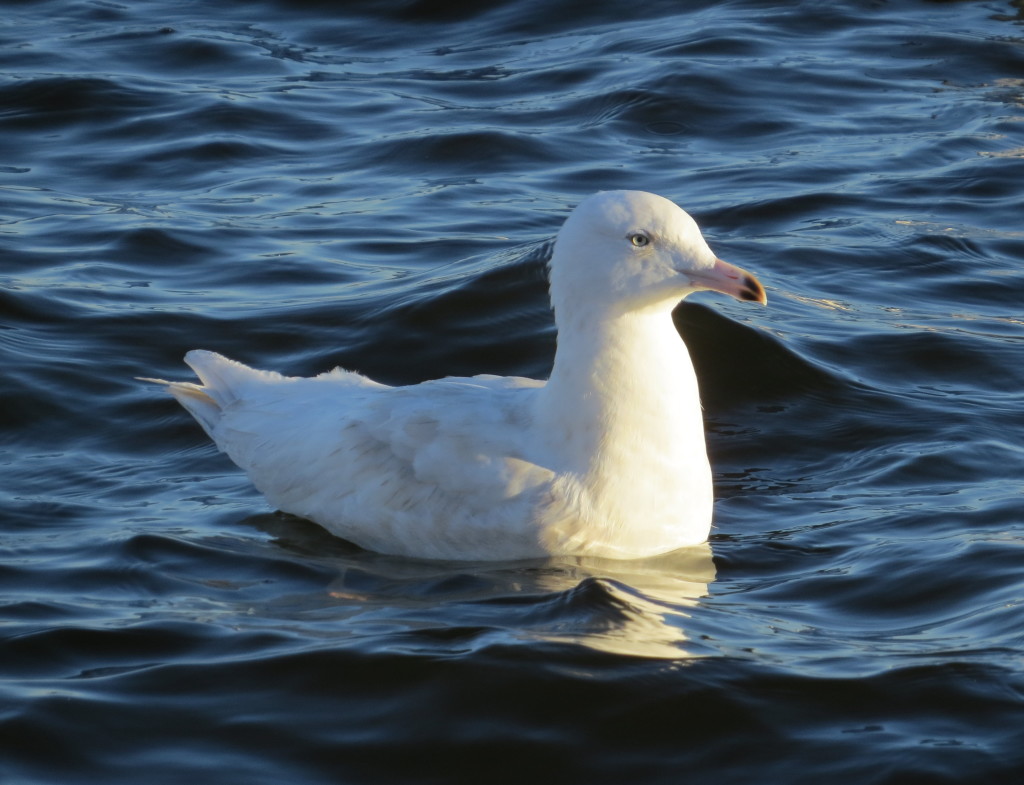
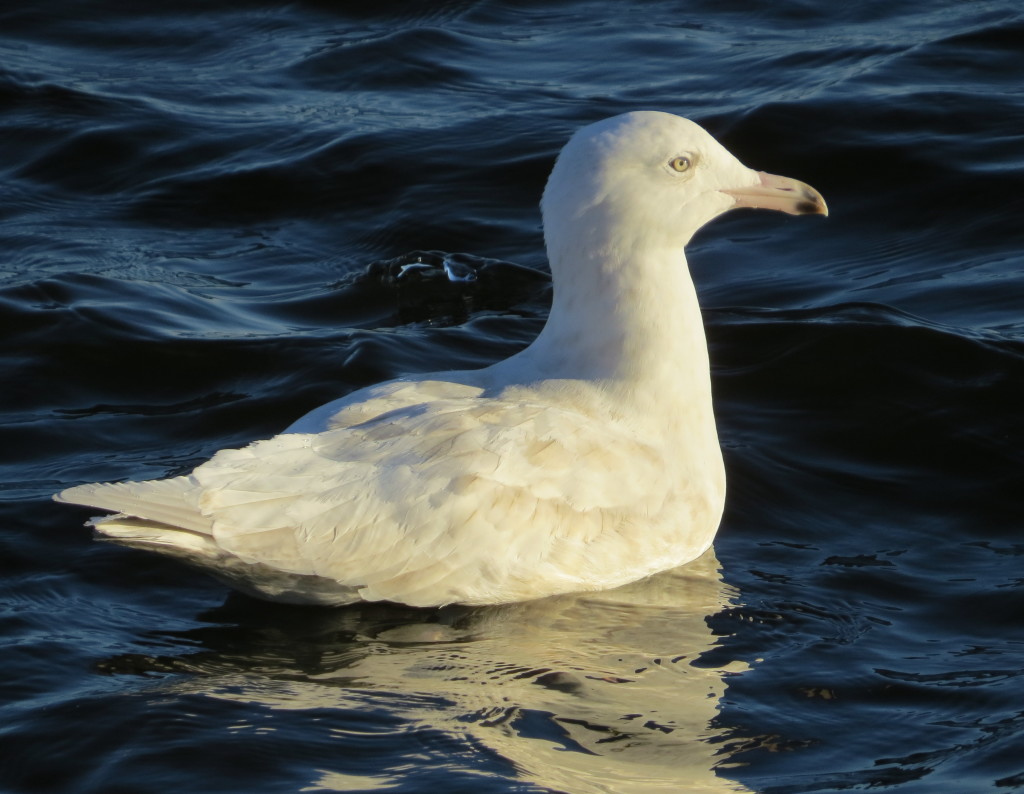 With the Glacous, I now had all three hoped-for lifers and got all my northern Gulls in one tidy outing. The only thing left to do was to photograph my favorite of the three lifers, the adult Great Black-backed Gull, a stand-out bird.
With the Glacous, I now had all three hoped-for lifers and got all my northern Gulls in one tidy outing. The only thing left to do was to photograph my favorite of the three lifers, the adult Great Black-backed Gull, a stand-out bird.